

13 Best Small Catamarans For Cruising 2024
The best small catamarans for cruising are affordable and comfortable, making great sailboats for a number of different purposes. If you’re looking for the best small catamarans to start your cruising life then look no further!
When searching for a catamaran for our adventures we scoured the internet for any and all information we could find on just about every size, shape, and model!
Although in the end, we opted for a bigger catamaran, in the hopes of having more family and friends on board, we did heavily research the best small catamarans as an option.
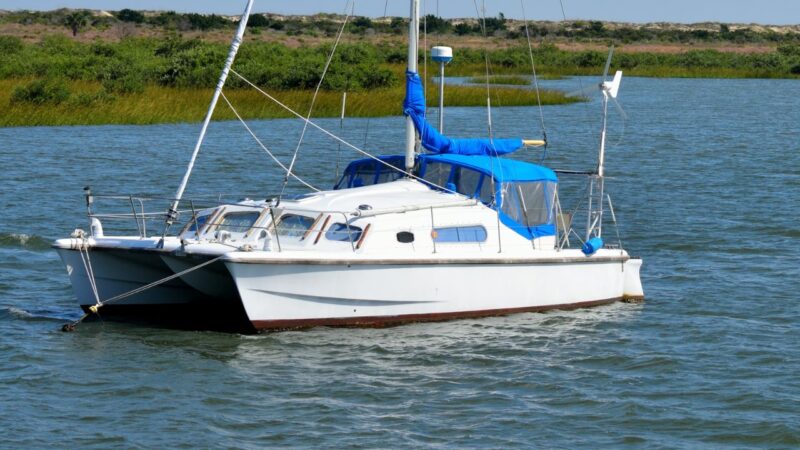
Each small catamaran has different pros and cons. As with every sailboat, there will be compromises, but hopefully, this post will help you firm up what you’re really looking for in a multihull and find the right smaller catamaran for you!
Here are what we consider the best small cruising catamarans out there, costing anywhere from $40,000 to $300,000. You can also read up on the average costs of sailboats here.
Why choose a small catamaran for cruising?
The downsides to small multihulls for cruisers
The best small catamarans for ocean sailing
The best small catamarans for coastal cruising
Why Choose A Small Catamaran For Cruising?

The main advantage to choosing a small catamaran for cruising has to be the cost. Not only are smaller sailboats cheaper to buy initially, but they are also cheaper to maintain and to dock in marinas or dry storage.
Why buy a small catamaran over a monohull? This isn’t the post to go into the pros and cons of multihulls vs monohulls, but a few of the main reasons you might prefer to buy a small cat over a bigger, cheaper monohull is the living space and the comfort underway and at anchor.
Living on a sailboat is very different from taking the boat out for a sporty sail every now and again. Having a catamaran over a monohull means you won’t be heeling or rolling at anchor half as much, you can leave out your coffee cup, and you have the space you need to spread out a little.
A small catamaran will enable the more comfortable lifestyle you’re seeking at a more reasonable price tag. So what’s not to love about small cruising multihulls?
The Downsides To Small Multihulls For Cruisers

Of course, just with everything in sailing, there are always compromises to be made when it comes to small multihulls.
One of the biggest downsides for cruisers is the weight issue smaller catamarans present. You won’t be able to carry half as much as you would on a larger catamaran or monohull, which might be a problem if you live onboard full time.
The other negative is that smaller boats usually aren’t quite as seaworthy as larger ones. You might find you’re limited to coastal cruising if you choose a small catamaran, so make sure you have your cruising intentions in mind before you buy.

Another big thing to look out for when it comes to choosing the right small cat for you, is the bridge deck clearance. This is often worse on smaller catamarans, and can cause nasty slamming in any sort of sea, both when sailing and at anchor.
With these downsides in mind, we’ve split this post into the best small catamarans for ocean sailing and the best for coastal cruising. Obviously this is a little subjective, as many people have sailed around the world in much smaller and less seaworthy vessels!
The Best Small Catamarans For Ocean Cruising
#1 wharram tiki.
- Suitable for: Bluewater sailing
- Fixed Keels
- Draft (max): 2.08′
- Engines: Single outboard, though some versions have twin inboards
- Price: Roughly $100,000

We have lusted after the Wharram catamarans since our adventures began and would have opted for one of these if we had found one for sale this side of the pond.
Designed by the legendary James Wharram, these small multihulls are pretty unique. They are based on the Polynesian catamaran design, and the plans enable you to self-build these boats if you have the time, money, and space for a project of this magnitude.
If you aren’t keen on taking on a project then you can commission a boat builder to complete the design for you, or buy one second-hand. The advantages of having one made yourself are that you can tweak things to your personal taste, and you can even contact the Wharrams themselves to see if they can adjust the designs for individual requests.
The Wharram catamarans have a lot of charm dues to their traditional design, and the old-fashioned appeal continues inside the boat too. You won’t find the same huge hull space as some of the modern design catamarans now have, but the outside entertainment space is perfect for entertaining.

These small catamarans don’t have an inside space across the hulls, so all of your inside living space is below. If you’re used to monohulls then this won’t be a problem but if you like the idea of a galley-up then these boats aren’t for you.
Wharram catamarans, especially the Tiki 38, have great reputations as around the world, bluewater boats. They have fantastic bridge deck clearance so slamming is minimum and they sail well.
Most models have a double cabin and two singles, a galley, a head, and a small salon area below. They are smaller catamarans than many newer 38ft multihulls but this does make them more affordable.

A big appeal for us was the fact these boats are designed to be self-made. Although a secondhand model could potentially come with a lot of problems (get a decent survey before you buy!) it does mean that almost everything onboard can be self-fixed. This is a huge bonus if you plan on sailing your small catamaran around the world.
Another thing we loved about these smaller catamarans is the fact they have outboard engines, which we felt would be easier to maintain and replace if necessary. This is a personal choice though so consider this before you get your heart set on one!
One of the downsides to the Tiki 38 is that there aren’t many of them around. These are unique boats and they don’t come on the market frequently. When they do, they tend to be scattered all over the world so you’ll have to be prepared to travel to find one!
#2 Prout Snowgoose 37 : Small Catamaran For Ocean Cruising

Prout catamarans are a popular choice for cruisers, and you’ll find many owners who have circumnavigated in them. The Snowgoose is no exception. Prout no longer exists as a company, as it was bought by Broadblue in the 90s.
Broadblue still makes catamarans today, and they have very similar features to the original Prouts, though obviously they are far fancier and have all the benefits of a more modern design!
The Snowgoose is a great small multihull to go for as you get quite a lot of space inside and out. We weren’t sure about the berth in the salon area, but it might make a great space for a baby or small child while underway!
The compromise in the Prout Snowgoose is the bridge deck clearance and this was something that put us off these smaller cruising catamarans. A low bridge deck clearance makes the boat slam in waves, both at anchor and underway.
#8 PDQ 36 : A Small Catamaran Without Too Much Slamming
- Suitable for: Bluewater
- Draft (max): 2.82′
- Engines: Twin inboard or outboard
- Price: Over $100,000

These small catamarans have an excellent reputation among cruisers because of their solid build and use of decent materials. They come with either outboard engines for coastal cruising or inboard engines designed to withstand offshore use.
If you like the sound of the PDQ 32 but need a little more room then you’ve got that here! It’s also a boat that people have crossed oceans in, though you might want to consider something more tried and tested like the Prout Snowgoose or the Wharram if you’re planning longer ocean sails.
The boat has three cabins, a galley, salon and head, but there’s a more spacious feel compared to the smaller model. Again, the bridge deck clearance is good so you shouldn’t experience too much slamming.
#9 Lagoon 380 : One Of The Most Popular Small Multihulls

- Fixed keels
- Engines: twin diesel engines
- Price: from $100,000, used
The Lagoon 380 is one of the most popular catamarans out there, and you’ve probably already spotted a lot of them in your search! This is a great option if modern cats appeal to you, as it’s pretty ‘with the times’ as far as smaller catamarans go!
There are lots of different layouts of this boat available all over the world. Some were built for charter with numerous berths and others were commissioned for couples or families with differing cabin and head options.
This is a proven catamaran from a reputable company, but obviously with so many of these boats out there, they come in a range of conditions. Make sure you get a thorough survey done before purchase!
Lagoon 37 TPI
- Draft (max): 4′
- Engines: Twin inboard diesels
- Price: Over $100,000 USD
This is the smallest catamaran built by Lagoon, and unfortunately there aren’t many of them out there. These boats were built mainly for the charter market, and have a smaller rig than some similar sized catamarans.
There are two big queen-size forward doubles port and starboard and a smaller double in the starboard hull aft. The galley and salon are designed to be simple and timeless, with none of the fancy trims you’ll find in the newer Lagoons.
As this boat was intended for charter it probably wouldn’t make a great ocean-going vessel. For starters, it isn’t designed to carry too much in the way of provisions. That’s not to say it won’t be a suitable bluewater boat with a few tweaks. Sailors who have circumnavigated in them have increased sail area and added folding props to get more speed from the vessel.
#11 Catalac 9M/30

- Draft (max): 2.5′
- Engines: two outboard engines or one diesel engine
- Price: from $50,000
The Catalac 9M is a little different to a lot of the catamarans on this list, as it was built for sailing in the North Sea! This is a great small catamaran for anyone wanting a boat built to be safe!
The bridge deck clearance is reasonable but the boat is light, which can make it more prone to slamming. The unique feature of this small sailboat is the hard dodger, designed as somewhere safe and dry to stand in bad weather.
It sails well, though like a lot of catamarans there is technique involved in getting it to tack smoothly. Once you’ve got the hang of though, this boat will make good speeds for its size.
The Best Small Catamarans For Coastal Cruising
- Suitable for: Coastal
- Draft (max): 3.62′
- Engines: Twin inboard
- Price: Up to $300,000 for a newer model
The Mahe 36 is the smallest of the Fountaine Pajot range, and these small catamarans can go for a heafty budget if you find a newer model!
This tiny multihull packs a lot into a small space, and because of its modern features, you’ll feel like you’re in a much bigger boat when you step aboard.
This boat is a fast mover, with an ok bridge clearance and some attractive upgrades compared to their last small catamaran design. Most notably the full-length hard top bimini which has the reviewers raving!
If you have the money to splash out on a newer, more expensive small catamaran then this should definitely be on your list to consider! Although they come with a large price tag, these small catamarans are considerably cheaper new than some of the bigger models.
#4 Gemini 105Mc (34ft)

Suitable for: Coastal cruising Centreboards Draft (max): 5′ Engines: Single inboard Price: from $80,000
The Gemini 105Mc is still in production in the US, which speaks to its popularity. Obviously if you buy new you’ll pay a much higher price! This is one of the smallest catamarans on the list, but it’s still a great option for coastal cruising (or some have even successfully completed ocean passages on them in relative comfort).
For a small multihull this boat sails pretty well and is fast for a coastal cruiser. The living space is decent with good headroom. It has two double cabins and a master bedroom, and the interior finishes are nice too.
A big negative to this boat is the bridge deck clearance which really isn’t amazing, but as we said at the start, there’s always a compromise! This is a sporty-looking little catamaran that’s a good contender for the top smallest catamarans out there!
#5 EndeavourCat 36
Suitable for: Coastal cruising Fixed keels Draft (max): 3′ Engines: two inboard Price: from $100

Designed and built by Endeavour Catamaran, these American built boats are great cruising catamarans. A big advantage to this little multihull is that it will fit into most monohull slips, so if you anticipate using marinas a lot then this might be the small catamaran for you!
This isn’t a slow boat, and owners report speeds of 8-9 knots. Bear in mind though that the narrow beam does make it less suitable for any offshore passages. It has good interior space with 6′ standing headroom throughout, three double cabins, and a decent-sized galley below. The salon area can seat 6 people comfortably.
This cat is great for single-handed sailors, as all the lines lead to the cockpit and the main and jib are completely self-tacking.
#6 Prout Event 34

Suitable for: Coastal/bluewater Fixed keels Draft (max): 2.72′ Engines: Single inboard Price: from $30,000
These multihulls are quite hard to find, but if you like the Snowgoose but are on a tighter budget then they might be just what you’re looking for. They share lots of features with the Snowgoose and look very similar, only smaller!
There are three cabins, one head, a salon, and a galley, only they are rather squeezed in compared to the larger model. Personally, we thought there was plenty of space for a smaller sailboat but it’s worth seeing them in person if you’re keen on this model.
They do have the same downsides as the Snowgoose though, with limited headroom and low bridge deck clearance. These boats are known for their slamming!
Coastal Engines: twin outboards Price: from $80,000, used

The PDQ 32 is a great budget option catamaran and should be cheap(ish) to buy second hand and maintain. With two outboards that are easy to replace on a smaller budget, you’re looking at some of the usual pinch points on a boat becoming a lot more affordable!
This small catamaran only has two cabins, so sleeps less than a lot of the boats on this list, but it is roomier than you’d imagine inside with a decent galley and salon area. It has decent bridge deck clearance so shouldn’t slam too much in any waves.
This isn’t a boat for longer passages as it is a little small (and perhaps underpowered) to face serious weather. If you’re searching for something to potter around in then this is a fun boat to sail and live in!
#12 Dean 365

Crew Application Freebie
Exactly what you need to write to get accepted as sailboat crew, and some top tips to help you have the adventure of a lifetime!
You have successfully joined our subscriber list.
- Suitable for: Coastal cruising
- Draft (max): 3′
- Engines: one or two inboard
- Price: from $45,000, used
These South African catamarans are great little coastal cruising catamarans that are hard to come by anywhere other than South Africa!
They’re pretty tiny, but have enough space for a galley, 3 or 4 cabins, and 1 or 2 heads. Some of the designs even have a bathtub, which speaks of their liveaboard suitability rather than their sail performance!
These boats are some of the smallest multihulls on this list, so don’t expect much in terms of headroom or bridge deck clearance. That being said, if you’re looking for a tiny catamaran to live on and you are prepared to compromise on sailing ability then these are a solid choice.
We have heard that the build quality can vary somewhat with these multihulls, so make sure you do some solid research and get a good surveyor when buying one of these. If you get a good version then they can make really solid boats.
#13 EndeavourCat 30

Suitable for: Coastal cruising Fixed keels Draft (max): 2.1′ Engines: single or twin outboard Price: from $70,000
This is a boat built for comfort over all else, so if you’re looking for a budget catamaran to live in then take a look at the endeavourcat 30. Some people don’t like the boxy design, but we quite liked how it looked in the water. I guess it’s personal taste!
This sailboat has two double cabins, a decent sized galley and salon for the size of the boat, and a head. The bridge deck clearance is low so that’s something to bear in mind before you buy, but the headroom is good (another reason why this would make a good liveaboard catamaran).
Hopefully this has given you some inspiration when searching for small catamarans for cruising, and helped you to find your dream boat!
We’re passionate about helping people live this incredible cruising lifestyle, so if you’re planning your dream liveaboard life make sure you check out our guide on how to run away to sea, with everything you could possibly need to know before, during, and after starting this adventure of a lifetime!

Similar Posts

Koroni In The Peloponnese 2024: Greece Highlights

Top Quality Winter Sailing Jackets 2024

Can You Live On A Boat On Land And What’s It Really Like?
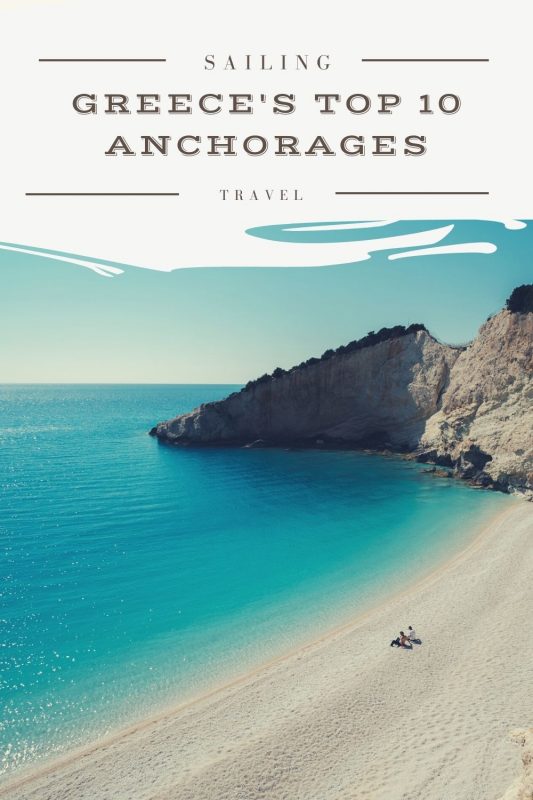
Greece’s Top 10 Anchorages

How Long Do New Sails Last?

How To Make Cheap Fender Covers
Such small mention of probably the best catamaran for overall cruising, focusing on ease of helming, speed and livability. Simple rig, great ergonomic features, style and definitely a pedigree on the water. The FP Mahe duo! Sea proven. Most delivered on their own bottoms from France. Wide beams and light. Beautiful interior arrangements and easy to maintain. I’m confused about so little mention of probably the best entry level and beyond real cruiser out there.
You forgot the edelcat 35. Great boats, and have circumnavigated!
I wonder why Broadblue 346 is not on the list.
Appreciate it’s a bit more expensive than most cats listed here but what about the Aventura 37? Technically a small cat but with ocean going abilities and an actual live aboard!
Leave a Reply Cancel reply
Your email address will not be published. Required fields are marked *
- Search Search Hi! We’re Emily, Adam and Tiny Cat, liveaboard sailors travelling the world on our 38ft sailboat and writing about it as we go. We hope we can inspire you to live the life you’ve always dreamed, whether that’s exploring the world or living a more simple way of life in a tiny home. Find out more. Patreon
- Privacy Policy
Small Sailing Catamarans: The Ultimate Guide
by Emma Sullivan | Aug 14, 2023 | Sailboat Gear and Equipment

Short answer: Small sailing catamarans
Small sailing catamarans are multi-hulled boats that offer stability, speed, and ease of handling. They typically have two parallel hulls connected by a platform and are designed for recreational or racing purposes. Popular among sailors due to their maneuverability and shallow draft, they are suitable for both inland and coastal waters.
The Beauty of Small Sailing Catamarans: Why They’re Perfect for Adventurers
Are you an adventurer at heart, longing to set sail and explore the vast depths of the ocean ? If so, we have just the vessel that will capture your imagination and ignite your sense of wanderlust – small sailing catamarans. These marvels of engineering offer a unique sailing experience like no other, making them the perfect choice for those seeking both adrenaline-pumping escapades and tranquil moments at sea.
What makes small sailing catamarans so enthralling is their remarkable combination of stability, speed, and space. Unlike their monohull counterparts, which tip precariously with every gust of wind, catamarans gracefully slice through the water with elegance and poise. Their dual hull design effortlessly balances weight distribution, providing unparalleled stability even in rough seas. This ensures a smoother ride and allows adventurers to indulge in exciting activities without compromising safety.
Speaking of thrills, these nimble vessels possess an inherent need for speed – a characteristic that perfectly suits adventure enthusiasts who crave excitement on the open waters . With their lightweight build and low-drag hull design, small sailing catamarans are designed for rapid acceleration. Imagine skimming across waves at exhilarating speeds as you feel the salty mist caress your face; it’s an experience that truly elevates adrenaline levels to new heights!
But don’t let their penchant for speed fool you – these catamarans also cater to those yearning for serene moments amidst nature’s grandeur. When you have had your fill of fast-paced adventures, simply anchor in a secluded bay or sandy cove to relish peaceful sunsets or immerse yourself in snorkeling adventures beneath crystal-clear waters. The ample deck space offered by small sailing catamarans allows adventurers to bask in the serenity surrounding them while indulging in much-needed relaxation.
One might ask: what about onboard amenities? Small sailing catamarans boast of clever and innovative storage solutions that make them an adventurer’s dream. From hidden compartments to specialized equipment storage areas, these vessels are designed to accommodate all the gear an explorer could possibly need. Whether you’re a scuba diver with tanks and fins or a kayaker seeking new waterways to conquer, rest assured that your equipment will be stowed efficiently on board.
In addition, small sailing catamarans offer spacious cabins for overnight trips or long expeditions – a welcome respite from the elements after an adrenaline-filled day at sea. With comfortable sleeping quarters and well-appointed interiors, adventurers can enjoy a good night’s rest as they prepare for another day of unforgettable conquests.
The versatility of these stunning vessels also opens up opportunities for exploration in shallow waters unreachable by larger boats. The shallows hold their own charm with vibrant coral reefs teeming with exotic marine life waiting to be discovered. Small catamarans’ reduced draft allows adventurers to venture where others cannot, granting unrivaled access to unspoiled paradises that remain hidden to most.
So, if you’re an intrepid soul ready to embark on thrilling escapades on the high seas without compromising on comfort and stability, look no further than small sailing catamarans. These magnificent creations combine performance, resilience, and adventure into one breathtaking package – ensuring that every voyage is nothing short of extraordinary. Let the beauty of small sailing catamarans unleash the adventurer within you!
How to Choose the Right Small Sailing Catamaran for Your Needs
Are you dreaming of sailing the open seas, feeling the wind in your hair and the salt on your skin? If so, then choosing the right small sailing catamaran is crucial to ensure that your dreams become a reality. With so many options available in the market, it can be overwhelming to narrow down your choices. But fret not, as we have compiled a comprehensive guide to assist you in finding the perfect small sailing catamaran for your needs. So grab a cup of coffee, sit back, and let’s delve into this exciting world of sailboats!
1. Determine Your Sailing Goals: Before embarking on your catamaran search, it’s important to establish what you want from your sailing adventures . Are you looking for weekend getaways with friends and family or planning to circumnavigate the globe? Identifying your goals will help narrow down the size, features, and capabilities that your ideal catamaran must possess.
2. Consider Your Budget: Catamarans come in various price ranges depending on their size, brand, condition, and features. It’s crucial to understand how much you’re willing to invest in this endeavor. Keep in mind that besides purchasing costs, there will also be ongoing expenses such as mooring fees, maintenance costs, fuel consumption, insurance premiums etc. Setting a realistic budget will prevent potential financial strains down the line.
3. Size Matters: Catamarans generally range from 30 to 50 feet in length; however smaller ones tend to be more maneuverable and easier to handle. For novices or those who prefer solo sailing adventures, opting for a smaller sized catamaran might be a wise choice due its simplicity and ease of use.
4. Assess Performance & Stability: One of the main advantages of small sailing catamarans is their unparalleled stability compared to monohull boats; they are less prone to heel (tilting) which ensures a smoother ride even in rough waters. Performance wise, they are renowned for their speed and ability to slice through waves effortlessly, offering an exhilarating sailing experience .
5. Comfort & Accommodation: While small sailing catamarans may be compact in size, they still managed to maximize the available space for comfort and accommodation. Look for features such as spacious cabins, ample storage compartments, well-equipped galleys, comfortable seating areas, and a layout that suits your needs. Remember, the more comfortable you are on-board, the more enjoyable your sailing adventures will be.
6. Check Quality & Construction: Investing in a well-built catamaran is essential to ensure longevity and durability. Pay attention to the construction materials used; fiberglass is commonly utilized due to its strength and resistance against corrosion. Assess factors like build quality, reputation of the manufacturer, craftsmanship standards and seek expert opinion when necessary.
7. Seek Professional Help: If you’re new to the world of small sailing catamarans or feel overwhelmed by the decision-making process, consult with a professional yacht broker or sailboat specialist who can guide you towards making informed decisions based on your needs and preferences.
8. Research & Test Sail: Thoroughly research different models of small sailing catamarans that align with your requirements; read reviews, participate in online forums or sailboat communities to gather insights from experienced sailors. Additionally, wherever possible test sail various models before making your final decision – experiencing firsthand how a particular catamaran handles will allow you to gain valuable knowledge before committing.
Remember that choosing the right small sailing catamaran requires patience and due diligence. Take your time exploring all available options while keeping in mind your specific needs and preferences. By doing so, you’ll soon find yourself aboard an incredible vessel that will take you on unforgettable journeys across vast seas! Happy Sailing!
A Step-by-Step Guide to Building or Buying a Small Sailing Catamaran
Are you ready to set sail on your very own small sailing catamaran? Whether you’re a seasoned sailor or a beginner itching to embark on your sailing adventure, this step-by-step guide will walk you through the process of building or buying your dream boat. Get ready to navigate the waters with confidence and style !
Step 1: Determine Your Budget and Research Options Before diving headfirst into building or buying a small sailing catamaran, it’s crucial to establish your budget. Consider how much you’re willing to invest in this endeavor, factoring in costs such as materials, equipment, and professional assistance if needed. Once your budget is determined, start researching different options available on the market. Take note of key features and characteristics that align with your sailing preferences.
Step 2: Evaluate Building vs. Buying Now that you have an idea of what’s out there, it’s time to weigh the pros and cons of building versus buying a small sailing catamaran. Building a boat allows for customization and complete control over its design, but it can be time-consuming, challenging, and potentially more expensive. On the other hand, buying a pre-built catamaran offers convenience but may limit customization options. Carefully consider your skills, resources, and overall objectives before making a decision.
Step 3: Build Your Small Sailing Catamaran – DIY Style! If you’ve decided to take on the exciting journey of building your own small sailing catamaran, preparation is key! Start by gathering essential tools and obtaining comprehensive plans or blueprints from reputable sources. Familiarize yourself with different construction techniques like stitch-and-glue or strip planking—each having its own requirements based on materials chosen (fiberglass ply vs wood). Assemble necessary materials such as marine-grade plywood or fiberglass sheets while paying attention to quality and durability.
While constructing your small sailing catamaran at home may seem daunting at first, approach it with enthusiasm and attention to detail. Follow the plans step-by-step, ensuring precise measurements, accurate cutting, and thorough sealing. Seek guidance from experienced builders or seek advice through online forums dedicated to boat-building communities.
Step 4: Consider Professional Assistance For those lacking time, experience, or simply looking for a faster route, enlisting professional help may be a smart move. Consult with boat builders specializing in small sailing catamarans to discuss your requirements and desired specifications. They can guide you through the selection of materials, provide design recommendations based on your needs, and oversee the construction process.
While utilizing professional assistance may increase your budget initially, it offers peace of mind knowing that experts are handling the intricate details involved in crafting a seaworthy vessel.
Step 5: Owning Your Dream Small Sailing Catamaran – Things to Remember Congratulations! You’ve built or purchased your very own small sailing catamaran. But before setting sail into the sunset, there are a few important factors to keep in mind:
1. Safety First: Ensure your catamaran is equipped with all essential safety equipment including life vests, fire extinguishers, flares, and navigational tools like charts and compasses.
2. Maintenance Matters: Regularly inspect and maintain your catamaran’s hulls, rigging systems (including ropes), sails, and engines (if applicable). Proper upkeep will enhance performance and ensure longevity.
3. Expand Your Knowledge: Keep honing your sailing skills by attending courses or workshops offered by reputable sailing organizations. Strengthening your knowledge will enhance safety on board while broadening your horizons as a sailor.
4. Embrace Adventure: Finally, don’t forget why you embarked on this endeavor in the first place – to embark on exciting adventures! Explore new waterscapes while embracing the freedom and serenity that comes with owning a small sailing catamaran.
So there you have it – a comprehensive, step-by-step guide to building or buying your dream small sailing catamaran. May the winds be forever at your back as you set sail into this thrilling and wondrous world of sailing!
Frequently Asked Questions About Small Sailing Catamarans Answered
Frequently Asked Questions About Small Sailing Catamarans Answered: Sail the Seas with Ease!
Are you a sailing enthusiast searching for the perfect vessel to embark on your next adventure? Look no further than small sailing catamarans! These nifty crafts have gained popularity among sailors of all levels, thanks to their unique features and exceptional performance. However, we understand that you may still have some burning questions about these marvelous vessels. In this blog post, we’ll walk you through the frequently asked questions about small sailing catamarans and provide detailed and witty answers that will help you make an informed decision.
1. What makes small sailing catamarans different from other sailboats?
Ahoy there! Small sailing catamarans are quite distinct from traditional monohull sailboats. Unlike their single-hulled counterparts, these beauties boast two parallel hulls connected by a deck platform. This innovative design offers improved stability, reduced heeling (leaning), greater living space, and enhanced maneuverability – giving you ample freedom to explore the open waters like never before!
2. Are small sailing catamarans suitable for beginners?
Absolutely! One of the main advantages of small sailing catamarans is their user-friendly nature, making them an excellent choice for novice sailors. With their twin hulls promoting balance and stability, even those new to sailing can confidently navigate without fretting too much about capsizing or feeling uneasy at sea.
3. Can I experience high speeds on a small sailing catamaran?
Fun comes first when it comes to these agile watercraft! Thanks to their lightweight construction and efficient aerodynamics, small sailing catamarans are known for their remarkable speed potential. So if you’re looking for an adrenaline rush or simply wish to reach your destination swiftly while harnessing the power of wind , these vessels won’t disappoint.
4 . Are they spacious enough for extended cruising?
Oh yes! Space is not compromised aboard a small sailing catamaran. The dual-hull design offers a generous deck area that can be utilized for outdoor lounging, dining, and soaking up the sun’s glorious rays. In addition to this spectacular exterior space, these catamarans typically provide spacious cabins, salons, and ample storage compartments – making them perfect for extended cruising adventures without feeling cramped.
5. Can a small sailing catamaran handle rough seas?
Ahoy, Captain! While no boat is impervious to the vastness of Mother Nature’s wrath, small sailing catamarans are renowned for their resilience in challenging conditions. The robust construction and wider beam offer stability even in choppy waters. However, it’s always prudent to exercise caution and check weather conditions before setting sail on any vessel.
6. How about maintenance and docking?
Have no fear – maintaining a small sailing catamaran is not as daunting as you may imagine! Due to their lightweight materials such as fiberglass or carbon fiber composites, these vessels require less maintenance compared to traditional boats made of steel or wood. When it comes to docking, their maneuverability shines yet again! The dual-engine setup allows for precise control when navigating tight spaces or docking at marinas.
7. What about the cost? Are small sailing catamarans budget-friendly?
Now comes the juicy part – budgeting! Small sailing catamarans do tend to have a higher initial price tag compared to monohulls due to their advanced design features and improved performance capabilities. However, many sailors argue that the long-term benefits outweigh these upfront costs. Think fuel efficiency with less reliance on fossil fuels thanks to wind power—cutting down operational expenses and making them quite economical in the grand scheme of things!
So there you have it—the frequently asked questions about small sailing catamarans answered with wit and wisdom! These remarkable vessels combine stability, speed, and comfort while offering an unforgettable experience on the high seas. Whether you’re a seasoned sailor seeking a new adventure or a beginner looking for the perfect vessel to embark on your first voyage, small sailing catamarans may just be your ultimate ticket to maritime bliss. Anchors aweigh, sailors!
Exploring the Benefits of Small Sailing Catamarans: Speed, Stability, and More
Sailing enthusiasts are constantly seeking thrill and adventure on the open waters. Whether you’re an experienced sailor or a beginner heading out for your first voyage, choosing the right sailing vessel can make all the difference in your experience. While monohulls have been the traditional choice for many sailors, small sailing catamarans have gained immense popularity in recent years. These sleek and nimble vessels offer a host of benefits that make them an attractive option for any sailing enthusiast .
One of the most enticing advantages of small sailing catamarans is their exceptional speed. These multi-hulled vessels are designed to slice through water with minimal drag, allowing them to achieve impressive speeds even in light winds. Unlike their monohull counterparts, which rely heavily on heeling to generate forward momentum, catamarans can reach high velocities while maintaining stability and comfort.
Speaking of stability, this is another significant advantage that sets small sailing catamarans apart from monohulls. With two hulls instead of one, catamarans provide enhanced balance and reduced rolling motions. This means you can enjoy smooth sailing even in choppy conditions or strong winds . The absence of heeling – when a monohull tilts due to wind pressure – not only keeps passengers more comfortable but also eliminates the need for constant readjustment while underway.
Another benefit worth noting is how easy it is to handle a small sailing catamaran. Thanks to their twin hulls and wide beam, these vessels have incredible maneuverability compared to their single-hulled counterparts. They turn sharply and respond quickly to helm adjustments, granting sailors greater control over their course and making navigating tight spaces or crowded marinas a breeze.
Furthermore, small sailing catamarans offer generous space onboard that translates into increased comfort during trips on the water. Their broad decks provide ample room for lounging or socializing with friends and family while enjoying uninterrupted views of your surroundings. Many modern designs feature spacious cabins equipped with modern amenities, allowing for extended cruises without sacrificing comfort.
In addition to these primary advantages, small sailing catamarans also boast excellent fuel efficiency. With their lightweight construction and streamlined designs, they require less power to propel through the water when compared to heavier monohulls. This translates into reduced fuel consumption and lower operating costs, making catamarans an environmentally friendly choice as well.
Moreover, small sailing catamarans are highly versatile vessels that can adapt to various sailing experiences. Whether you’re looking for a thrilling race on the open ocean or a relaxed day trip exploring coastal bays and coves, these boats are up for any challenge. Their shallow draft enables them to access shallow waters or anchor close to shorelines that may be inaccessible to larger vessels. This versatility makes small sailing catamarans not only suitable for seasoned sailors but also an ideal choice for families or those new to sailing.
In conclusion, the benefits of small sailing catamarans are undeniable. From their remarkable speed and stability to their ease of handling and spaciousness onboard, these vessels offer an unmatched sailing experience. So whether you’re chasing adrenaline-fueled adventures or seeking a comfortable escape on the water, consider embracing the wonders that only a small sailing catamaran can provide – setting sail into smooth seas while leaving behind all your worries onshore.
Tips and Tricks for Maintenance and Upkeep of Small Sailing Catamarans
Welcome to our blog where we will share a plethora of invaluable tips and tricks for maintaining and keeping your small sailing catamarans in top-notch condition. Whether you are a seasoned sailor or just starting to explore the thrilling world of catamaran sailing, these well-researched insights are sure to help you enhance the lifespan and performance of your beloved vessel. So, without further ado, let’s dive right into our expert recommendations!
1. Meticulous Hull Cleaning: The hulls of your catamaran are constantly exposed to water , salt, algae, and other elements that can deteriorate its structural integrity over time. Regularly cleaning the hull with appropriate marine-grade cleaners not only removes unwanted substances but also prevents the accumulation of dirt that can add unnecessary weight and drag.
2. Rigging Inspection: Catamaran rigging plays a crucial role in ensuring sail efficiency and overall stability. Periodic inspections should be carried out to identify any signs of wear and tear on your mast, shrouds, forestay, and other components. Replacing worn-out parts promptly ensures optimal safety while sailing .
3. Sail Maintenance: Your sails act as the powerhouse propelling your catamaran through seas; hence it is imperative to give them proper attention. Avoid leaving your sails exposed to prolonged sunlight when not in use and regularly inspect them for any tears or loose stitching that might need immediate repair.
4. Anti-Fouling Protection: Applying an effective anti-fouling barrier on the bottom surface of your catamaran helps prevent marine organisms from attaching themselves to the hulls – saving you valuable time and effort spent on cleaning later on.
5. Battery Care: After a thrilling day out at sea, don’t forget about the batteries powering various systems onboard! Routinely checking battery terminals for corrosion and ensuring they are charged adequately will ensure uninterrupted functionality during future adventures.
6. Adequate Storage Solutions: Organizing storage space efficiently is crucial for maintaining a clutter-free and well-balanced catamaran. Investing in smart storage solutions, such as hooks, nets, or designated compartments for different equipment, can significantly contribute to the longevity of your vessel.
7. Regular Engine Maintenance: Engines are the backbone of any sailing experience, so regular maintenance is essential . Following manufacturer guidelines regarding oil changes, filter replacements, and general inspections will help keep your engines purring smoothly.
8. Safety Equipment Check: Safety should always be a top priority when sailing catamarans. Inspecting life jackets, flares, fire extinguishers, and other safety equipment at regular intervals ensures that they are in optimal working condition – contributing to peace of mind during your voyages.
9. Docking Techniques: Mastering proper docking techniques contributes not only to the smooth maneuverability of your catamaran but also protects it from accidental damage while mooring. Taking the time to practice docking methods can save you from costly repairs caused by mishaps.
10. Weather Monitoring: As with any water-based activity, keeping an eye on weather forecasts is imperative when planning your trips aboard a small sailing catamaran. Being aware of potential storms or unfavorable conditions empowers you with knowledge to make safer decisions while out at sea.
These tips and tricks form a comprehensive guide to prolonging the life and enhancing performance when it comes to maintaining small sailing catamarans. Implementing these suggestions alongside regular servicing and upkeep practices will undoubtedly result in countless unforgettable journeys on the open waters ahead! So hop aboard your small sailing catamaran and embark on new adventures with confidence!
Recent Posts

- Sailboat Gear and Equipment
- Sailboat Lifestyle
- Sailboat Maintenance
- Sailboat Racing
- Sailboat Tips and Tricks
- Sailboat Types
- Sailing Adventures
- Sailing Destinations
- Sailing Safety
- Sailing Techniques
- Skip to main content
- Skip to primary sidebar
- Skip to footer
The Boat Galley
making boat life better

10 Small Catamarans for Cruisers
Published on January 23, 2021 ; last updated on November 7, 2023 by Carolyn Shearlock/Rick Marcarelli

I hear from many readers interested in small catamarans. Recently, the folks at www.CatamaranSite.com reached out to interview me about our experience cruising on our Gemini 105, Barefoot Gal and we began chatting about the various small catamarans on the market. One thing led to another and I’m pleased that Rick Marcarelli was willing to contribute a guest post sharing information comparing ten of the most popular small catamarans on the market.
When most buyers think of catamarans these days, they think of designs by Lagoon, Leopard, and Fountaine Pajot.
These are all fine vessels. But they were built to cater to the charter markets. And so they may not be the best boats for long-term, liveaboard cruisers.
Charter vs Liveaboard Cruising
The typical charter catamaran accommodates three or four couples sailing for one to two weeks in the Caribbean or Mediterranean. Usually they will provision once, sail a few daylight hours, eat out more than a typical cruiser, and anchor or moor for the night.
Compare that itinerary to the typical liveaboard cruiser.
Most cruisers spend over 90% of their time at anchor or a dock. They provision repeatedly and usually for many months at a time. Many cruisers rarely eat out at restaurants. And most importantly, cruisers sometimes sail non-stop through the night for multiple days or weeks when making a passage between cruising destinations.

The differences between charterers and cruisers cause them to desire different cabin layouts and amenities.
For charter boats, the focus is on several small cabins, each having its own accompanying head. They also have minimal storage space and enormous salons and cockpits.
Long-term liveaboards generally desire a large master cabin, fewer heads, and significant storage space. They are usually willing to compromise space for superior sailing performance to reduce passage making days and increase safety by avoiding severe weather.
Affordable Catamaran Market
Unfortunately for liveaboard cruisers interested in catamarans, the market is dominated by enormous, often very expensive, four cabin-four head charter models. In fact, our analysis of sales data suggests that about 38% of the market consists of Lagoon catamarans and over 50% are Lagoon or Fountaine Pajots. In addition, 90% of the market consists of catamarans over 38 feet in length. Please see the infographic.
While a majority of catamarans for sale are large, expensive, charter catamarans, our site’s traffic suggests that 40% of buyers are looking for smaller, simpler, affordable catamarans under 38 feet in length.
These are buyers like Carolyn was when she purchased S/V Barefoot Gal . And they are buyers who may be like you and are looking for something affordable that is suited to your liveaboard needs.
Modest Cats for Cruisers
Consider widening your net. Here are some additional models to consider in your search:
Prout 37 Snowgoose
- Cruising Grounds: Bluewater
- Underbody: Fixed Keels
- Draft (max): 2.08′
- Mast Height: 40’ (Standard) / 50’ (Elite)
- Bridgedeck Clearance: Average
- Layouts: 3 cabins, 1 head; galley down; open version has larger salon while private stateroom has larger master cabin
- Speed: Slow
- Engines: Usually single outdrive; rare versions have twin inboards
- Availability: Relatively common all over the world
- Ballpark Price: Around $100,000 USD

- Cruising Grounds: Built for North Sea
- Draft (max): 2.5′
- Mast Height: tabernacle mast
- Bridgedeck Clearance: Above Average
- Layouts: 3 cabins, 1 head; galley down
- Engines: Single gas outboard or twin inboard diesels
- Availability: Somewhat rare; usually a couple on the market or 8M sister ship; more in Europe
- Ballpark Price: Under $50,000 USD
Lagoon 37 TPI
- Draft (max): 4′
- Mast Height: 55’
- Layouts: 3 or 4 cabin; 2 heads; galley down
- Speed: Fast
- Engines: Twin inboard diesels
- Availability: Very rare; cult classic
- Ballpark Price: Over $100,000 USD

PDQ 36 Capella
- Draft (max): 2.82′
- Mast Height: 47’ (Standard) or 55’ (LRC)
- Layouts: 2 or 3 cabin; 1 or 2 heads; galley down
- Engines: Single gas outboard, twin gas outboard, or twin diesel inboard
- Availability: Usually a few on the market and more likely in USA
- Ballpark Price: Over $100,000 USD
Seawind 1000
- Draft (max): 3.2′
- Mast Height: 47’
- Layouts: 4 cabins; 1 head; galley down
- Speed: Fast
- Engines: Twin gas outboard
- Availability: Usually a few for sale; newer models still being built; originally built in Australia
- Ballpark Price: Over $150,000 USD

- Cruising Grounds: Coastal
- Draft (max): 3.35′
- Layouts: 4 cabins or 2 cabin Maestro; 2 head; galley up
- Engines: Twin inboard diesels with saildrives
- Availability: Usually a couple on the market often in Caribbean
- Ballpark Price: Around $150,000 USD
Endeavour 36
- Draft (max): 2′ 9″
- Layouts: 3 cabin; galley down
- Engines: Twin inboard diesels
- Availability: Rare and likely in the USA

- Draft (max): 3.62′
- Mast Height: 55′
- Layouts: 3 cabin / 1 head; 2 cabin / 2 head; galley up
- Availability: More common especially in Caribbean
- Ballpark Price: Newer version up to $300,000 USD
- Underbody: Centerboards
- Draft (max): 5′
- Mast Height: 47’ (M) or 48’ (MC)
- Bridgedeck Clearance: Below Average
- Layouts: 3 cabin; 1 head; galley down but open
- Engines: Single inboard diesel with retractable outdrive
- Availability: Common especially in the USA

- Draft (max): 3′
- Mast Height: 46′
- Layouts: 4 cabin / 1 head; 3 cabin / 2 head; galley down; bathtubs on some
- Engines: Single or twin inboard diesels
- Availability: Rare model
- Ballpark Price: Around $50,000 USD
Rick Marcarelli is the webmaster of CatamaranSite.com featuring cruising catamarans for sale by owner as well as educational articles. Rick is the owner of S/V Catalpa , a Catalac 8M based out of Merritt Island, Florida. The site also functions as the owner’s website for Catalac catamarans. If you are planning on buying a catamaran, CatamaranSite.com might save you a considerable amount of money and lead to years of happy sailing.

And check out our other courses and products
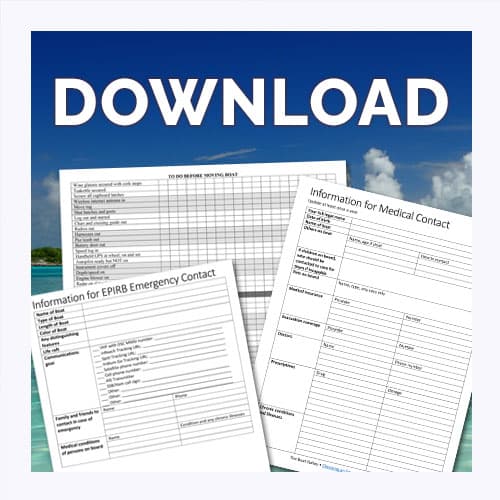
Find this helpful? Share and save:
- Facebook 359
- Pinterest 198
Reader Interactions
January 31, 2021 at 5:58 pm
I would think draft on the fixed keel boats would be important to many who are considering cats.
Carolyn Shearlock says
February 1, 2021 at 12:49 pm
I’ll see if we can perhaps add that.
Richard says
February 9, 2021 at 11:03 am
Good addition. I have provided drafts to Carolyn, so please watch this article for that to be updated. Any questions or additional information you would like added please comment again.
Drew Frye says
February 20, 2021 at 11:46 am
The best way to look at speed ratings is the PHRF rating or other handicaps. I used to own a PDQ 32 and never found a Gemini I couldn’t pass rather easily on autopilot, so I don’t think it rates slow if well handled. Granted, mine was turboed a bit and carried a 120 rating.
Florida ratings, according to US Sailing
PDQ 32 135 Seawind 1000 137 PDQ 36 156 Gemini 105 MC 168 Snowgoose 250 The others rate around 130-145
And of course, this is only fast or slow within the class. Fast multihulls cruising (?) multihulls rate 0-60.
February 21, 2021 at 7:59 am
Thanks! Good info.
September 10, 2023 at 5:55 am
I have an Edel 35′. For their price, they are a good option, for this size of catamaran. They are not slow, by any means. Disadvantage: clearance under nacelle.
Erin Michaud says
February 23, 2021 at 10:22 am
Great info, we met an owner of a Catalac 9M in Key West Garrison Bight Marina a couple of weeks ago. His name is Eric & he moved his boat to the Boca Chica Navy Marina. I will send the contact info for Rick to him specifically for the Catalac boats! Thanks!
February 24, 2021 at 5:54 am
Catalacs are great boats. We saw a couple for sale around the time we bought Barefoot Gal but they were sold the same day they were listed so we didn’t get to even look at them.
January 6, 2022 at 11:32 am
Hello. I was wondering if you can identify this open catamaran which boasts a GRP cockpit with seating?
https://imgur.com/gallery/2wzUJmR
Bruce Bayne says
February 20, 2022 at 9:57 am
I noticed that the Privilege 37 and 39 were not mentioned in your 10 list of catamarans. Is there a reason? How do they stack up to the others with regard to speed and bridgedeck clearance?
June 6, 2022 at 10:44 am
Rayma Church says
July 31, 2024 at 7:27 pm
Last November we purchased a Fontaine Pajot power cat (MY4s) that is 37′ long and has a beam of 16.8″, with a draft of 2.6″ and a height of 15′ but is tall inside for my 6’5″ partner without having to hunch over. This means we can go under the lowest bridges on the Great Lakes leg of the Loop, although we do not have a fly bridge. This is a new model (made its debut in 2023) and we plan to start the Great Lakes leg in June 2025 – the boat is being handed over to us in Annapolis in October. One of the reasons we selected this boat is because of the need for interior height but exterior “shortness” to get under the bridges. Also, this model has access on both sides of the boat that are about 18″ wide – another safety feature as my 6’5″ man has size 14 feet! We have been receiving your emails for the last 9 months or so in preparation for so many things boat related. We are both so happy to crib off of your experience rather than learn through adversity! Thanks, rayma
August 1, 2024 at 12:26 pm
Great choice of boat for the Loop!
Leave a Reply Cancel reply
Your email address will not be published. Required fields are marked *
Each week you’ll get:
• Tips from Carolyn • New articles & podcasts • Popular articles you may have missed • Totally FREE – one email a week
SUBSCRIBE NOW
- Questions? Click to Email Me
- Visit Our Store

Best Small Sailboats for Beginners
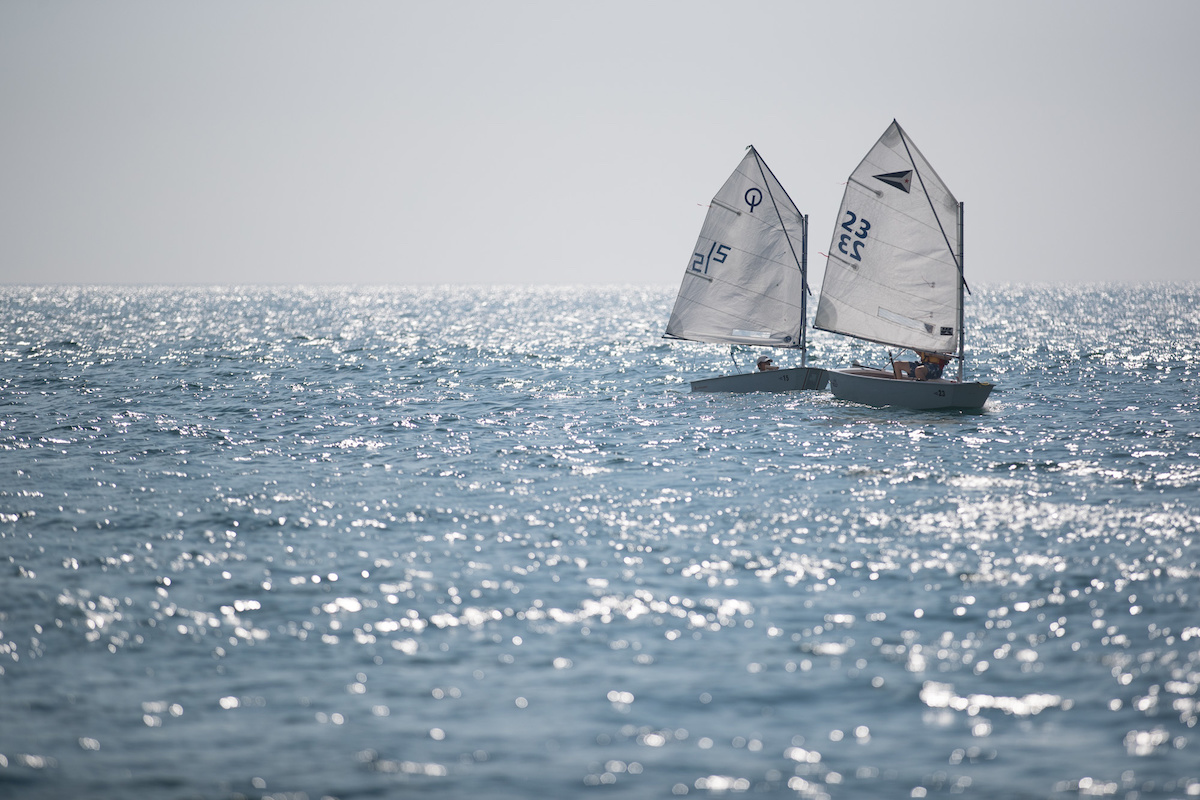
There are a number of classic trainers used by yacht club youth programs as well as techie new designs. Without mentioning specific models and brands, it’s difficult to outline which small boats are best but here are things to look for in good teaching boats.
Some of the best small sailboats for beginners include:
- Boats with tillers steering
- Boats with no winches
- Sailing dinghies
- Small sloops
- Small catamarans
- Rotomolded boats
- Trailerable sailboats
Explore All Sailboat Types
Boats with Tiller Steering
Steering by tiller (rather than a wheel) can make a difference when learning. Tillers are directly connected to the rudder that manages the boat’s direction. Tillers provide quick feedback about the strength and direction of the wind as well as the boat’s turning agility at various speeds.
Boats with No Winches
Boats that require no winches to manage the sheets and halyards are best for youngsters and new sailors. These boats usually don’t experience the same forces on the sails and rigging as larger boats, which can be a handful when the wind starts to blow. Winches are usually replaced with cam or jam cleats, which are easy to use.
Sailing Dinghies
Sailing dinghies are usually rigged with one mast and one sail and offer kids and new sailors simplicity so it’s easy to learn the ropes. Less overwhelming than boats with two sails, dinghies are light and responsive. They also have a shallow draft due to side or centerboards so they can be sailed just about anywhere. In some cases (whether from a wind gust or sudden crew weight shift) sailing dinghies can capsize so students should wear lifejackets and know how to swim. Sailing dinghies are usually sailed by one or two people.
Small Sloops
Small sloops with a mast that carries head and mainsails are the next step so students learn how sails work together. Headsails can be hanked on or attached to a small roller furler. These boats may have some or no winches, which also makes them easier to maintain. These boats can usually be sailed with one to four people.
Some sloops can scale up, providing a more challenging experience for sailors as they develop skills. Certain models can carry spinnakers and larger headsails to teach sail combinations and new sail trim techniques. Others offer the ability to hike out (shift crew weight well outboard to balance the boat against the wind pressure in the sails). This kind of sailing is more advanced.
Small Catamarans
Small catamarans provide extra stability for those who may be nervous about capsizing or aren’t fond of heeling (tipping while sailing). With two hulls providing a wide and stable base, catamarans area ideal for beginners, which may be why they’re often used by resorts as their beach sailing tourist boats. Rigged with one or two sails, small cats are tiller steered and usually have a trampoline that the students sit on and sail.
Rotomolded Boats
Small rotomolded boats are very forgiving due to their durable construction. Unlike fiberglass or wooden boats, rotomolded (a type of plastic construction technique) trainers can bounce off docks or other boats and cause or sustain little damage. Dinghies and catamarans can both be made via rotomolding.
Trailerable Sailboats
Finally, small sailboats that can be trailered to different locations add variety and that makes learning fun. Students can learn to sail in different wind and water conditions and enjoy their boats differently on vacation or with new friends.
Learning to sail involves all the senses and requires a level head and lots of practice and although it can be learned in many ways, the best way is to start with a boat that’s small, simple, safe and durable.
Read Next: Small Boats: What Are My Options?
You Might Also Like:
- Sailing Basics: 10 Nautical & Sailing Terms to Know
- Learning the Basics of Sailing
- Why Sailing?
- Find the Right Boat for Your Lifestyle
- Explore Sailboat Brands
Join Our Newsletter!
Get community news, buying bargains, and how-to guides at your fingertips.
Save 10% on new Happy Cat Sailboats while supplies last Discount Code: EOYHAPPYCAT
Your Next Adventure Starts Here!
Founded in 2015, Red Beard Sailing started the craze of portable and inflatable sailboats in the USA. Talk to Red Beard himself and get real personalized advice on which boat is best for you! Email ([email protected]) or call (410-705-5026) get started today!
Owning a traditional sailboat can be hard work! Between maintenance and repairs who has the time to spare to actually go sailing? Portable & Inflatable sailboats eliminate the headaches of boat ownership, making it easy to get out on the water!
No trailer means you can take your sailboat with you anywhere!
Portable Sailboats cost less than comparable hard hulled boats!
Inflatable boats tend to bounce instead of break. Fewer bruises mean fewer repairs which ultimately means more time on the water!
A boat that is easy to use will get used more often. Enjoy sailing more with an easy to use portable boat!
Small pack-down sizes mean you can store your boat safely anywhere!
Shop Portable Sailboats
Xcat multi-sport catamaran boat.

Sail, Row, Motor The XCAT Does It All
Starting at $6500.
The XCAT Multi-Sport Catamaran can sail, it can row, it can motor. It does all of this while only taking 15 minutes to assemble and without the need for a trailer to transport! Easily transported on the roof of your car or in the bed of a pickup truck, the XCAT is the world's most portable non-inflatable sailboat! Built for speed and safety, the XCAT can handle high wind days just as easily as light wind days!
MiniCat Inflatable Catamaran Sailboats

The Sailboat That Fits In Your Car!
Starting at $4500.
MiniCat Boats are the most complete, well thought out inflatable boats on the market. No other inflatable boat manufacturer offers a comparable selection of boat models or as wide of a selection of accessories. Compact and affordable, MiniCat inflatable sailboats are the most economical way to spend time on the water! Choose between the MiniCat Guppy , 310 , 420 , and 460 .
Happy Cat Inflatable Catamaran Sailboats

The World's Fastest Inflatable Sailboat
Starting at $9550.
Happy Cat inflatable catamarans are versatile on the water, and can handle anything from high speed races, to all-day family fun. These boats are just as happy sailing at 6 knots as they are at 20 knots! Happy Cat Boats are also constructed from the highest quality materials like eco-friendly rubber hulls instead of plastic, and anodized aluminum frames and mast. These innovative materials and attention to details will ensure your Happy Cat is built to last you many adventures for years to come. Choose between the Happy Cat Neo , Hurricane , and Evolution .
Astus Trimaran Sailboats

Where Speed Meets Economy
Starting at $7700.
Designed by the legendary French design firm, VPLP , the Astus' line of boats offers a very unique path to sailing. Their portable Astus 14.5 fits the bill for solo sailors, but the rest of their range can be enjoyed by the whole family! Keep an eye out for the Astus 20.5 and 22.5 as they are well positioned as economical trimaran speedsters with key features that make owning a trimaran sailboat much more enjoyable!

Shop Inflatable Watercraft
Takacat inflatable boats.

Ultra-Portable Inflatable Dinghy
Starting at $1999.
The Takacat range of inflatable boats range from 8' 6" to 15' 1" in length. Whether you’re looking to explore your favorite fishing spot or take the family out on the open water, Takacat has you covered. The two carrying bags make Takacat compact and easy to transport. Assemble your Takacat in as little as 10 minutes! The quick assembly time will have you on the water in no time at all!
ROWonAIR Portable Rowing Boats

On The Water Rowing Made Portable
Starting at $1685.
ROWonAIR offers the most portable rowing experience in the world! Their products range from inflatable v-bottom boards optimized for rowing performance to the world's best portable rowing systems ! RowMotion is perfect for a traditional traditional rowing experience. RowVista is utilizes advanced engineering to create forward facing rowing. Whichever you choose ROWonAIR delivers an unmatched portable rowing experience.
Grabner Inflatable Kayaks

World Class Inflatable Kayaks
Starting at $2550.
Grabner manufactures the world's best inflatable kayaks , period. Made of recyclable EPDM rubber, these kayaks are both durable and long lasting, with an expected and proven lifetime of 25+ years , as well as the most environmentally friendly inflatable boats in the world! The Grabner kayak range offers kayaks that are capable of class 5 rapids as well as recreational and expedition kayaks that will fit any paddler's needs!
Grabner Inflatable Canoes

The World's Best Inflatable Canoe
Starting at $3300.
Grabner inflatable canoes are legendary with the Adventure Canoe being the closest thing you can get to a traditional canoe without the extra weight, instability or transport woes! Whether you are going for a leisurely paddle on the lake or taking on the Alaskan wilderness, a Grabner canoe can take the abuse and make sure you are getting the most out of your time on the water!
ePropulsion Portable Electric Outboard Motors

Electric Propulsion Made Easy & Fun!
ePropulsion motor technology and designs are the result of years of testing a consumer feedback. Whether you are looking to re-power to an electric drive setup or just looking for a lightweight motor for docking that can be removed while sailboat racing, ePropulsion has you covered! The Vaquita motor is a lightweight, compact SUP motor that has been adapted to fit the XCAT and other lightweight sailboats. The Spirit 1.0 is a 3HP equivalent motor that can employ a large battery bank or have a battery directly mounted to the motor for added convenience. This is the most popular motor in the ePropulsion lineup. The Navy and Pod Drive systems are also available for larger and more permanent installations. Please email ([email protected]) or call us (410-705-5026) to quote your next repower project!
As Seen In...

What Our Customers Are Saying...
Row vista - beyond amazing.
Alex, I gotta tell you this. Yesterday I was at Lake Natoma, the home to the Sacramento Aquatic Center, with my Kayak and RowVista kit. What I did not know was that there was a whole bunch of rowing teams practicing. (I later googled and found that they have the PAC 12 happening today, which is a University level competition). The look of amazement and bewilderment that I got from the boys and girls on sculls was amazing. It felt that this was the first time they saw someone row forward which btw is the only way I know, as the first time I rowed was 2 weeks ago. I got smiles, cheers and sometimes envy (side eyes) from over a 100 young people. I thought of going again today but I think I couldn't handle any more attention. The RowVista definitely made me the coolest rower, although not the fastest among these professional athletes. While, I have improved to 4.6 mph (7.4 km/h) over 2 km since I got the kit. Thanks for letting me live this moment, eagerly waiting for the XCAT.
Carbon 420 - The Perfect Cat
We bought a Carbon 420 in Nov 2020, and have sailed it almost every week since then, sometimes twice a week! Alex is great to work with, answers every question, and is extremely knowledgeable. He truly loves the sport! One of the first things we did was intentionally capsize it to see how hard it was to right... Almost too easy! It's super easy for 1 person to right. And the carbon mast is super light and easy to step. So glad we got the carbon version! We find that it is highly stable, but very nimble. And it can really fly! We love that combination. It's fun and easy! Some accessories we highly recommend: Flextail pump. Cuts inflation time tremendously. And deflates fast to make storage really easy. Upgraded shackles. Huge difference in knowing they are secure, easy to check, and so easy to turn. Worth it! Front trampoline. Rope ladder. Outboard attachment. Trolley wheels. Because we added weight with an electric motor, we made a telescoping extension that hooks over the trolley axle. Now we launch and retrieve easily even at a ramp. The boat just floats on and off the trolley. Super easy and fast! Overall, we highly recommend the Carbon 420. It's perfect for us. We spend wonderful days on the water, sailing, exploring, snorkeling, and just loving the sound of water against the boat. And we definitely recommend Red Beard Sailing... Alex has the best service and the best prices!
HAPPY CAT EVOLUTION...PERFECT FIT FOR ACTIVE, TRAVELING FAMILY OF 6
Having sailed most of my life I was looking for a cat that did not require a trailer, but was large enough for a family of 6 to go day sailing and over-nighting while providing a level of excitement to keep the kids interested (speed). Other options didn't offer the loading capacity, size, portability, and performance found on the Happy Cat. I purchased our Happy Cat in 2020 and have sailed it with my family at numerous locations around Chesapeake Bay, Maryland, and Lake Ontario. Its portability makes it possible to fit in our RV (I've even had the Happy Cat in our Chrysler minivan along with the whole family-tight, but possible). With two adults on board, flying a hull is easy, non-eventful, and adds exhilaration to a day of sailing. Loaded with my family of 6+gear, the Evolution easily skims across the water at speeds that keep my young kids wanting more! While not the least expensive option, the construction, quality hardware/rigging, ease of sailing, performance, and portability made this a perfect choice for us. Alex assisted in reaching a decision on a boat which was best suited for my needs in a NO pressure manner. After sale support from Alex has been AWESOME! Alex continues to answer questions, provide input, and promptly responds to email, texts, as well as phone calls. Thanks Alex for helping me select the right boat to introduce my four young children to the amazing world of sailing..Oh, by the way, I feel like a kid again when sailing the Happy Cat!!
STILL LOVING MY 420 AFTER FOUR YEARS OF SAILING
So happy with this purchase four seasons in. It’s a serious boat with all the lines and controls exactly where you want them. The light weight makes it easy to go in the lightest wind, and the rugged engineering feels solid even when it’s up on one pontoon in 20 knots. One person can easily get it righted if you manage to flip it (which doesn’t happen often). Alex has provided great service the whole way. I haven’t needed much, but he is responsive and knowledgeable. I have patched a pontoon, gotten some rigging replicated at West Marine, and attached a trolling motor to tool around when there’s no wind. All of that has been easy enough, and I see years of great sailing ahead of me in my Minicat 420. Can’t say enough positive things about the boat and Red Beard.
We purchased our RowVista X-Cat in 2016 and could not be happier with it. Superior engineering and construction. Red beard Sailing and Alex specifically are the best in the business to work with. Five stars in every category.
Awesome Cat!
Got our 420 (LD Edition) from Alex at Redbeard this past summer (2017) and love the boat. I have owned and raced A-Class catamarans and while this is understandably no A-Cat, it is an awesome little boat that is a blast to sail! We live aboard our cruising catamaran, JADE, and wanted a portable sailing dinghy to mess around with while anchored in various places. Alex has been a great source, from the original set up and demo of the boat, through the purchase, delivery, inventory and follow up. The boat is very simple to set up (and actually fun to construct) and is lightweight enough to sling over the side with our big boat's spinnaker halyard, so we can set everything up on the trampoline of JADE and then launch and go. The roller furling jib is a great feature that really makes getting underway and docking very easy. My wife and I can sail it together, comfortably, as there is plenty of room on the tramp and hulls. I sailed the other day, solo, pacing a friend on his roto-molded beach cat and kept up in winds that were just shy of 15kts. It comes apart very easily and stows in two heavy vinyl zippered bags which we stow internally in JADE. Because this is a boat that sails really well AND is collapsable and easy to assemble and disassemble, it was the right choice for us. Can't wait to get out and sail it some more!
An Inflatable Dinghy That You Can Row!
I had a small Mercury inflatable for about 10 years, and when I went looking for a replacement, I needed something a little larger and--I hoped--a boat I could row. We usually row out to our moorings on the midcoast of Maine and rarely use an outboard either on the dinghy or the sailboats. The design of the Takacat 260 Sport offered less wetted surface to push through the water and more space for people and gear. The high-pressure inflatable floor was an added bonus: soft and sure under foot and quick to dry, not to mention the convenience of having any rainwater settle below the floor and drain readily from the stern when the bow is lifted. This is our second season, and the "Left Behind" is working out beautifully. We frequently carry an oarsman, two passengers and an 80-pound Golden Retriever, although the boat certainly handles better with a lighter load. Alex handled the delivery from New Zealand to Maryland to Maine without a hitch.
STILL WONDERFUL AFTER 3 YEARS
This thing is a little rocket. This is my Third year with the X-cat. I still love it. I also have a 30 foot keelboat, but I take the X-cat out a lot. The X-cat is stable & well designed. I just took it out in worsening weather (against my better judgement). Very choppy conditions and accelerating winds with some light rains. I was sure I would pitch-pole but did it just would not happen. I also stayed pretty dry which was a big surprise. The motor is also wonderful for leaving against the tide. We’re still happy with it.
A DREAM TURNED INTO A REALITY
For a long time I have dreamed to own a sailboat, but don't have the space to have a towable one. Storage and transport were major concerns since I live an hour and a half from the nearest sailable lake. I learned about Minicat and was completely amazed about its features. Alex did a good job taking me and my family for a demo sail and the deal was closed the same day. Now we own a 420 emotion and it is our dream turned into reality. For novices like us, it took just a couple of hours on the water to learn by ourselves how to take the boat to where we want to go, it is very stable, fun and easy to sail. The service at Red Beard Sailing is not limited to the sale, we know we can count on them for whatever we need, five stars for sure!
Frequently Asked Questions (FAQ)
Red Beard Sailing was the first North American portable boat dealer! We started RBS in 2015 with a MiniCat 420 and the demand has just exploded! We have poured every ounce of passion we have into portable boating and the lifestyles that it affords! When you buy from Red Beard Sailing you get a passionate team of sailors that will help you every step of the way. Whether you are looking at one of our portable sailboats or dinghies or just need advice from a seasoned delivery captian we have the experience to help you make the right choice for you!
We are experts in everything we sell. We have walked many customers through the assembly of their boats and even tips on how to improve their on-the-water performance too! Give us a call ( 410-705-5026 ) or email us ( [email protected] ) to have a member of our sails team help walk you through the process! Please also check out our YouTube channel where we are always making new videos to help with those first assembly woes!
The greatest part about portable boats, the ability to take it anywhere, begs the question... "Where can I take it?" Our portable boats can be launched nearly anywhere a kayak can be launched! Here in Baltimore, Maryland, we prefer to launch from the Gunpowder State Park, Hammerman Area . This park has great facilities, including a snack stand and proper bathrooms. The basin is pretty well protected, but large enough for ample wind on most days. In all but a NE wind, the water is flat and calm with little powerboat traffic, which is perfect for fast sailing and smooth paddling. If you are not near us, we recommend looking for State Parks that offer Small Boat Launches. We also have found some great resources through the sea kayaking communities, they typically well document launches and paddling areas similarly to how we discribed the Hammerman launch above.
Many of our boats are in stock, but others must be ordered from their respective factory. East Coast USA In Stock Items - 2-4 days Special Order - 2-3 weeks Central USA In Stock Items - 2-4 days Special Order - 2-3 weeks West Coast USA In Stock Items - 4-7 days Special Order - 2-3 weeks If you have an urgent need for something or just want to verify the lead time for your purchase, please give us a call ( 410-705-5026 ) or email us ( [email protected] ) for a personalized ETA.
Portable boats have inexpensive and easy to replace parts, so if you are in a situation where you need to purchase a replacement part (or are looking to keep a few spares on hand), give us a call ( 410-705-5026 ) or drop us an email ( [email protected] )!
Depending on what boat you are purchasing and where you live, registration may or may not be required. In Maryland, we are only required to register our boats if they are intended for use with a motor.
The best way to see one of these boats is to visit our warehouse in Baltimore, MD or schedule a demo day on the water for the boat you are interested in. We host demo days where we have many of our boats on the beach ready to try out as well. There is a lively owner's group for all of our brands, we encourage you to join the community either on social media or other sailing forum to meet with other owners that are local to you! Give us a call ( 410-705-5026 ) or drop us a note ( [email protected] ) and we would be happy to point you in the right direction!
Red Beard Sailing is fully staffed with experienced sailors including yacht delivery captains and certified sailing instructors, but we do not offer sailing lessons. We have many local partners that would love to provide these lessons, with many of these options willing to do so on your personal boat!
We take pride in our brands and our work. We will work to make sure you are 100% satisfied with your purchase or we will work with you to return your boat. Unfortunately, the process of simply taking an order does cost us money that we, as merchants, cannot recover. We assess a 15% restocking fee for all cancelled or returned orders to cover our costs.
Sign Up for Our Newsletter
Receive exclusive offers, and be the first to know about upcoming events, demos, sales, and discounts.
- BOAT OF THE YEAR
- Newsletters
- Sailboat Reviews
- Boating Safety
- Sails and Rigging
- Maintenance
- Sailing Totem
- Sailor & Galley
- Living Aboard
- Destinations
- Gear & Electronics
- Charter Resources
- Ultimate Boating Giveaway

11 Best Pocket Cruiser Sailboats to Fit a Budget
- By Cruising World Staff
- Updated: May 24, 2024
Looking for a trailerable pocket cruiser that offers that liveaboard feeling? This list features 11 small sailboats with cabins that have the amenities often found on larger vessels. They may not be ocean crossing vessels, but they’re certainly capable of handling big bays and open waters.
What is a pocket cruiser? It’s a small trailerable sailboat, typically under 30 feet in length, that’s ideal for cruising big lakes, bays, coastal ocean waters, and occasionally bluewater cruising. Pocket cruisers are usually more affordable, compact, and offer a level of comfort that’s comparable to bigger liveaboards.
Small cruising sailboats are appealing for many reasons, but if you’re like most of us, you want to maintain a certain level of comfort while on the water. We took a poll and these are what we found to be the best cruising sailboats under 30 feet.
– DON’T LET CARBON MONOXIDE SNEAK UP ON YOU – Install detectors on your boat to sniff out any buildup of carbon monoxide gas. Avoid running engines or generators while anchored or stopped for extended periods. Safety Tip Provided by the U.S. Coast Guard
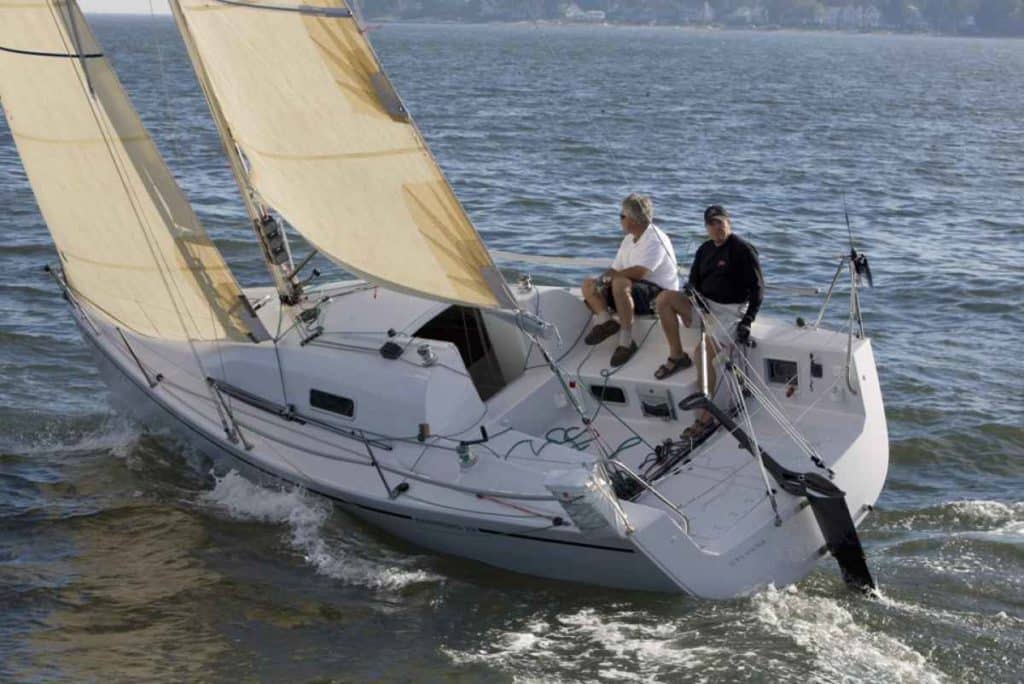
Open and airy below deck, the Andrews 28 doesn’t sacrifice comfort for speed. Designed by Alan Andrews, the Southern California naval architect renowned for his light, fast raceboats, this 28-footer will certainly appeal to the cruiser who also enjoys a little club racing. Sporting a total of 6 berths, a galley, head and nav area, you might forget you are on a boat small enough to be easily trailered. The retractable keel allows the Andrews 28 to be easily launched and hauled and ensures it’s as comfortable as a daysailer as it is a racer. Click here to read more about the Andrews28.
Beneteau First 20
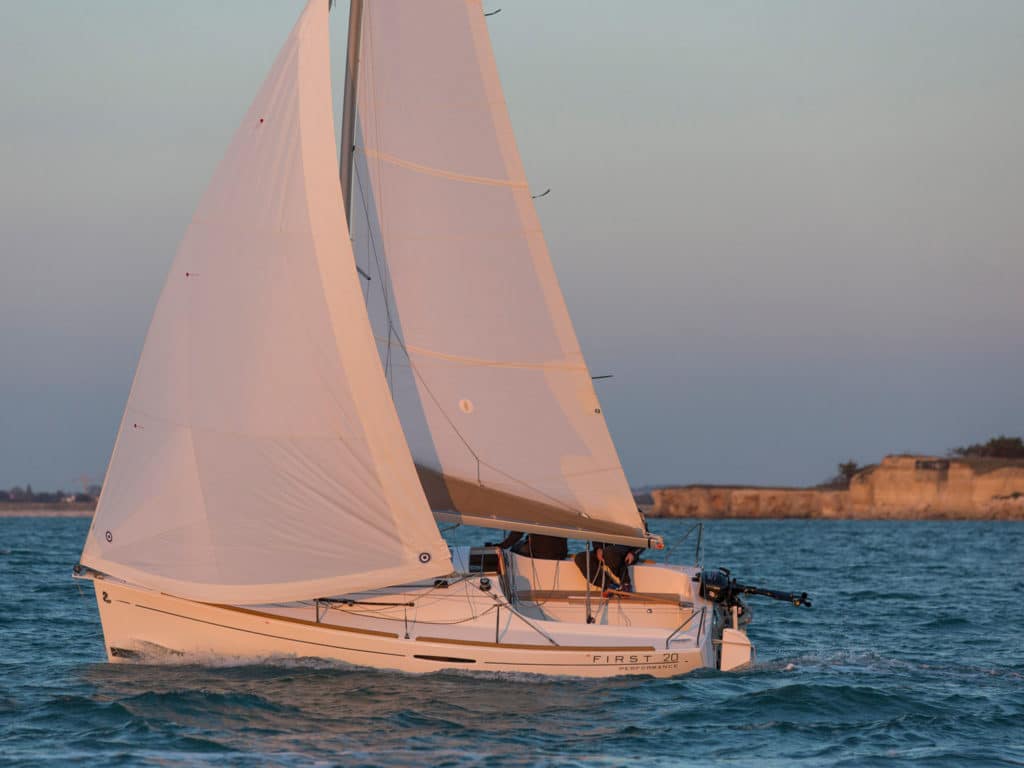
Small sailboat with a cabin? Check! Fun to sail? Modern design? Capable of flying a spinnaker? Check! Check! Check! The Finot-Conq-designed Beneteau First 20, which replaced the popular Beneteau first 211 nearly a decade ago now, is a sporty-but-stable pocket cruiser suitable for newcomers to the sport who are eager to learn their chops before moving up to a bigger boat or for old salts looking to downsize to a trailerable design. The boat features twin rudders, a lifting keel, and a surprisingly roomy interior with bunks for four. Click here to read more about the Beneteau First 20 .
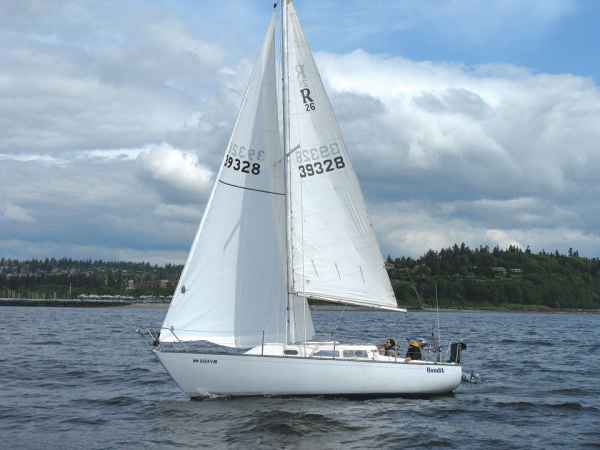
Conceived as a way to bridge the gap between a safe, comfortable, family cruiser and a competitive racer, Gary Mull’s Ranger 26 does exactly as it was designed to. Undeniably fast, (one won the 1970 IOR North American Half-Ton Cup) the boat sails as well as it looks. However speed isn’t the Ranger’s only strong-suit, with over 7 feet of cockpit there’s plenty of room for socializing after an evening of racing. The Ranger 26 sports a nice balance of freeboard and cabin height ensuring that a handsome profile wasn’t sacrificed for standing headroom. Click here to read more about the Ranger 26.
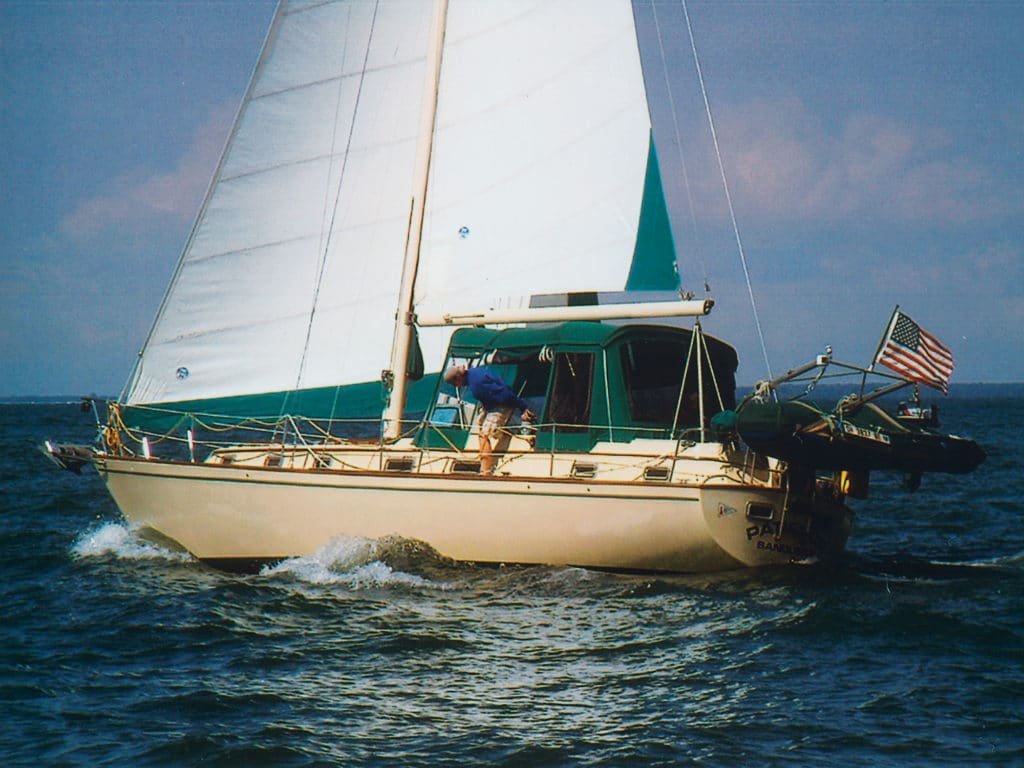
Catboats were once a common site in coastal waters, where they sailed the shallow bays as fishing or work boats. Their large single and often gaff-rigged sail provided plenty of power, and a centerboard made them well-suited for the thin waters they frequently encountered. In the late 1970s, Canadian builder Hinterhoeller introduced the Nonsuch 30, a fiberglass variation of the catboat design, with a modern Marconi sail flown on a stayless mast, and a keel instead of a centerboard. The boat’s wide beam made room below for a spacious interior, and the design caught on quickly with cruising sailors looking for a small bluewater sailboat. Click here to read more about the Nonsuch 30 .
– SHOW THEM HOW MUCH YOU CARE – Nothing says ‘I love you’ like making sure the kids’ life jackets are snugged up and properly buckled. Safety Tip Provided by the U.S. Coast Guard
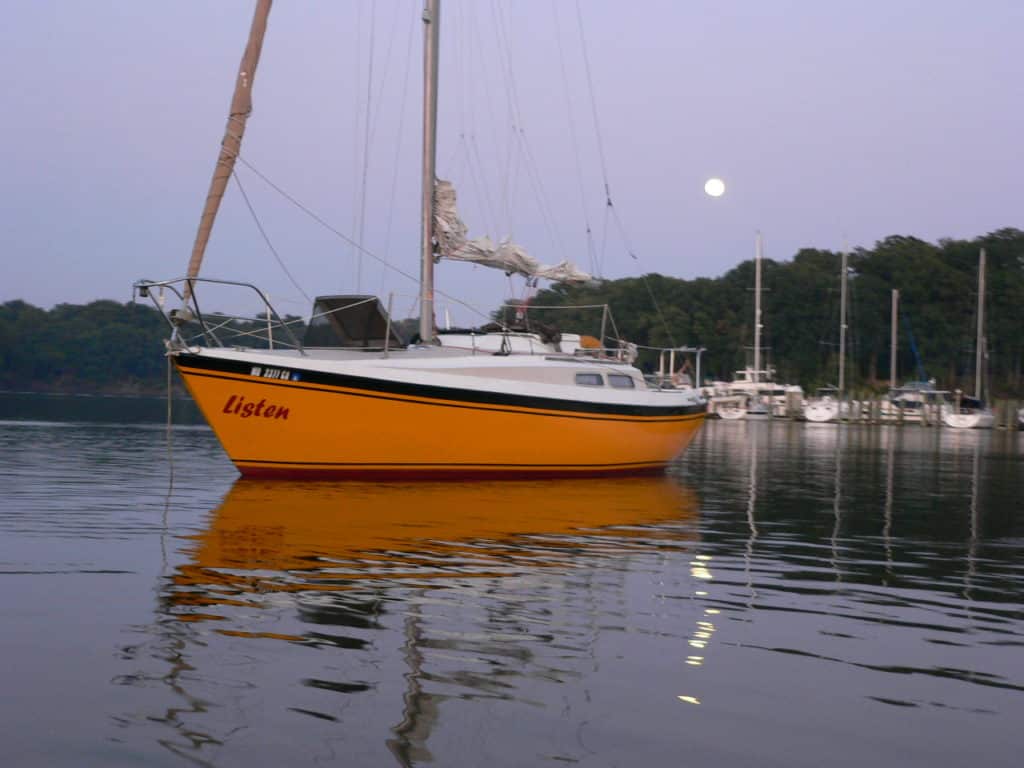
Debuted in 1971 in California, the Newport 27 was an instant success on the local racing scene. For a modest 27-footer, the Newport 27 has an unusually spacious interrior with over 6 feet of standing headroom. With 4 berths, a table, nav station, head and galley the Newport 27 has all the amenities you might find in a much bigger boat, all in a compact package. While quick in light air, the drawback of the tiller steering becomes apparent with increasing breeze and weather helm often leading to shortening sail early. Click here to read more about the Newport 27.
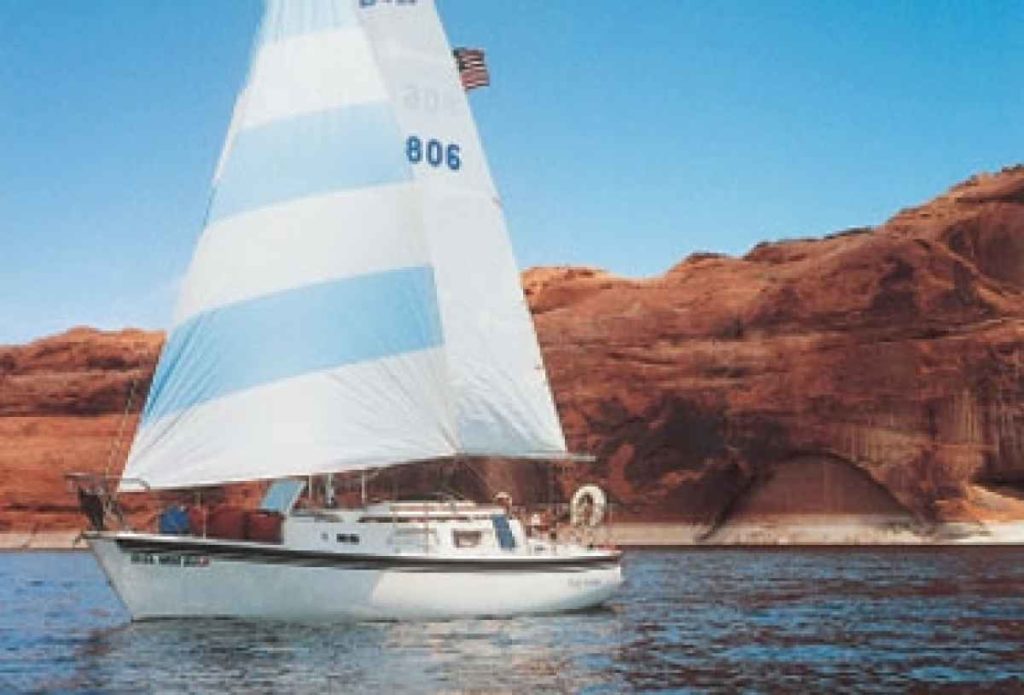
First splashed in 1969, the Balboa 26 continues to enjoy a strong following among budget-minded cruisers. Built sturdy and heavy, all of the boat’s stress points are reinforced. The spacious cockpit comfortably seats 4 and is self bailing, ensuring that sailors stay dry. While only 26 feet, the Balboa still has room for a double berth, galley with stove and freshwater pump, and an optional marine head or V-berth. The Balboa has the ability to sleep five, though the most comfortable number is two or three. Under sail, the Balboa is fast and maneuverable, but may prove a handful in heavy breeze as weather helm increases. Click here to read more about the Balboa 26.
Cape Dory 28
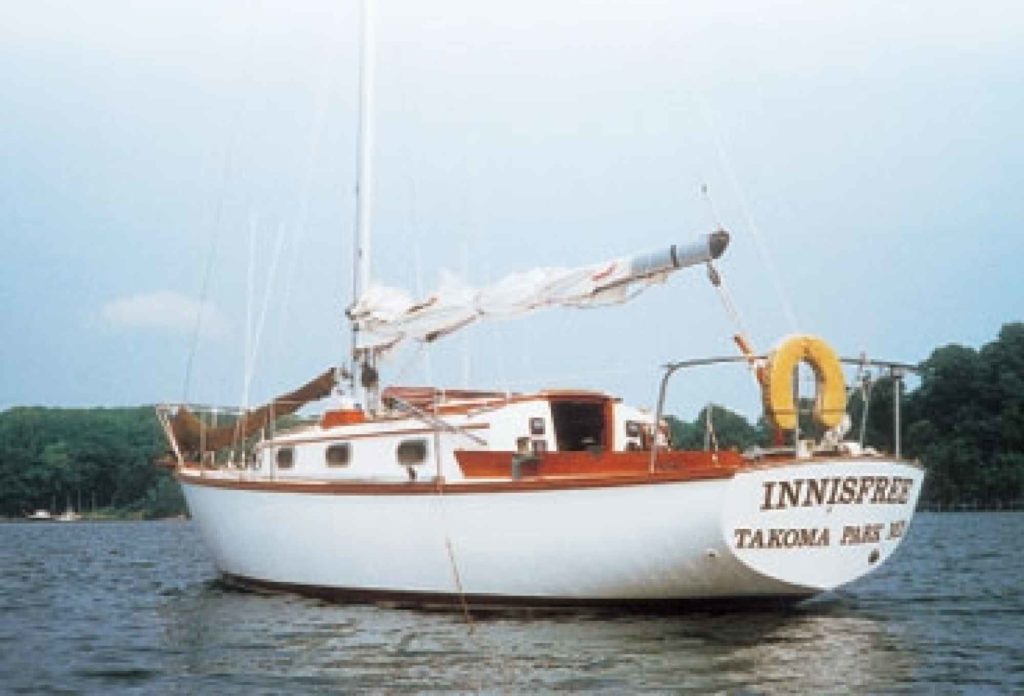
While the sleek lines and the teak accents of the Cape Dory 28 may grab the eye, it is the performance of the boat that make it unique. The Cape Dory comes with all amenities that you might need available, including a V-berth, 2 settees, and a head. Safe, sound and comfortable as a cruiser it is still capable of speed. Quick in light wind and sturdy and capable in heavy air, it is off the wind where the Cape Dory 28 shines with a balanced helm and the ability to cut through chop and still tack perfectly. Click here to read more about the Cape Dory 28.
Islander Bahama 28
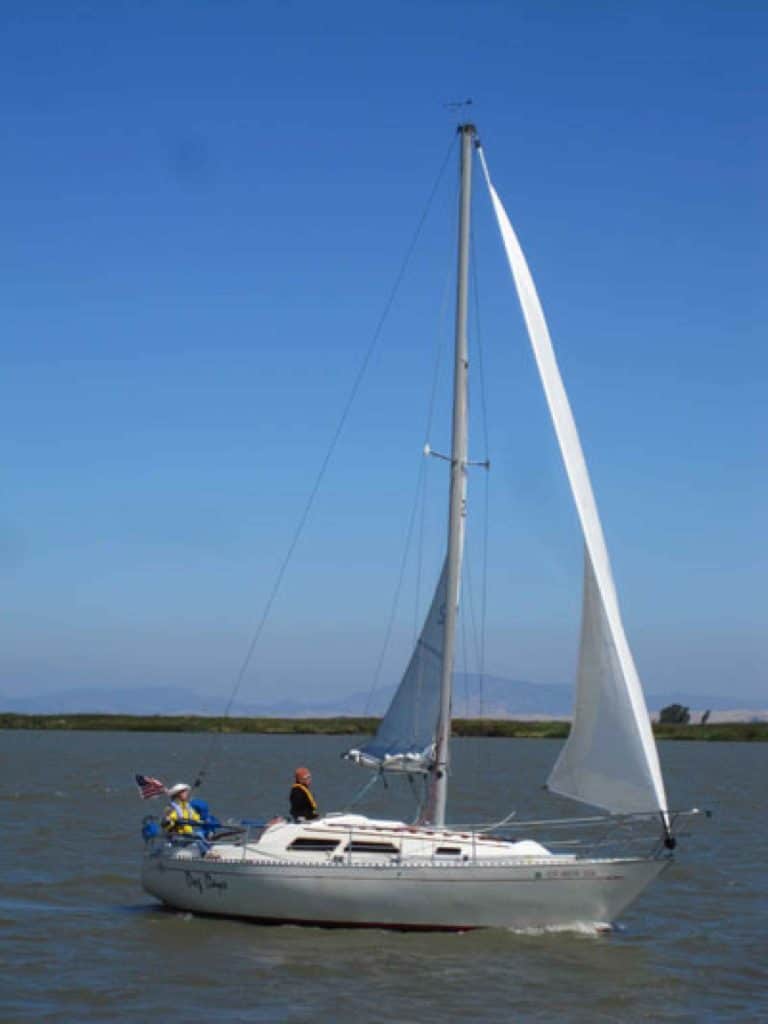
On top of being a real eye-catcher, the Islander Bahama 28, with its 5-foot-6-inch draft and 3,300 pounds of ballast, sails beautifully, tracks well, and responds quickly to the helm. Inspired by the International Offshore Rule, it is unusually wide, offering stability in breeze without sacrificing the sheer and lines that make it so attractive. Below deck, the Islander Bahama 28 comes standard with plenty of berths and storage space and a galley complete with stove, icebox and sink. Click here to read more about the Islander Bahama 28.
– CHECK THE WEATHER – The weather changes all the time. Always check the forecast and prepare for the worst case. Safety Tip Provided by the U.S. Coast Guard
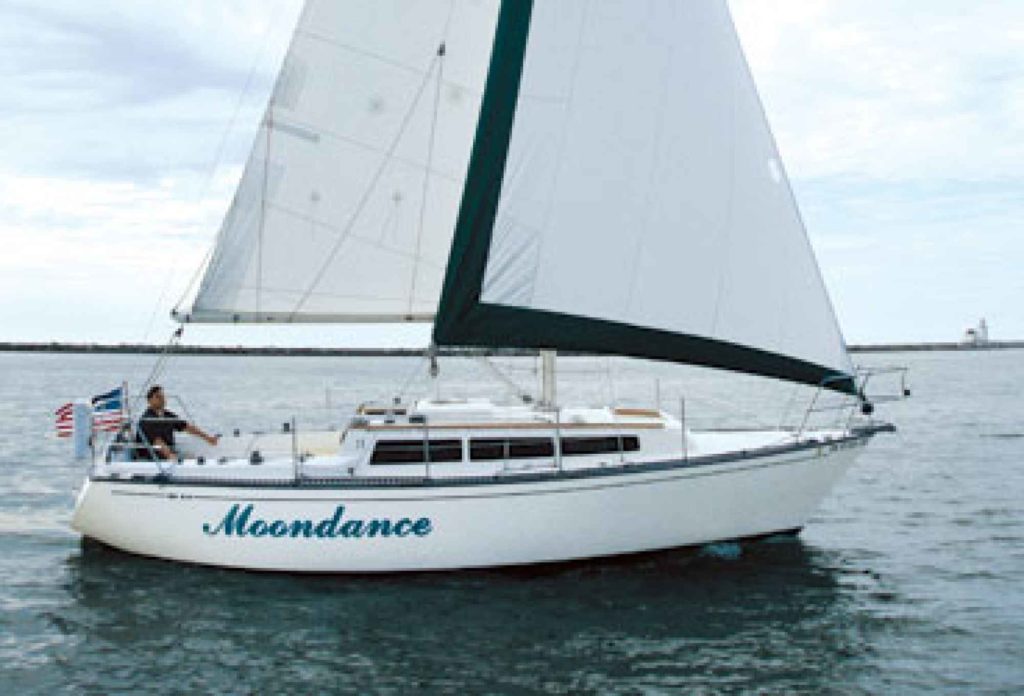
Much like its older sibling, the S2 8.6 still holds its contemporary style, despite its 1983 introduction. Like all other S2 Yachts, the 8.6 is recognized for the quality craftsmanship that allows the boat to hold up today.The S2 8.6 is a very comfortable and easily managed coastal cruiser and club racer. It’s relatively stiff, its helm feels balanced, and it tracks well. On most points of sail, it compares favorably with other boats of similar size and type. Click here to read more about the S2 8.6.
Contessa 26
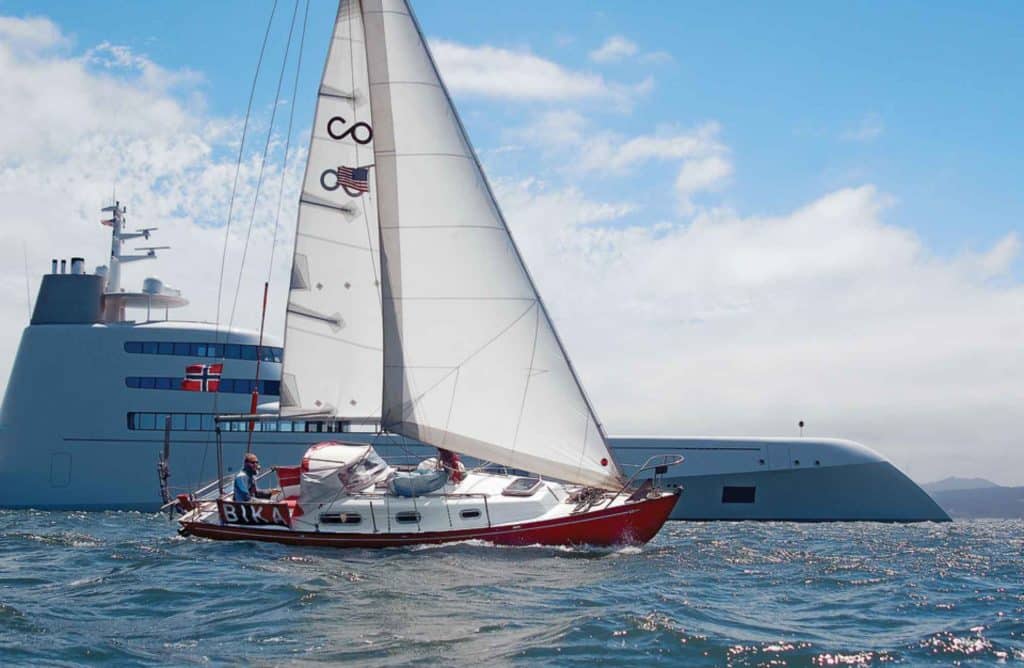
When the Contessa 26 was released in 1965, it immediately proved itself to be a strong, seaworthy vessel. The Contessa has continued to prove itself throughout its lifetime, being the boat of choice for two solo circumnavigations under the age of 21. While upwind performance leaves some wanting, the boat is sturdy and can carry full sail in up to 20 knots of breeze. Suited more for single-handing, the Contessa lacks standing headroom and the accommodations are sparse. Nonetheless, the Contessa 26 performs well as a daysailer with guests aboard. Click here to read more about the Contessa 26.
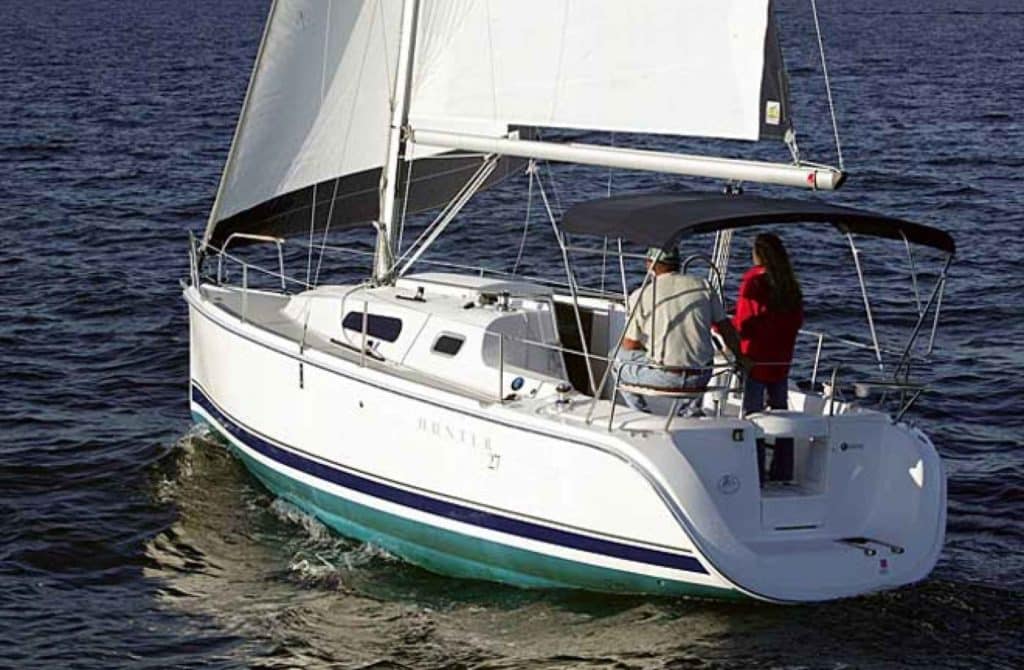
The Hunter 27 perfectly encompasses the pocket cruiser ideal. Even if you don’t want a big boat, you can still have big boat amenities. With the generously spacious layout, wheel steering and a walkthrough transom the Hunter feels much larger than 27 feet. Step below deck and any doubts you had that the Hunter was secretly a big boat will be gone. The amenities below are endless; a full galley including stove, microwave and cooler, head with full shower, several berths and not to mention a saloon with seating for 6. The Hunter 27 has reset the benchmark for 27-footers. Click here to read more about the Hunter 27.
- More: 21 - 30 ft , Boat Gallery , monohull , Sailboat Reviews , Sailboats , used boat guide
- More Sailboats

Pre-Owned: 1988 Hylas 47

Catalina Introduces the 6 Series

Sailboat Preview: Elan GT6 Explorer

For Sale: 1984 Camper & Nicholsons 58
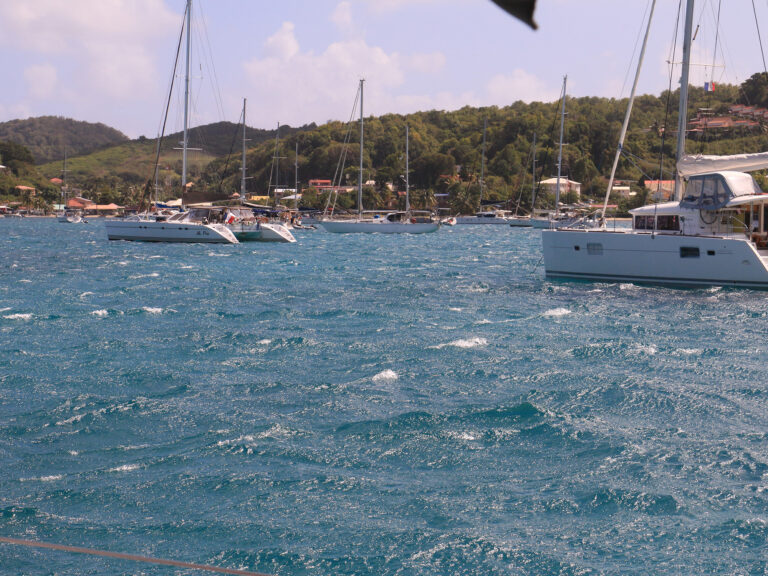
Understanding Wind in the West Indies
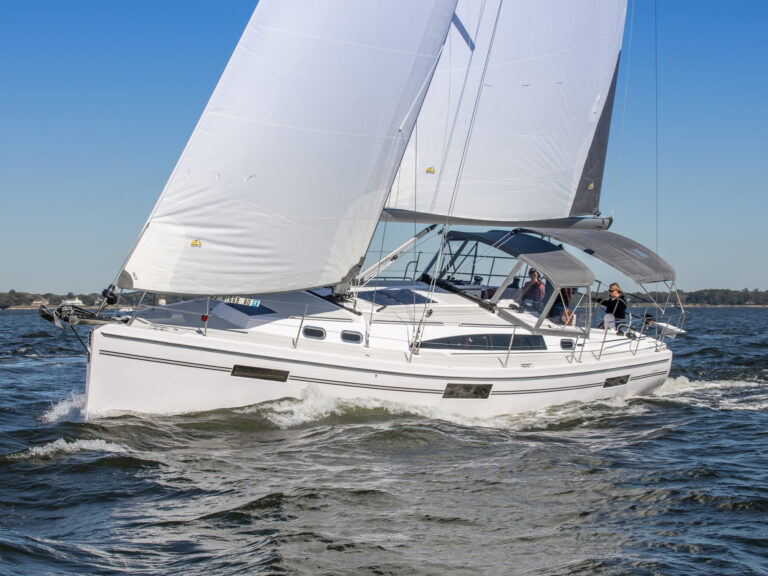
At Your Service

Galápagos: A Paradise Worth the Paperwork
- Digital Edition
- Customer Service
- Privacy Policy
- Terms of Use
- Email Newsletters
- Cruising World
- Sailing World
- Salt Water Sportsman
- Sport Fishing
- Wakeboarding
Small Sailboat Types: Choose the Perfect One For You
A boat's weight, draft, and sail area often affect its performance in different wind and water conditions. For this reason, sailors often prefer small sailboats because they are easy to handle, have simple rigging and sail plans, and are also more affordable. In this article, we'll help you choose the perfect type of small sailboat that fits your experience and budget.
The most common types of small sailboats include dinghies, daysailers, sloops, and catamarans. Dinghies are small, lightweight boats that are easy to launch and sail, while daysailers are slightly larger but more comfortable. Sloops are characterized by a single-mast rig, while a catamaran has two hulls, which provide stability.
To choose the right small sailboat for your needs, there are three important factors to keep in mind: your skill level, the intended use of the boat, and your budget limits. Let's find out how each of these factors can affect your choice.
- Dinghies are lightweight and easy to transport, but they can capsize easily, have limited space, and are not suitable for long distances or overnight trips.
- Daysailers are more spacious than dinghies, but they are heavier and less maneuverable.
- Small sloops are more spacious and comfortable than dinghies or daysailers; however, they are heavier and more expensive and require a larger vehicle or trailer for transport.
- Small catamarans are fast and fun to sail but may require more maintenance and are less comfortable than sloops for overnight trips.
- If you plan to race, you may want a boat that is lightweight and fast, such as the J/70 or the Melges 24, but for day sailing, opt for small sailboats like the Hobie 16 or the Flying Scot.
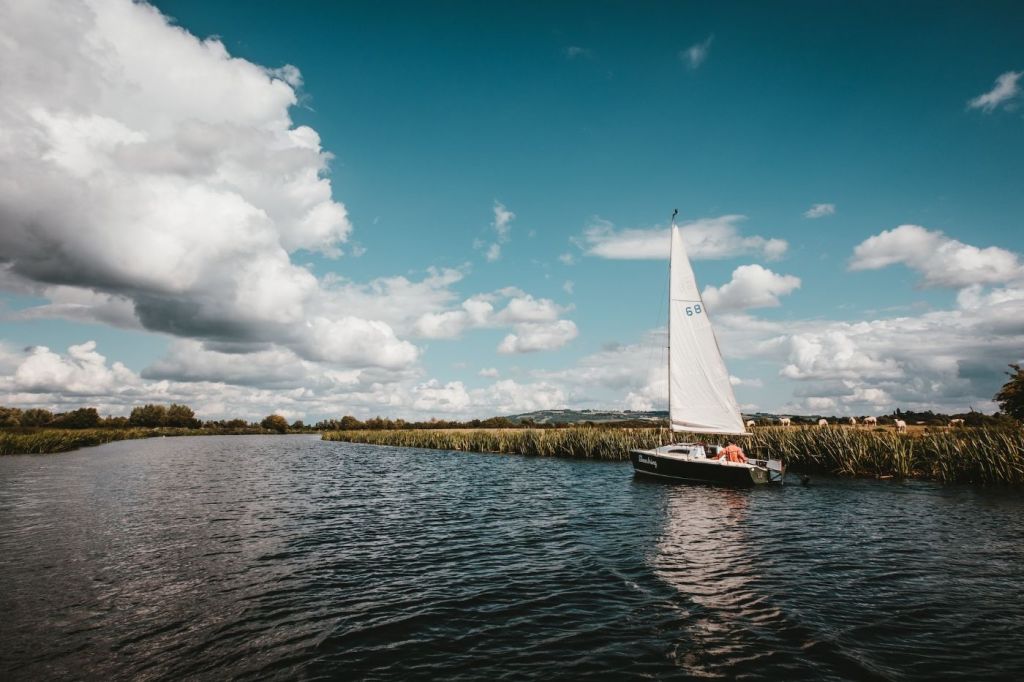
Types of Small Sailboats
Below is a table showing the different types of small sailboats and a short list of popular sailboats under each one:
| Small, lightweight sailboats that are easy to maneuver and great for learning basic sailing skills. | 6–15 feet in length | Optimist, Laser, Sunfish, 420, 29er | |
| Slightly larger sailboats that can accommodate small groups and are good for day trips and weekend outings. | 16–20 feet in length | Catalina 16.5, Flying Scot, Precision 15, O'Day Daysailer | |
| Larger sailboats that are more spacious and comfortable than dinghies or daysailers. Good for day trips and overnight trips. | 20–30 feet in length | Catalina 22, Hunter 22, J/22, San Juan 21 | |
| Fast and fun sailboats that can accommodate small groups and are good for day trips and weekend outings. | 14–20 feet in length | Hobie 16, Nacra 15, Prindle 16, Dart 16 |
Dinghy is a common type of small sailboat
A dinghy is a small sailboat that is typically used for racing or sailing in shallow water. It can be sailed by one or two people, and they are usually very lightweight and easy to handle.
They also cost less compared to other types of small sailboats. If you're curious as to how much a dinghy costs , here's an article for you.
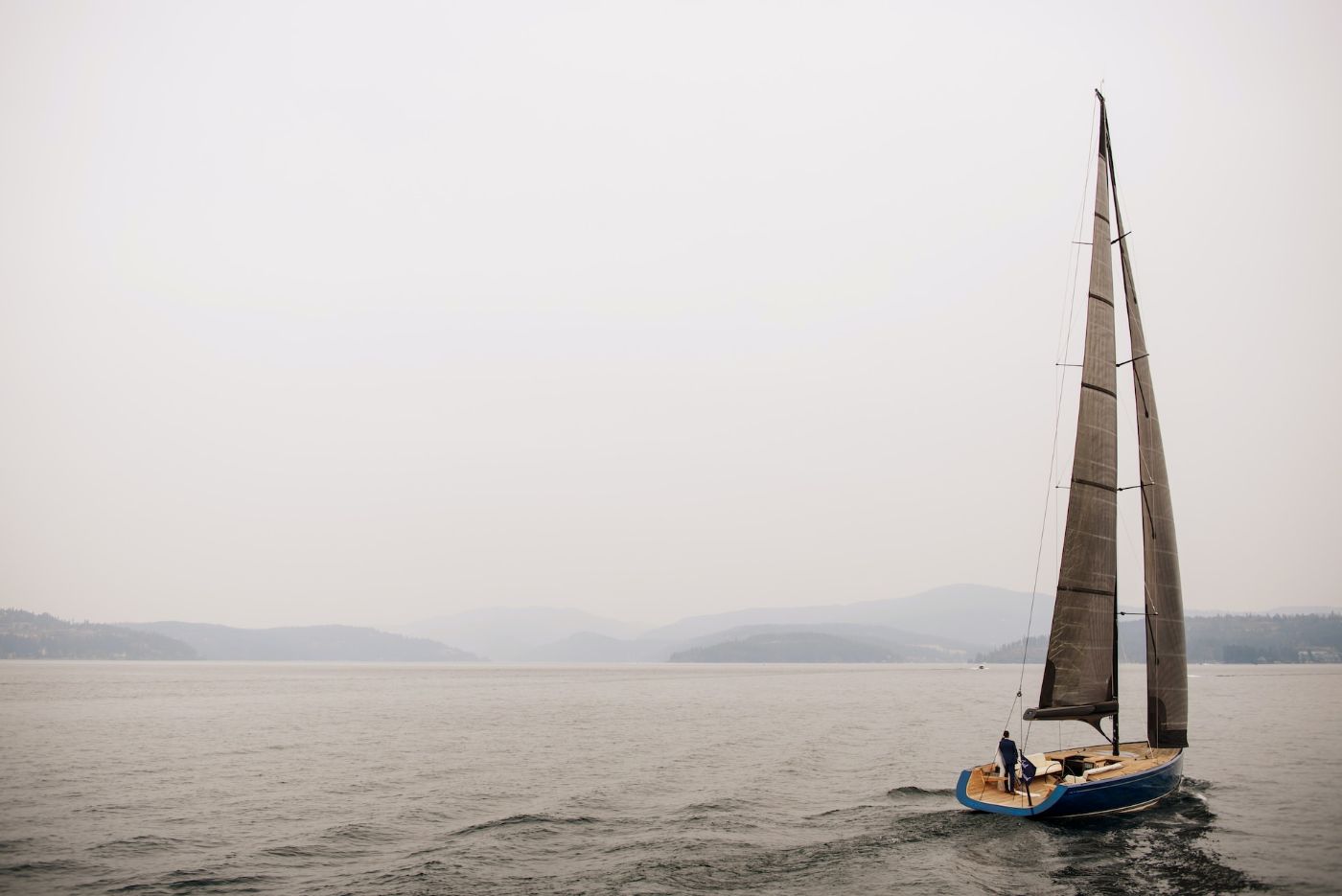
They are also very versatile and can be used for a variety of different sailing activities. Here are the pros and cons of choosing a dinghy:
- Pros: Lightweight and easy to transport, great for racing, maneuverable, good for learning basic sailing skills.
- Cons: Can capsize easily, limited space for passengers, not suitable for long distances or overnight trips.
To know which type of dinghy suits you best , you can read this article.
Daysailers are another popular small sailboat choice
Daysailers are slightly larger than dinghies and are designed for day sailing. They are usually between 16 and 20 feet in length and can be sailed by two or more people.
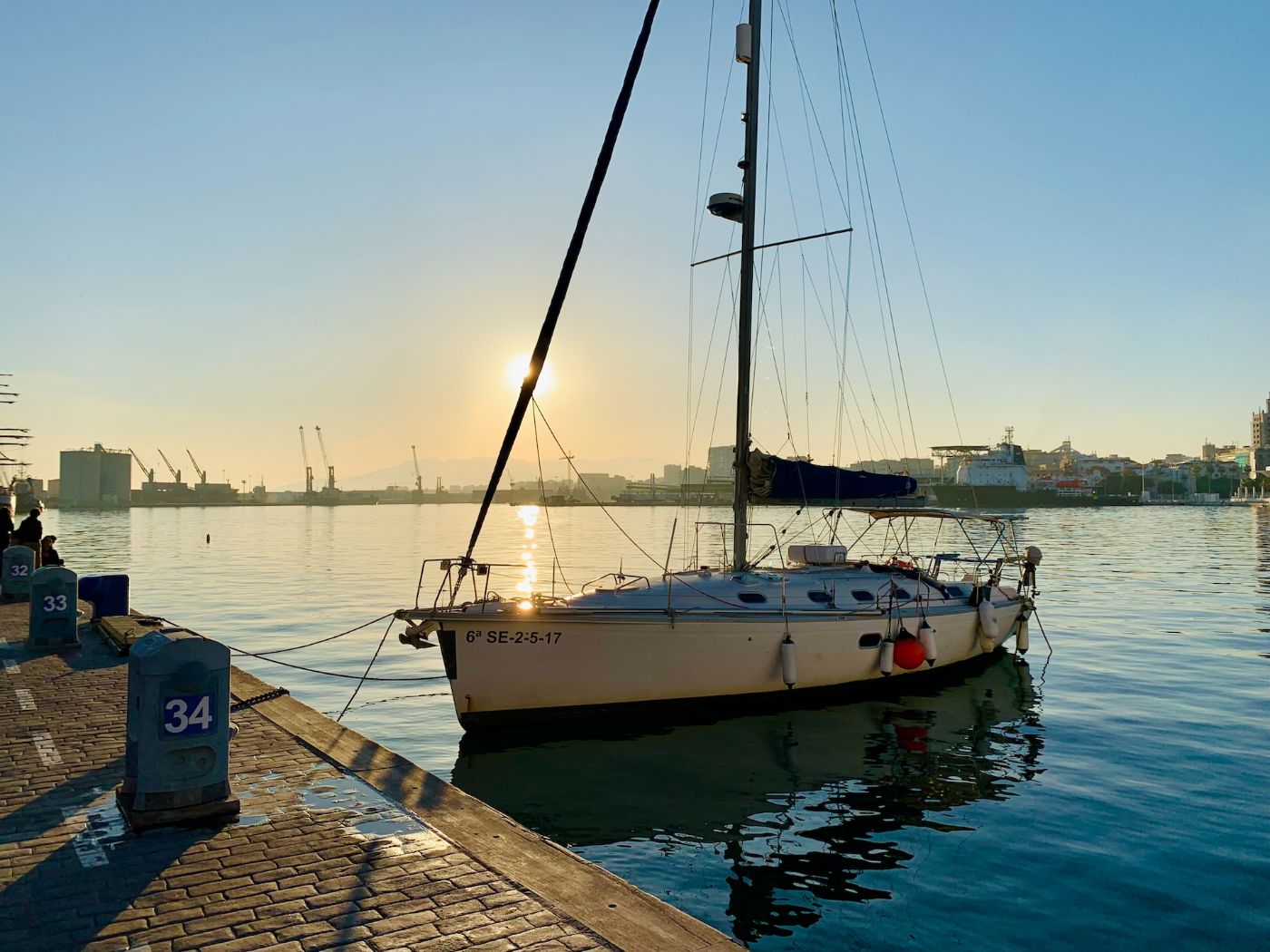
Daysailers are designed for comfort and ease of use, with features such as a small cabin or cockpit for shelter and storage. They are also often equipped with amenities such as a small galley or a portable toilet.
- Pros: More spacious than dinghies, can accommodate small groups, good for day trips and weekend outings, stable and easy to handle.
- Cons: Heavier and less maneuverable than dinghies, may require a trailer for transport, not suitable for long distances or overnight trips.
Small sloop is a classic and versatile small sailboat option
A sloop is a type of sailboat that has a single mast and a fore-and-aft rig. This means that the sails are set parallel to the centerline of the boat.
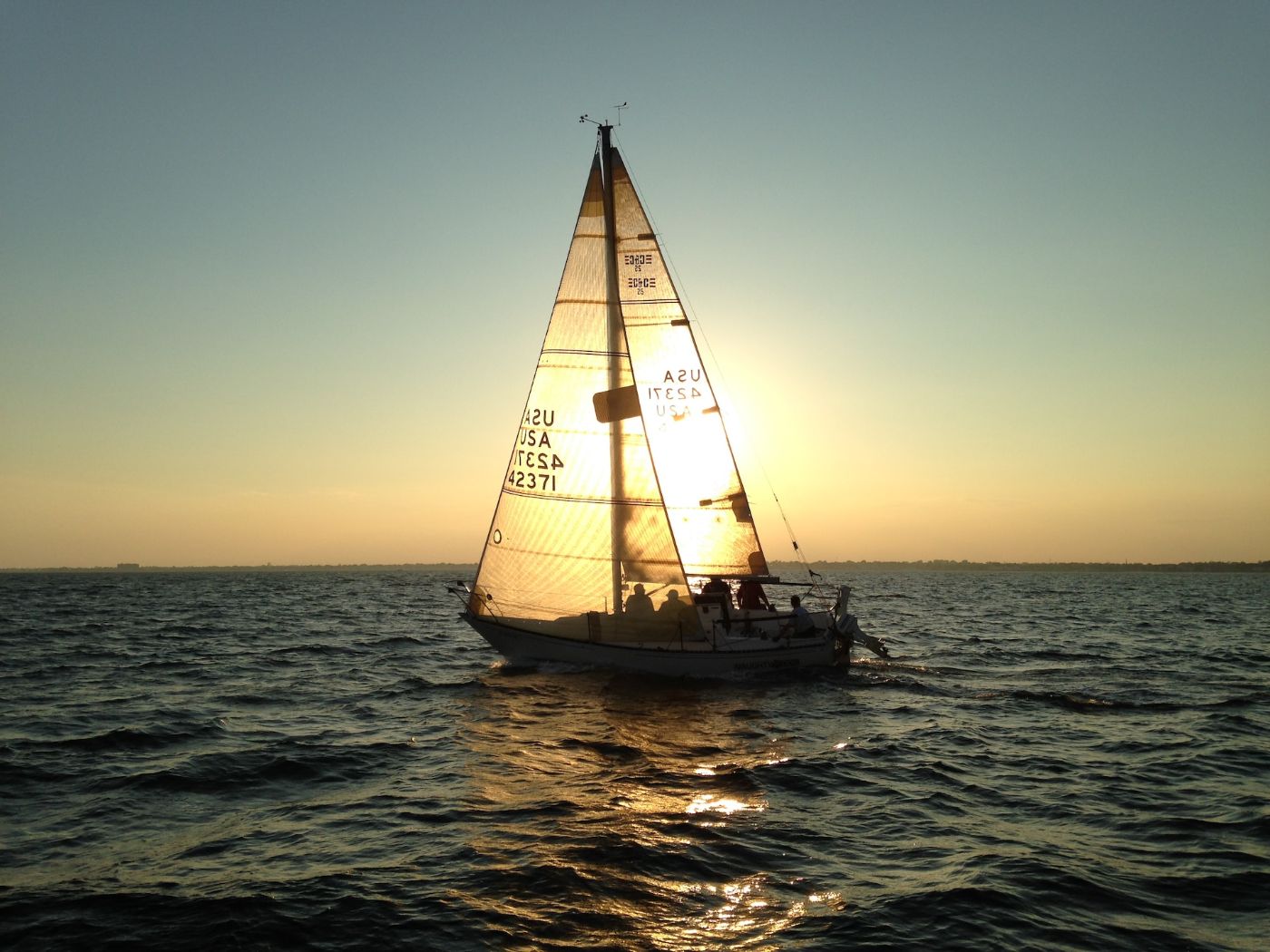
Sloops are one of the most popular types of sailboats because they are easy to handle and can be sailed by just one person. They are also very versatile and can be used for racing or cruising.
- Pros: More spacious and comfortable than dinghies or daysailers, can accommodate small groups, good for day trips and overnight trips, good for learning intermediate sailing skills.
- Cons: Heavier and more expensive than dinghies or daysailers, may require a larger vehicle or trailer for transport, may require more maintenance.
Small catamarans are a lightweight and stable small sailboat option
A catamaran is a type of sailboat that has two hulls instead of one. The hulls are connected by a trampoline, which provides a stable platform for sailing.
Catamarans are very fast and can be used for racing or cruising. They are also very spacious and can accommodate a lot of people.
- Pros: Fast and fun to sail, can accommodate small groups, good for day trips and weekend outings, stable and easy to handle.
- Cons: More expensive than dinghies or daysailers, may require a larger vehicle or trailer for transport, may require more maintenance, less comfortable than sloops for overnight trips.
If you want to know the costs of buying and owning a catamaran , either new or used, you might find this article helpful.
Small Sailboats for Different Skill Levels, Intended Use, And Budget
Below is a table showing how to choose a specific small sailboat model based on skill level, intended use, and budget:
| Beginner | Day sailing, learning | $1,000-$4,000 | |
| Intermediate-advanced | Racing, day sailing | $2,000-$9,000 | |
| Intermediate-advanced | Racing, day sailing | $5,000-$15,000 | |
| Intermediate-advanced | Cruising, day sailing | $10,000-$20,000 | |
| Advanced | Racing | $10,000-$30,000 |
Choosing the perfect small sailboat based on skill level
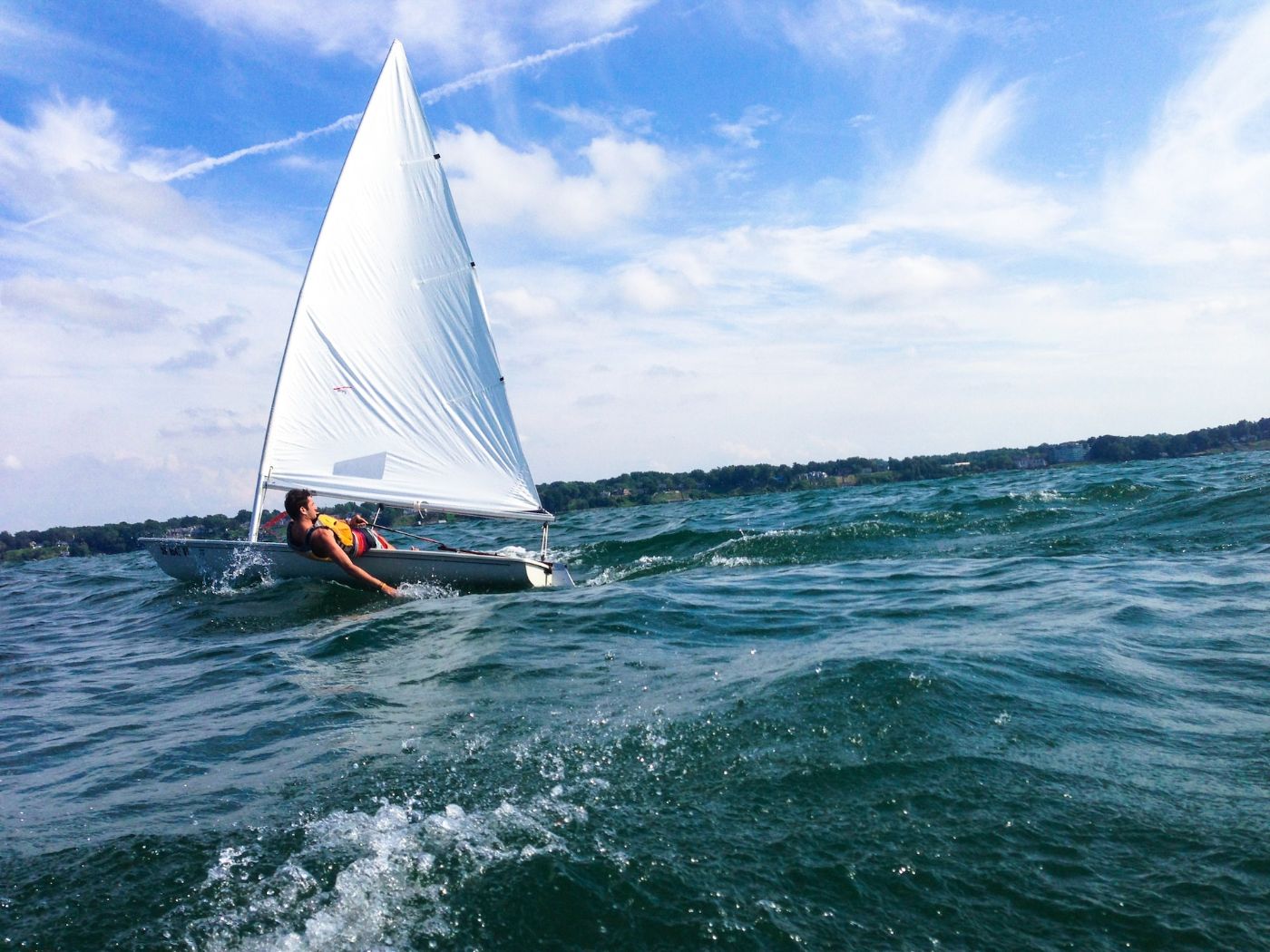
When choosing the perfect sailboat for you, try to choose a boat that matches your skill level so that you can enjoy sailing safely and comfortably.
Small sailboat for beginner sailors
If you are new to sailing, you may want to choose a small dinghy or daysailer that is easy to handle and control. Boats like the Sunfish or the Laser are popular choices for beginners, as they are lightweight and simple to rig.
These boats are also relatively forgiving, which means that they are less likely to capsize or cause injury if you make a mistake.
Small sailboat for intermediate sailors
If you have some sailing experience but are not yet an expert, you may want to consider a slightly larger boat that can handle more wind and waves.
Boats like the Catalina 22 or the Hunter 26 are popular choices for intermediate sailors, as they are larger and more stable than dinghies, but still relatively easy to handle. These boats also offer more amenities, such as a small cabin or a head, which can make them more comfortable for longer trips.
Small sailboat for advanced sailors
If you are an experienced sailor, you may want to choose a larger boat that can handle more challenging conditions. Boats like the J/105 or the J/120 are popular choices for advanced sailors, as they are designed for racing and cruising in open waters. These boats are more complex to rig and operate, but offer greater speed, stability, and control in high winds and waves.
Choosing the perfect small sailboat based on intended use
Are you planning to use the boat for day sailing, racing, or cruising? Different boats are designed for different purposes, so choose a boat that is well-suited for your intended use.
Small sailboat for day sailing
If you plan to use your boat for day sailing, you may want to consider a small dinghy or daysailer that is easy to launch and retrieve. Boats like the Hobie 16 or the Flying Scot are popular choices for day sailing, as they are fast and fun to sail in open waters. These boats are also relatively easy to rig and maintain, which makes them a great choice for recreational sailing.
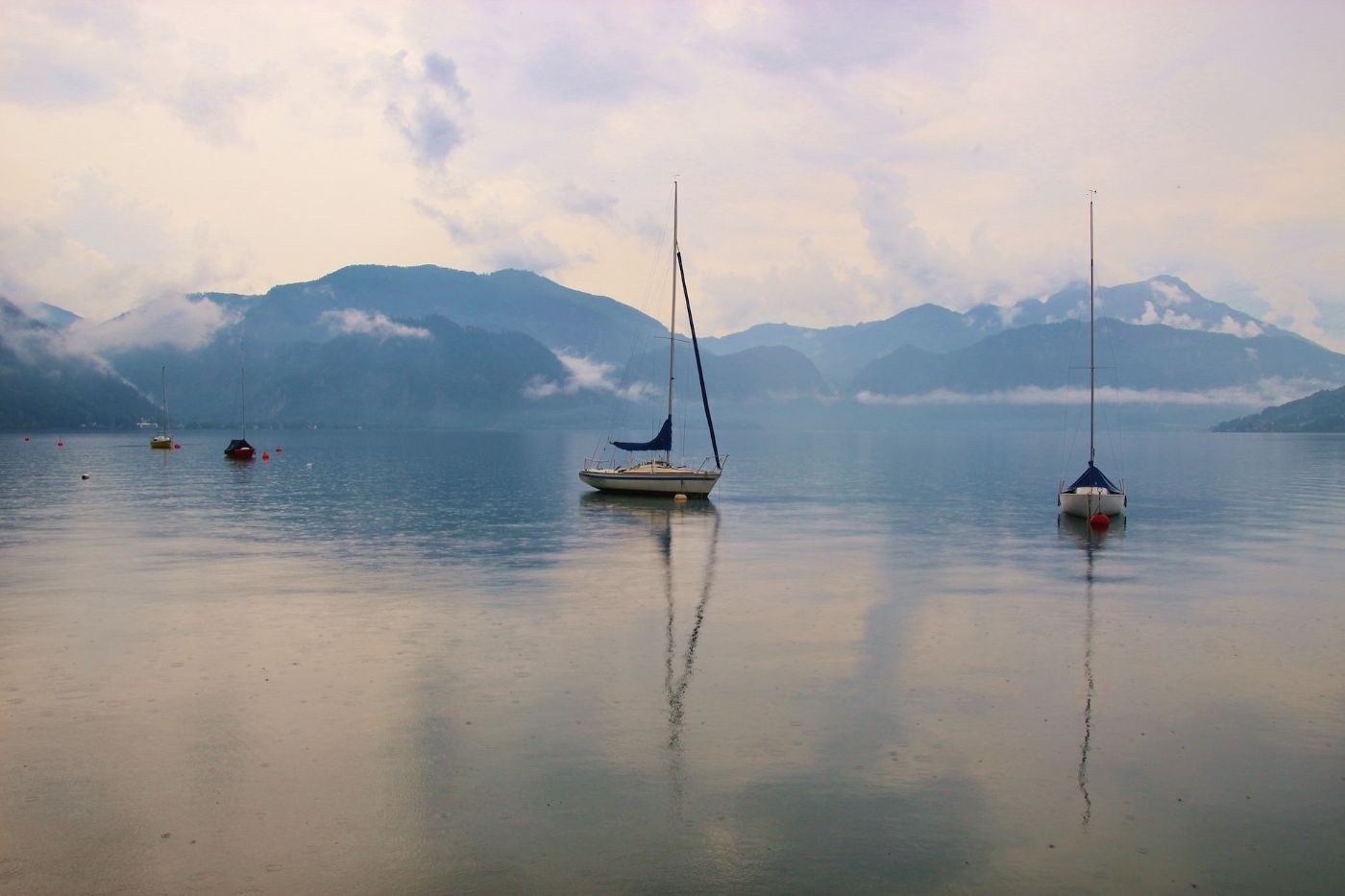
Small sailboat for racing
If you plan to use your boat for racing, you may want to consider a lightweight and fast boat that is designed for speed and agility. Boats like the J/70 or the Melges 24 are popular choices for racing, as they are designed to be fast and responsive in all conditions. These boats are also highly maneuverable, which makes them a great choice for competitive sailing.
Small sailboat for cruising
If you plan to use your boat for cruising, you may want to consider a boat that is more comfortable and has more amenities. Boats like the Catalina 27 or the Hunter 31 are popular choices for cruising, as they offer more space, storage, and comfort than smaller boats. These boats are also designed to be stable and seaworthy, which makes them a great choice for longer trips.
Choosing the perfect small sailboat depending on your budget
Consider choosing a boat that fits within your budget so that you don't overspend and end up with a boat that you can't afford to maintain or use. The price for used dinghies ranges from $1,000 to $5,000.
For used sailboats within 20–40 feet, the prices range from $5,000 to $50,000 . Keep in mind that there are also additional costs to consider, such as storage, maintenance, and repairs.
To get an idea of the pricing for used sailboats , you can use this article as a reference. Meanwhile, for the annual maintenance costs for sailboats , here's an article you can refer to.
Leave a comment
You may also like, how much does a dinghy cost (with 14 examples).
Once we bought our first real "overnight" boat, we had a wake-up call when we realized that we weren't done with the spending. If we wanted to go anywhere but a …
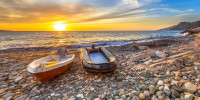
Types of Dinghies: How to Pick the Right One For You
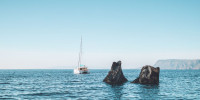
Average Cost of Buying & Owning a Catamaran (With 4 Examples)
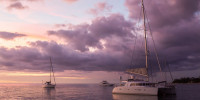
Cost of Catamaran vs. Monohull: Which is more expensive?
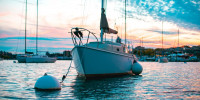
Average Sailboat Insurance Cost in 2023 (13 Examples)
Yachting Monthly
- Digital edition

25 of the best small sailing boat designs
- Nic Compton
- August 10, 2022
Nic Compton looks at the 25 yachts under 40ft which have had the biggest impact on UK sailing

There’s nothing like a list of best small sailing boat designs to get the blood pumping.
Everyone has their favourites, and everyone has their pet hates.
This is my list of the 25 best small sailing boat designs, honed down from the list of 55 yachts I started with.
I’ve tried to be objective and have included several boats I don’t particularly like but which have undeniably had an impact on sailing in the UK – and yes, it would be quite a different list if I was writing about another country.
If your favourite isn’t on the best small sailing boat designs list, then send an email to [email protected] to argue the case for your best-loved boat.
Ready? Take a deep breath…

Credit: Bob Aylott
Laurent Giles is best known for designing wholesome wooden cruising boats such as the Vertue and Wanderer III , yet his most successful design was the 26ft Centaur he designed for Westerly, of which a remarkable 2,444 were built between 1969 and 1980.
It might not be the prettiest boat on the water, but it sure packs a lot of accommodation.
The Westerly Centaur was one of the first production boats to be tank tested, so it sails surprisingly well too. Jack L Giles knew what he was doing.
Colin Archer

Credit: Nic Compton
Only 32 Colin Archer lifeboats were built during their designer’s lifetime, starting with Colin Archer in 1893 and finishing with Johan Bruusgaard in 1924.
Yet their reputation for safety spawned hundreds of copycat designs, the most famous of which was Sir Robin Knox-Johnston ’s Suhaili , which he sailed around the world singlehanded in 1968-9.
The term Colin Archer has become so generic it is often used to describe any double-ender – so beware!
Contessa 32
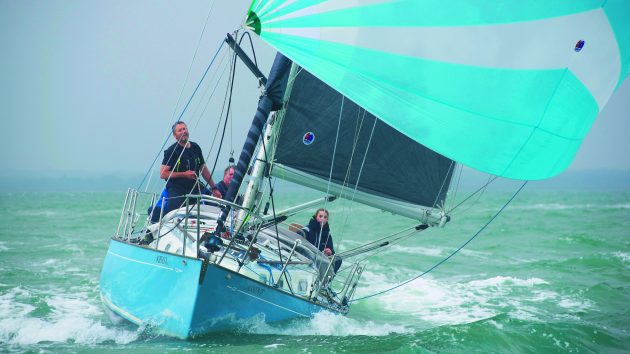
Assent ‘s performance in the 1979 Fastnet Race makes the Contessa 32 a worth entry in the 25 best small sailing boat designs list. Credit: Nic Compton
Designed by David Sadler as a bigger alternative to the popular Contessa 26, the Contessa 32 was built by Jeremy Rogers in Lymington from 1970.
The yacht’s credentials were established when Assent , the Contessa 32 owned by Willy Kerr and skippered by his son Alan, became the only yacht in her class to complete the deadly 1979 Fastnet Race .
When UK production ceased in 1983, more than 700 had been built, and another 20 have been built since 1996.
Cornish Crabber 24

It seemed a daft idea to build a gaff-rigged boat in 1974, just when everyone else had embraced the ‘modern’ Bermudan rig.
Yet the first Cornish Crabber 24, designed by Roger Dongray, tapped into a feeling that would grow and grow and eventually become a movement.
The 24 was followed in 1979 by the even more successful Shrimper 19 – now ubiquitous in almost every harbour in England – and the rest is history.
Drascombe Lugger
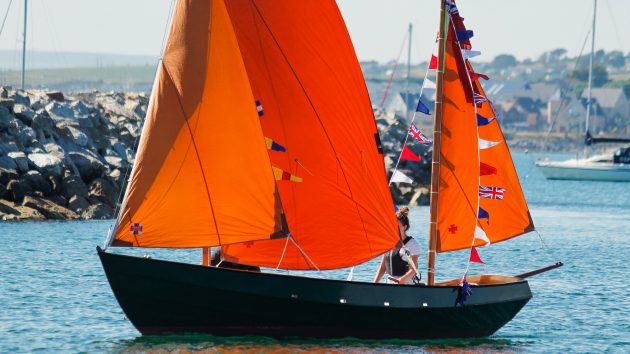
Credit: David Harding
There are faster, lighter and more comfortable boats than a Drascombe Lugger.
And yet, 57 years after John Watkinson designed the first ‘lugger’ (soon changed to gunter rig), more than 2,000 have been built and the design is still going strong.
More than any other boat, the Drascombe Lugger opened up dinghy cruising, exemplified by Ken Duxbury’s Greek voyages in the 1970s and Webb Chiles’s near-circumnavigation on Chidiock Tichbourne I and II .

The 26ft Eventide. Credit: David Harding
It’s been described as the Morris Minor of the boating world – except that the majority of the 1,000 Eventides built were lovingly assembled by their owners, not on a production line.
After you’d tested your skills building the Mirror dinghy, you could progress to building a yacht.
And at 24ft long, the Eventide packed a surprising amount of living space.
It was Maurice Griffiths’ most successful design and helped bring yachting to a wider audience.

You either love ’em or you hate ’em – motorsailers, that is.
The Fisher 30 was brought into production in 1971 and was one of the first out-and-out motorsailers.
With its long keel , heavy displacement and high bulwarks, it was intended to evoke the spirit of North Sea fishing boats.
It might not sail brilliantly but it provided an exceptional level of comfort for its size and it would look after you when things turned nasty.
Significantly, it was also fitted with a large engine.

Credit: Rupert Holmes
It should have been a disaster.
In 1941, when the Scandinavian Sailing Federation couldn’t choose a winner for their competition to design an affordable sailing boat, they gave six designs to naval architect Tord Sundén and asked him to combine the best features from each.
The result was a sweet-lined 25ft sloop which was very seaworthy and fast.
The design has been built in GRP since the 1970s and now numbers more than 4,000, with fleets all over the world.

Credit: Kevin Barber
There’s something disconcerting about a boat with two unstayed masts and no foresails, and certainly the Freedom range has its detractors.
Yet as Garry Hoyt proved, first with the Freedom 40, designed in collaboration with Halsey Herreshoff, and then the Freedom 33 , designed with Jay Paris, the boats are simple to sail (none of those clattering jib sheets every time you tack) and surprisingly fast – at least off the wind .
Other ‘cat ketch’ designs followed but the Freedoms developed their own cult following.
Hillyard 12-tonner

The old joke about Hillyards is that you won’t drown on one but you might starve to death getting there.
And yet this religious boatbuilder from Littlehampton built up to 800 yachts which travelled around the world – you can find them cruising far-flung destinations.
Sizes ranged from 2.5 to 20 tons, though the 9- and 12-ton are best for long cruises.

The innovations on Jester means she is one of the best small sailing boat designs in the last 100 years. Credit: Ewen Southby-Tailyour
Blondie Hasler was one of the great sailing innovators and Jester was his testing ground.
She was enclosed, carvel planked and had an unstayed junk rig.
Steering was via a windvane system Hasler created.
Hasler came second in the first OSTAR , proving small boats can achieve great things.

Moody kicked off the era of comfort-oriented boats with its very first design.
The Moody 33, designed by Angus Primrose, had a wide beam and high topside to produce a voluminous hull .
The centre cockpit allowed for an aft cabin, resulting in a 33-footer with two sleeping cabins – an almost unheard of concept in 1973 –full-beam heads and spacious galley.
What’s more, her performance under sail was more than adequate for cruising.
Finally, here was a yacht that all the family could enjoy.
Continues below…

What makes a boat seaworthy?
What characteristics make a yacht fit for purpose? Duncan Kent explores the meaning of 'seaworthy' and how hull design and…

How boat design is evolving
Will Bruton looks at the latest trends and innovations shaping the boats we sail


How keel type affects performance
James Jermain looks at the main keel types, their typical performance and the pros and cons of each

Boat handling: How to use your yacht’s hull shape to your advantage
Whether you have a long keel or twin keel rudders, there will be pros and cons when it comes to…
Nicholson 32

Credit: Genevieve Leaper
Charles Nicholson was a giant of the wooden boat era but one of his last designs – created with his son Peter – was a pioneering fibreglass boat that would become an enduring classic.
With its long keel and heavy displacement, the Nicholson 32 is in many ways a wooden boat built in fibreglass – and indeed the design was based on Nicholson’s South Coast One Design.
From 1966 to 1977, the ‘Nic 32’ went through 11 variations.

Credit: Hallberg-Rassy
In the beginning there was… the Rasmus 35. This was the first yacht built by the company that would become Hallberg-Rassy and which would eventually build more than 9,000 boats.
The Rasmus 35, designed by Olle Enderlein, was a conservative design, featuring a centre cockpit, long keel and well-appointed accommodation.
Some 760 boats were built between 1967 and 1978.

Credit: Larry & Lin Pardey
Lyle Hess was ahead of his time when he designed Renegade in 1949.
Despite winning the Newport to Ensenada race, the 25ft wooden cutter went largely unnoticed.
Hess had to build bridges for 15 years before Larry Pardey asked him to design the 24ft Seraffyn , closely based on Renegade ’s lines but with a Bermudan rig.
Pardey’s subsequent voyages around the world cemented Hess’s reputation and success of the Renegade design.

Would the Rustler 36 make it on your best small sailing boat list? Credit: Rustler Yachts
Six out of 18 entries for the 2018 Golden Globe Race (GGR) were Rustler 36s, with the top three places all going to Rustler 36 skippers.
It was a fantastic endorsement for a long-keel yacht designed by Holman & Pye 40 years before.
Expect to see more Rustler 36s in the 2022 edition of the GGR!

It was Ted Heath who first brought the S&S 34 to prominence with his boat Morning Cloud .
In 1969 the yacht won the Sydney to Hobart Race, despite being one of the smallest boats in the race.
Other epic S&S 34 voyages include the first ever single-handed double circumnavigation by Jon Sanders in 1981

Credit: Colin Work
The Contessa 32 might seem an impossible boat to improve upon, but that’s what her designer David Sadler attempted to do in 1979 with the launch of the Sadler 32 .
That was followed two years later by the Sadler 29 , a tidy little boat that managed to pack in six berths in a comfortable open-plan interior.
The boat was billed as ‘unsinkable’, with a double-skinned hull separated by closed cell foam buoyancy.
What’s more, it was fast, notching up to 12 knots.

Credit: Dick Durham/Yachting Monthly
Another modern take on the Contessa theme was the Sigma 33, designed by David Thomas in 1979.
A modern underwater body combined with greater beam and higher freeboard produced a faster boat with greater accommodation.
And, like the Contessa, the Sigma 33 earned its stripes at the 1979 Fastnet, when two of the boats survived to tell the tale.
A lively one-design fleet soon developed on the Solent which is still active to this day.

A replica of Joshua Slocum’s Spray . Credit: Alamy Stock Photo
The boat Joshua Slocum used for his first singlehanded circumnavigation of the world wasn’t intended to sail much further than the Chesapeake Bay.
The 37ft Spray was a rotten old oyster sloop which a friend gave him and which he had to spend 13 months fixing up.
Yet this boxy little tub, with its over-optimistic clipper bow, not only took Slocum safely around the world but has spawned dozens of modern copies that have undertaken long ocean passages.

Credit: James Wharram Designs
What are boats for if not for dreaming? And James Wharram had big dreams.
First he sailed across the Atlantic on the 23ft 6in catamaran Tangaroa .
He then built the 40ft Rongo on the beach in Trinidad (with a little help from French legend Bernard Moitessier) and sailed back to the UK.
Then he drew the 34ft Tangaroa (based on Rongo ) for others to follow in his wake and sold 500 plans in 10 years.

Credit: Graham Snook/Yachting Monthly
The Twister was designed in a hurry.
Kim Holman wanted a boat at short notice for the 1963 season and, having had some success with his Stella design (based on the Folkboat), he rushed out a ‘knockabout cruising boat for the summer with some racing for fun’.
The result was a Bermudan sloop that proved nigh on unbeatable on the East Anglian circuit.
It proved to be Holman’s most popular design with more than 200 built.

Credit: Alamy Stock Photo
Laurent Giles’s design No15 was drawn in 1935 for a Guernsey solicitor who wanted ‘a boat that would spin on a sixpence and I could sail single-handed ’.
What the young Jack Giles gave him was a pretty transom-sterned cutter, with a nicely raked stem.
Despite being moderate in every way, the boat proved extremely able and was soon racking up long distances, including Humphrey Barton’s famous transatlantic crossing on Vertue XXXV in 1950.
Wanderer II and III

Credit: Thies Matzen
Eric and Susan Hiscock couldn’t afford a Vertue, so Laurent Giles designed a smaller, 21ft version for them which they named Wanderer II .
They were back a few years later, this time wanting a bigger version: the 30ft Wanderer III .
It was this boat they sailed around the world between 1952-55, writing articles and sailing books along the way.
In doing so, they introduced a whole generation of amateur sailors to the possibilities of long-distance cruising.
Westerly 22

The origins of Westerly Marine were incredibly modest.
Commander Denys Rayner started building plywood dinghies in the 1950s which morphed into a 22ft pocket cruiser called the Westcoaster.
Realising the potential of fibreglass, in 1963 he adapted the design to create the Westerly 22, an affordable cruising boat with bilge keels and a reverse sheer coachroof.
Some 332 boats were built to the design before it was relaunched as the Nomad (267 built).
Enjoyed reading 25 of the best small sailing boat designs?
A subscription to Yachting Monthly magazine costs around 40% less than the cover price .
Print and digital editions are available through Magazines Direct – where you can also find the latest deals .
YM is packed with information to help you get the most from your time on the water.
- Take your seamanship to the next level with tips, advice and skills from our experts
- Impartial in-depth reviews of the latest yachts and equipment
- Cruising guides to help you reach those dream destinations
Follow us on Facebook , Twitter and Instagram.

12 Best Catamaran Sailboats

The appeal of the catamaran sailboats in terms of speed , stability, and the ability to embark on long-range cruising has made them hugely popular with today's sailors. But what are the best catamaran sailboats?
Even though catamaran sailboats have become increasingly popular in the last few years, they have a truly rich legacy as one of the most sought after vessels for bluewater cruising.
Thanks to their incredibly wide beams and bigger daft, catamarans have become remarkably favorable for sailors looking to go for long-distance voyages, overnight cruising, and day sailing.
And if space is paramount for you when out there on the water, a catamaran sailboat is the only way to go as they offer extraordinary space to allow you to spend more time on the water with friends and family.
But even with all these amazing features, you're probably still wondering; what are the best catamaran sailboats?
Like their monohull counterparts, choosing the best catamaran sailboat can be quite overwhelming since there are lots of them out there. They come in a wide variety of designs and sizes ranging from small catamarans to huge ones.
The best catamaran sailboats can easily clock 250-mile voyages, offer incredible performance, and have layouts that can be easily optimized for individuals, charter markets, and great accommodation. In essence, the best catamaran sailboats offer respectable performance and offer good load-carrying ability.
That being said, here are some of the best catamaran sailboats that you can get your hands on.
Table of contents
Best Catamarans
{{boat-info="/boats/manta-42"}}
Even though many multihulls are no longer built in the United States these days, the Manta 42 is a true American-built catamaran that brings good living and good value into one package. Designed cleverly for easy handling, this American built catamaran is a great choice for a liveaboard cruiser for sailors looking to go for long-distance voyages. Thanks to its trademark high bows and an enormously curved incorporated forward crossbeam, this catamaran is easily recognizable even from a distance.
It is designed with a uniquely fixed crossbeam, which is very different from conventional aluminum cross beams that support the tension of the forestay. This fixed crossbeam allows for a little bit of movement thereby helping in absorbing enormous twisting forces of the bows. As such, you have to keep in mind that there may be resultant stress crack particularly in the bow area of the vessel.
All in all, the Manta 42 is a superb offshore cruising catamaran that offers a good sail-area-to-displacement ratio as well as plenty of space and accommodation. The cockpit area is refined, luxurious, and is designed with additional stainless pushpit contraptions to help in holding objects such as wind vanes, dinghies, and solar panels. The boat's quality in terms of performance and stability is the benchmark of what a catamaran should be.
Fountaine Pajot Elba 45
{{boat-info="/boats/fountaine-pajot-elba-45"}}
Recently named the "Boat of the Year" for 2019 by Cruising World Magazine and Sail Magazine, the Elba 45 is the latest model in the incredible line of Fountaine Pajot catamarans. This boat was designed to replace the outgoing Helia 44 and stands to be one of the most popular catamarans with Fountain Pajot having sold over 100 Elba 45 hulls long before even the first one emerged from production.
This French-built cat brings to the fore a well-thought-out, safe, and dependable features with 10% less drag, efficient motoring, top-notch performance, and high speeds. It's also designed with fixed stub keels and slightly aft-raked bows, which are all essential in enhancing windward performance; something that most catamarans struggle with.
To improve on safety, the keels of this amazing catamaran sailboat are glued into a particularly designed recess in the hulls. This is to ensure that there are no keel bolts that can rip out and put the boat in danger if the boat gets grounded or in the event of a collision. The rig is also ICW friendly and is a true representation of a standard catamaran setup.
This is, without a doubt, a modern-looking cruising catamaran that has a low-profile lounging space on its deck, high topsides and bows as well as a more pronounced reverse sheer that's essential in minimizing the bulk of the windows while creating additional and useful volume below. This is a true catamaran that occupies a sweet spot for those looking to sail along the bay or for those adventurous sailors looking to set sail for more ambitious offshore cruising plans.
{{boat-info="/boats/leopard-48"}}
With its fine design, straightforward systems, and easy handling, the Leopard 48 has everything it needs to be ranked among the distinguished category of the best catamaran sailboats. This is an excellent multihull that is structured with advanced materials, designs, and innovations that are meant to be fun, spacious, and comfortable.
Designed in South Africa by Simonis-Voogd, is probably the best design in the Leopard family of catamarans. Its two hulls are vacuum-bagged using balsa core to offer maximum firmness while ensuring that the weight is on the minimum. This is done by articulately regulating the level of resin in the layup. With such types of hull shapes, this catamaran sailboat is very fast and can consistently clock 12 knots of speed against the currents.
The boat is also designed with shallow keels as they're filled with closed-cell polyurethane foam that's of great importance in increasing buoyancy and preventing water ingress. To enhance the safety of the vessel, the stern and bow both have bulkheads that are essential in keeping out that water if the sailboat is involved in a collision.
The hulls of this boat are deep and narrow, particularly below the waterline. They also curve higher up to practically reduce the wetted surface area while offering enough deck space and plenty of room for accommodations. Its cockpit is another excellent feature thanks to its lavish spaces that give you the chance of kicking back and relaxing.
This boat is designed to offer superior livability, quick and easy to handle features, as well as enough space for friends and family. It is designed with beautiful lines and immense practicality for those who want to go on long cruising voyages.
Antares 44i
While many people often believe that voluminous cruising catamarans should be used as charter boats, the Antares 44i brings a very different perspective altogether. Designed in Argentina as a complete bluewater catamaran, this is a boat that's specifically built for private boat owners looking for a sturdy and well-equipped bluewater cruiser. This is an absolutely gorgeous catamaran that has a fully-equipped cockpit just to ensure that you can safely operate it even when shorthanded.
Like most catamarans, the Antares 44i is designed with features that allow for long-distance voyages. It comes with a minimum bridge deck clearance of 30 inches, which is essential in mitigating bridge deck slap. The helm station is designed to offer excellent visibility over the coach roof without having to perch the helmsman high above the cockpit.
If you're planning to make those long-distance cruising to exotic places, you'll appreciate this boat's layout. The galley is put down in the port hull so that it doesn't compromise the size of the galley and the saloon. The forward-facing navigation station is up there with the best and is up to offshore standards. And that's not all; the Antares 44i comes with good mounting points for electronics, a large table, comfortable seats, and provides brilliant visibility outside.
This boat is perfectly suited for extended offshore cruising and is a great reminder for anyone who thinks that all catamarans are charter boats and all offshore boats are monohulls.
{{boat-info="/boats/dolphin-ocema-42"}}
Designed by Philipe Pouvreau in northern Brazil, the Dolphin Ocema 42 is a truly unique catamaran sailboat that goes against the conventional norm of catamarans. It is equipped with daggerboards, which are essential in enabling it to point higher on the wind while reducing the wetted surface when running or anchoring in shallow surfaces. This, however, requires a higher level of expertise in sailing. This is because lifting the daggerboards higher up will expose the rudders while the daggerboards can also interfere with the hulls in the event that the vessel runs aground.
But even with that, the Dolphin 42 balances incredible performance and cruising comfort in a very compact package; something that is not very easy in bluewater cruising. That's why it's designed using a foam core to make it lightweight by reducing weight wherever possible. This vessel will most likely never let you down if you want to circumnavigate the bluewater on a high-performance boat that is safe and comfortable.
So if you've been looking for a real sailing catamaran that doubles up as a very comfortable liveaboard sailboat , look no further than the Dolphin 42.
{{boat-info="/boats/catana-50"}}
Regarded as the best built and most stylish cruising multihull, the Catana 50 is a very huge catamaran sailboat. Measuring about 50 feet long with a beam of about 26 feet, this is an amazing catamaran that will test your sailing skills as a single sailor or if you're planning to sail shorthanded.
This boat is designed with a rig that gives you the option of using either a screecher or a self-tending jib. This may seem complex since the sheets are led to winches near each wheel while all other controls lead to a centerline winch that's located in the cockpit. But even with that, this sailboat can be easily tacked once on the course.
This is a real performance-oriented catamaran with efficient hulls and rigs allowing for top speed. This vessel is also designed with a long waterline and a subtle underwater shape at the bow to help in increasing volume while minimizing wave drag. The stern platforms can help in stretching the waterline length while also providing easy access from a dock or a dinghy. The board trunks are also very strong and sturdy to protect the integrity of the hulls if a collision occurs.
In essence, this is a very modern catamaran that's designed to safely make long-distance passages with ease. It is subdued in terms of styling but this doesn't mean that it falls short as far as performance is concerned.
Atlantic 42
{{boat-info="/boats/atlantic-42"}}
Designed in 1993, the A42 has cultivated a legion of fiercely loyal fans thanks to its efficiency and aesthetic. This is the smallest of the Atlantic cruising catamaran line and is hugely popular with sailors thanks to its ease of handling, ocean-going capabilities, and superb use of space. From the forward cockpit, pilothouse to the sleeping cabins, and brilliant galleys everything about this cat is a true classic.
Unlike most catamarans, the Atlantic 42 is designed with a waist-high cockpit that's located forward of the pilothouse just behind the mast. It brings forth a solid construction thanks to the large metal girder-like bearers that run across the bulkheads. This helps the vessel in having the utmost strength, better air circulation under the engine, and a high level of flexibility as far as the size of the engine and its positioning is concerned.
Initially, the boat's style and its outlook were considered conservative but it soon became clear that it is built of high-quality materials and to last. The internal construction of the boat is impressive, to say the least. The exterior looks very beautiful and perhaps much more beautiful than most boats today. Its large aft cabin accommodation is a top drawer while the space separating en suite heads and shower compartments are considered a bonus.
{{boat-info="/boats/fountaine-pajot-bahia-46"}}
If you were to board the French-built Fountaine Pajot Bahia 46, you'll agree that the high-quality of workmanship, layout, and efficient use of space is quite exciting, to say the least. This cat remains very popular among sailors thanks to its easy handling features and incredible performance under the sails. Well, this may not come as a surprise to many of us given that the Fountain Pajot is known for building some of the most remarkable cruising catamarans out there that it can be quite overwhelming to narrow down to a single vessel, but the Bahia 46 simply stands out.
This vessel is designed with hulls that are broader than those of many other catamarans. It's also designed with centerboards and daggerboards that are meant to enhance its performance. These are essential in minimizing draft while ensuring reliability, generous bilge, and in helping to protect the rudders and propellers.
This boat is big enough to manage any type of serious offshore sailing. This is one of the best cruising catamarans for anyone looking for the right vessel for long-distance sailing. This vessel has a very more generous rig than most cruising catamarans, which is essential in enhancing its performance. The six-post Bimini is very strong and clean and can perfectly hold dinghies.
In terms of its look, the Bahia 36 is designed with gorgeous lines with the deck and hulls sculpted with lines that add a touch of elegance to the overall look of an already excellent catamaran sailboat.
Gemini 105MC
{{boat-info="/boats/gemini-105mc"}}
Whether you're looking for a comfortable catamaran vessel to take you for a weekend sailing trip or a long sabbatical vacation on the oceans, the Gemini 105MC is a very satisfactory liveaboard catamaran vessel that offers spacious accommodation, thoughtful design, and a stable cruising platform for anyone who wants to have some good time on the water.
Designed by the legendary Tony Smith, this is somewhat a sailing cottage. Like a land cottage, it is cozy, comfortable, and very safe. This is essentially a 35 feet catamaran that offers great value for any sailing looking for a reasonably-priced catamaran sailboat for the weekend or holiday cruising.
This boat is designed with incredibly slim hulls, which are teardrop-shaped with flat bottoms and smaller wetted surface area. This is to ensure that drag is minimized and to lead to more leeway under sail. Each of the boat's hull is designed with a kick-up centerboard is of great importance in enhancing the vessel's windward pointing capability. This boat also has its rudders raised to enable it to seamlessly cruise in shallow waters where most vessels would otherwise run aground.
The eccentric narrow beam, which measures about 40% of the boat's length, is very different from today's 50%. However, its low center helps in keeping its stable, upright, and of course, safe.
Lagoon 450 F
{{boat-info="/boats/lagoon-450-f"}}
If you're looking for a catamaran sailboat that offers prestige at its peak, look no further than the Lagoon 450. This cat is widely known for offering an all-around comfort without compromising its beauty, spaciousness, class, and elegance. This is an elaborate French catamaran that brings to the table fantastic craftsmanship while leaving nothing to chance.
This is a very safe 45 feet catamaran that's not just comfortable but also very luxurious. The deck layout is centered on an amazing flybridge, which has been redesigned and redefined to offer both the traditional and modern outlook. You can very easily access the bridge, engine controls, steering station in a matter of seconds. As a result, this boat is efficiently designed to give you the ultimate control of almost every situation while on the water.
The spacious and luxurious interior of this boat is worth experiencing. The cabins and saloons are perfectly lit. We're talking about four to six cabins, eight to twelve berths, and up to four bathrooms. In essence, this boat can comfortably sleep eight to twelve people. This boat is designed to offer ultra-modern accommodations and amenities that come with little but amazing touches; all designed to make your life inside the catamaran enjoyable.
{{boat-info="/boats/gunboat-62"}}
An original performance catamaran cruiser from the iconic Gunboat manufacturer, the Gunboat 62 has truly cemented its place as one of the best catamaran sailboats to ever grace the oceans. Honestly speaking, this cat-inspired a whole range of other incredible boats including HH66 Catamaran and the Balance 526.
This is a boat that can perform admirably well in storms with a speed of over 35 knots despite being built using epoxy and E-glass with carbon-fiber structural components. It's designed with a distinct angular outline than most catamaran sailboats of its size and category. This is a vessel that was built for people looking to add more stuff and more gear for their voyages. In other words, you can have all the gear and equipment on this boat and still outperform a racing monohull of the same size.
Thanks to its lightweight feature, this vessel can sail upwind at speeds of over 17 knots and pinch up to 30 degrees. Just for comparison, the Gunboat 62 can tack through 95 degrees and still outperform the best racing monohulls. This boat is designed with a comfortable helm seat that offers 360-degree visibility as well as plenty of storage space, a functional working surface, and a luxurious cabin. Like many performance catamarans, the Gunboat 62 can attain about 20 knots if the conditions are right.
Privilege 615
{{boat-info="/boats/privilege-615"}}
Combining elegance, comfort, and style, the Privilege 615 is a lovely catamaran sailboat that seems to be always ready for a long offshore voyage. The roots of this incredible cat can be traced back to the 1980s when Philippe Jeantot opened up a boat-building company in France. As one of the best productions from the company, the privilege 615 sports a flybridge that comes complete with twin wheels, a sprawling sunbed, and other excellent features that will make your bluewater cruising a breeze.
Whether you want the charter version or a privately-owned version, the Privilege 615 is one of the most versatile catamaran sailboats. Step inside this vessel and you'll instantly notice the quality of the wood finish and the elegance of design. The advanced navigation station is not only ultra-modern but is perfectly stationed at a dedicated corner where you can control everything while still having a conversation with your friends and family.
This boat comes with multiple sleeping configurations to ensure that you and your guests can live aboard the boat for months on end. Although the boat appears like some sort of maze on the inside, you'll easily get used to it when you enter the forward section. That's not all; this boat has gorgeous lines that make the exterior beautiful just like the interior. Its sleek profile, incredible volume, and versatile interior make it one of the best catamaran sailboats out there.
There you have it; these are the best catamaran sailboats out there. It doesn't matter the one you choose, these cats will make your day out on the water and will serve you just right for your offshore voyages or for day sailing along the bays.
Related Articles
Daniel Wade
I've personally had thousands of questions about sailing and sailboats over the years. As I learn and experience sailing, and the community, I share the answers that work and make sense to me, here on Life of Sailing.
by this author
Best Sailboats
Most Recent

What Does "Sailing By The Lee" Mean?
October 3, 2023

The Best Sailing Schools And Programs: Reviews & Ratings
September 26, 2023
Important Legal Info
Lifeofsailing.com is a participant in the Amazon Services LLC Associates Program, an affiliate advertising program designed to provide a means for sites to earn advertising fees by advertising and linking to Amazon. This site also participates in other affiliate programs and is compensated for referring traffic and business to these companies.
Similar Posts

Affordable Sailboats You Can Build at Home
September 13, 2023

Best Small Sailboats With Standing Headroom
December 28, 2023

Best Bluewater Sailboats Under $50K
Popular posts.

Best Liveaboard Catamaran Sailboats

Can a Novice Sail Around the World?
Elizabeth O'Malley
June 15, 2022

4 Best Electric Outboard Motors

How Long Did It Take The Vikings To Sail To England?

10 Best Sailboat Brands (And Why)
December 20, 2023

7 Best Places To Liveaboard A Sailboat
Get the best sailing content.
Top Rated Posts
© 2024 Life of Sailing Email: [email protected] Address: 11816 Inwood Rd #3024 Dallas, TX 75244 Disclaimer Privacy Policy

17 Best Catamarans for Sailing Around the World
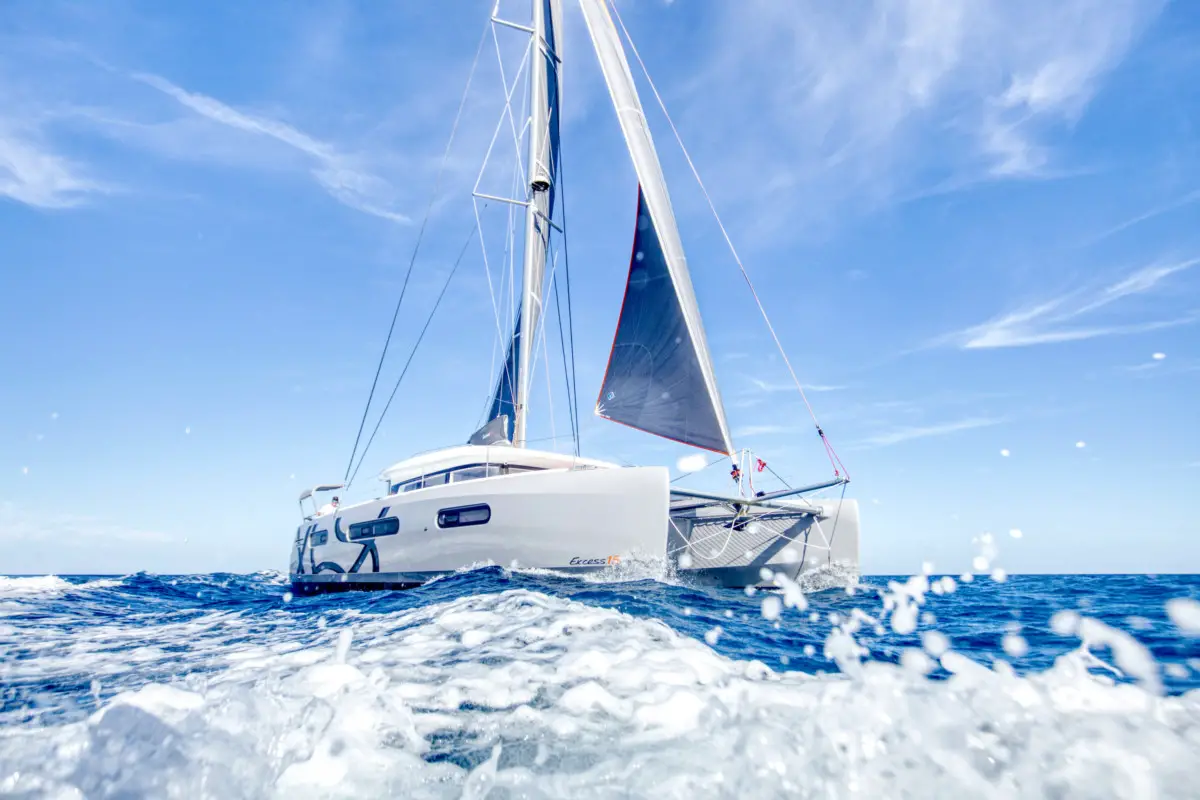
As an Amazon Associate, we earn from qualifying purchases. We may also earn commissions if you purchase products from other retailers after clicking on a link from our site.
Catamarans are quickly outstripping single-hull boats for long-distance journeys. They are more stable and comfortable , and some can travel more than 200 miles in a day. In today’s article, I have put together a complete (well almost) list of some of the best catamarans for circumnavigating the planet; the question is, which one is best for you?
The best catamarans for sailing around the world include:
- The Fountaine Pajot Ipanema 58
These cats focus on speed, safety, and comfort for longer journeys.
This article will show you the seventeen best catamarans for long journeys, and why they’re the best. You’ll also learn some great tips on what to look for in a Catamaran and how to save money by buying a used catamaran. Let this list be a jumping-off point for your future research!
Pro-tip; here are the actual costs of maintaining a cat and here are considerations on how to circumnavigate .
Table of Contents
The Best Catamarans for Sailing Around the World
A catamaran is a double-hulled boat with a deck or cabin area in between (bluewater cat definition in this article ). The double hull design means that the boat rocks less, sits higher on the water, uses less fuel to sail, and can be sailed in shallower waters than a single-hulled boat without worrying about grounding.
Catamarans come in a variety of sizes and can be sail-powered or motor-powered and range from single-person sailing boats to family-sized yachts. Every catamaran design is different, and the twin-hull shape offers many ways to customize the layout of a ship.
Each boat on this list is a larger catamaran (+40ft, more on size here ), so if you’re going to sail around the world, you want lots of space for provisions and rest.
Of course, there are tons of technical specs for each of these boats, but I’m going to focus on the overall features of each of these catamarans, what makes them stand out, and why they would each be an excellent choice for a transatlantic journey.
Antares 44i
The Antares 44i is an excellent option for sailing around the world and was explicitly designed for long-distance cruising. It performs well in any weather conditions, can be sailed easily by two people, and you’ll be able to sail long distances and live in comfort.
Although it can be easily sailed by a crew of two I believe that a true bluewater cat should be set up for single-handed sailing, more on that in another article .
This catamaran features a stateroom on each hull and a forward cabin with plenty of storage space. The living and entertainment features include a flatscreen tv and a high-end deck speaker system.
With this model, Antares dedicates itself to high-quality boats with optimal rigging and engine configurations.
Atlantic 42
Atlantic is no longer building this catamaran, but there are usually a few pre-owned boats on the market. You can also get it made custom if you love the design, but be prepared to spend more money on a custom boat (custom boat also gets custom problems ;)).
The Atlantic 42 is slightly smaller than some of the other catamarans on this list but is a seaworthy vessel. 42 ft is what most sailors I interview ( in this article ) said was the smallest cat to safely cross big oceans. It is also a decent size to counter the risk of capsizing (more on that here ).
It has a forward cockpit and pilothouse, which gives the owner a better use of space and makes the boat easier to navigate. With single-handed capability, one person can sail it easily and let the rest of the crew relax.
One of the best-praised aspects of the Atlantic 42 is its galley, more extensive than most 42-footers (12.8-meter) can offer.
One of the few 50 footers (15.24 meters) that can be sailed by just one person (many would of course disagree on this).
The Catana 50 is a catamaran worthy of an overseas journey. Its size adds to its stability on the open waters and its ability to sail straight through the choppy ocean and windy conditions.
The Catana is also incredibly spacious on the inside, with substantial cabins and showers. The biggest downside to the Catana 50 is its price, as it’s much more expensive than most of its competitors.
Catana also holds up well against some of the fastest cruising cats out there, here’s a list of the fastest cruisers if you are interested in that.
However, if you can find a gently-used Catana 50, you can rest assured that this boat will last!
The Dolphin 42 is unique because of the use of daggerboards instead of fixed keels. This upgrade means that the boat has some pretty decent upwind performance while at the same time being faster downwind.
Centerboards and daggerboards offer some interesting downsides compared to mini keels. This is an interesting discussion and I suggest you read another one of my articles if you want to deepen your knowledge a little.
These catamarans are some of the lightest on the market. Not many Dolphins were made, so they are relatively hard to find. However, if you want a small, lightweight boat capable of going great distances, the Dolphin 42 is an excellent choice.
Fountaine Pajot Belize 43
The Fountaine Pajot Belize is another well-built cruising yacht. Its core is made of foam instead of balsa, which reduces the risk of structural damage due to a rotten core in case of water intrusion.
The design of Belize offers many options for customizability, with large open spaces and a combined saloon, navigation, and dinette area.
There are two styles of Belize catamarans for sleeping quarters. You can either purchase a boat with an entire primary suite on one hull or one with two cabins in each hull. The first option is great if you are sailing the world alone and not expecting many guests, as it increases the storage capacity.
Understanding what factors to consider when getting a cat can be hard, there are just so many of them (such as the daggerboard discussion above), I have tried to compile some of the most important in this article .
The boat also has wraparound windows to increase the sense of space in the galley.
Fountaine Pajot Lucia 40
Fountaine Pajot is one of the best sailboat manufacturers existing today, as their boats are well made and highly versatile. The Lucia 40 is no exception – it’s a smaller boat but has a lot of room for moving around and on-board living.
The living area is remarkably spacious on this catamaran for its size.
The galley and lounge easily accommodate 6+people. The Lucia 40 doesn’t disappoint when it comes to sailing either, as the narrow hulls slice through choppy waters with ease.
Most catamarans today are built to withstand rough weather but that doesn’t matter as much if the crew isn’t up for the task, I firmly believe that the most important thing a boat should consist of, is knowledge. Therefore taking online courses ( two free here ) or reading books ( my favorites here ) is imperative.
Gemini 105M
Gemini’s boats have been on the market for years and are solidly built for cruising. This boat is one of the most popular ever made, I personally would consider something different for offshore cruising, but since it has such a good reputation, I felt I had to add it to the list.
If you want to understand why I am hesitant to take this boat around the world, I recommend you read my article: What are trampolines on a catamaran?
The Gunboat 62 is a great catamaran and set the standards for the rest of the impressive Gunboat lineup. It’s sleek and spacious while being robust and capable of transatlantic journeys. You can easily travel the world in a Gunboat 62 with several people and not feel cramped.
The yacht was made for speed and power and remains one of the fastest catamarans on the market, even rivaling the newer Gunboat models. GABO
Although the earlier models of the Gunboat 62 weren’t designed for a lot of cargo, you can still find space for everything you need without compromise.
Lagoon catamarans are known for their reliability and ease of use. If you are considering a catamaran for the first time and are unsure about the technicalities of sailing, a Lagoon boat is a great option.
The Lagoon 380 is probably the smallest cruiser on this list, which makes it better suited for solo or couple sailing.
When I go looking to buy something, whether it be a boat, campervan, or whatever, I create a checklist and classify all the things I want either by NEED or NICE to have.
I believe the Lagoon 380 to be sub-optimal for my NEEDS, even though it does check a lot of NICE boxes, there’s a step-by-step article on the NEED and NICE method here .
There are several cabin options available on the Lagoon 380, but if you’re sailing by yourself, you can settle for three cabins and a larger galley and living space. With a smaller cockpit and broader side decks, the Lagoon 380 packs a lot of practicality and ease of sailing into a more compact catamaran.
If you like the idea of a Lagoon boat but want a little more space, the Lagoon 42 is the upgraded version of the Lagoon 380. With all of the same benefits, it comes with more space for cabins or storage, making it one of the best-selling Lagoons of all time.
The Lagoon 42 is also a faster cruiser built for strength. While it’s not the fastest on the market, it works well in choppy waters and windy conditions, making it great for the beginning sailor to go on a more extended trip.
Many people have completed an around-the-world sail with this ship.
Although there is a flybridge version, I would recommend the “open” version due to several factors, some including increased windage and a higher boom. More on flybridges pros and cons here .
For stability, safety, and durability, you can’t beat the Lagoon 42.
The Leopard 45 performs better with less storage weight because of the relatively low bridge deck clearance. If the boat is fully loaded, you could experience some wave pounding. However, the cockpit is open and airy, with devices that block the sun and provide maximum comfort while sailing.
The Leopard 45 is an incredibly beautiful boat, and has a strong reputation for excellent build quality!
Leopard catamarans are one of my personal favorites, as such I have written an entire article about the brand, so if you want to understand its pros and cons then here is the link . Gabo
Designed in South Africa, it features a high rear arch for extra support and very smoothly connected decks. The galley is large and open, and most Leopards offer a four-cabin plan. If you are traveling with another person, this boat is an excellent option for you!
The Manta 42 is another classic catamaran that you can buy used (at a decent price), as it is an incredibly seaworthy vessel. While still in production, the Manta was one of the most popular catamarans on the market.
It is still in high demand amongst circumnavigators. Buying a used Manta 42 usually means that you inherit some of the previous owner’s boat upgrades!
The Manta 42 also made it to my list of the 9 safest catamarans on the market ( link ).
This blue water cat can be sailed by one or two people, making it ideal for liveaboard couples or long-distance shorthanded sailing. The galley is in the saloon ( instead of in one of the hulls ), making the cabins below more spacious and better equipped.
Overall, the Manta is well equipped for sailing around the world.
Nautitech 44
Nautitech is an excellent brand of the catamaran, with several different designs per boat. The Nautitech 44 has a unique feature, you can have it with two options for steering: twin wheels or a single wheel.
The Nautitech 44 also features a cockpit on the same level as the saloon. The door between the two is more convenient than a hatch and dramatically reduces the risk of water damage during rain pour.
This is also the same boat that aeroyacht president Gregor owns, he has offered some great insights into Nautitech in the book Catamarans (amazon link )
Outremer 45
Outremer is famous for being one of the fastest brands of catamarans on the market. If you need speed, the Outremer 45 might be the perfect choice for you. It has a top speed of 16 knots, which is higher than almost every other catamaran of its class.
While the Outremer 45 is known for speed, it doesn’t compromise on the quality of living.
You can settle into life on this boat with complete peace of mind. Even as a beginning sailor, the steering is simple and easy to use, and the autopilot is top of the line, so you’ll be able to sail across the ocean in an Outremer without issue.
Privilege Serie 5
A French-designed catamaran, the Privilege Serie 5 is one of the most comfortable 50-foot (15 m) yachts available. The unique cabin layout includes the master cabin in the boat’s center instead of in one of the hulls.
The Privilege Serie 5 is also incredibly easy to sail, despite its larger size.
The sails and controls lead to the helm, where the raised deck makes it easy to see all around the deck. If you want to cross the ocean with a full crew then the Privilege Serie 5 might be perfect for you!
Seawind 1000
The Seawind 1000 is the smallest boat on this list, measuring 33 feet (10 meters) long altogether. However, this doesn’t mean that it’s not livable. If you are sailing on your own or with a partner, there is more than enough space to live in the Seawind 1000, which includes the option of a centered cabin or two hull cabins.
Because it’s small, the Seawind 1000 is easy to handle. The mast and sails are all manufactured for extra stability and ease of use.
Overall, the Seawind 1000 is an excellent example of a simple, safe, and seaworthy catamaran.
Note: since this is a small catamaran it will also be more sensitive to heavy weather so trip-planning becomes even more important.
The Voyage 44 is one of the oldest cats on this list, having had its hay-day in the mid-1990s. However, this also means that a used Voyage 44 will be cheaper than a newer boat. If you can find a Voyage with previous responsible owners, you will inherit any upgrades and fixes that they’ve made on top of a very seaworthy boat.
The Voyage 44 has more storage and space than most cruisers of its size and is known for behaving very well in choppy waters.
This catamaran does its job well while providing adequate space for cooking, sleeping, and living aboard.
What To Look For in a Long-Distance Cruising Catamaran
If you are planning to sail around the world, you need to be very careful about which kind of catamaran you decide to use. Many of the things you want in a boat really comes down to personal preference, so be sure you know what design preferences you want before you start shopping!
Size and Payload
The most important thing to consider when buying a catamaran is how much space and cargo you need because the larger the boats are, the bigger the payload it can handle. Decide how long you want the ship to be and how much you’re taking with you.
It’s vital not to overload a catamaran, this will reduce performance and increase risk of unwanted behavior in heavy seas.
Cabin Placement
Most catamarans have options for a “Maestro” cabin placement, where one entire hull is the master suite, and the other cabins are located on the opposite hull.
Cockpit and Protection From The Weather
Is the cockpit on the boat you’re looking at covered or open? This can make a difference on the high seas, especially during rainy weather.
The size of the ship also can affect how many people you need as a crew. If you’re traveling by yourself or with one other person, you don’t want to buy a boat that needs a larger crew.
Buying Used?
If you don’t want to spend the money on a brand new catamaran, I don’t blame you. Several of the ships on this list are out of production and can only be found used. However, for circumnavigation, you do want a boat of high quality to keep you safe and dry until you make it to your destination.
When buying a suitably used catamaran, it’s essential to look at the refit history of the boat more than the year it was made. Catamarans are sturdy, and the general design has been the same for at least the past decade.
If you find a newer, larger, cheaper boat, you should look into its history.
Your best bet to save money while buying a catamaran will be to buy an older, probably smaller boat with an excellent refit history and no serious issues. It will still be an investment, and a sturdy used catamaran will serve you well.
Final Thoughts
No matter which catamaran you decide to buy for your journey, you’ll be able to sail safely and comfortably. Catamarans are great yachts for long-distance sailing, and the ships on this list are the best of the best. These brands are time-tested and ready to accompany you on an adventure around the world!
Here are Some of My Favorite Catamaran Cruising Resources
Thank you for reading this article. I hope you found it helpful as you hopefully start your sailing adventures. Here are some resources that I use as a sailor that I hope you’ll also find helpful. These are affiliate links, so if you do decide to use any of them, I’ll earn a commission. But in all honesty, these are the exact things that I use and recommend to everyone, even my own family. Sailboats: If you’re looking for the best boat to suit your needs, I would recommend a catamaran. If you’re interested, I can show you the differences between catamarans and other types of sailboats .
Books: For getting started, I really like Cruising catamarans made easy . It is actually a textbook from the American sailing association; it is used to get a cruising catamaran certification. There are some other great books, and I have compiled a list of books about cruising catamarans that you will find useful.
Communication: Being out on adventures, whether it be sailing or climbing mountains, good communications are essential to being safe. I recommend two things Google fi (incredibly simple cellular data all over the world) and Garmin inreach mini (for text and voice in remote areas without cell coverage)
Sailing courses: Online sailing courses are great for beginners starting out their sailing career; it’s an efficient way of learning the basics of navigation, throttle controls, and maritime safety. I suggest starting with two free courses from NauticEd .
To see all my most up-to-date recommendations, check out this resource that I made for you!
- Wikipedia: Catamaran
- Cruising World: A-Z Best Cruising Catamarans
- Dreamy Yacht Sales: Four Best Catamarans for New Buyers
- Atlantic Cruising: Good Cat/Bad Cat
- Yachting World: Catamaran Sailing Across the Atlantic
- Boat Affair: What is a Catamaran?
- Nautilus Sailing: Catamaran Sailing
Owner of CatamaranFreedom.com. A minimalist that has lived in a caravan in Sweden, 35ft Monohull in the Bahamas, and right now in his self-built Van. He just started the next adventure, to circumnavigate the world on a Catamaran!
3 thoughts on “ 17 Best Catamarans for Sailing Around the World ”
I like the efforts you have put in this, regards for all the great content.
Thanks Elisabeth I really appreciate the kind words 🙂
I appreciate you sharing this blog post. Thanks Again. Cool.
Leave a Reply Cancel reply
Your email address will not be published. Required fields are marked *
Save my name and email in this browser for the next time I comment.
Recent Posts
Must-Have Boat Gear for Catamaran Sailors!
Sailing is probably the most gear-intensive activity I've ever done; there are so many decisions to be made about what gear to buy now, for tomorrow, and what to definitely never buy. The gear on...
6 Best Trailerable Trimarans For Bluewater and Coastal Sailing
Having a boat costs a lot of money, even when you are not using it, marina fees, etc. And once it is in the water most sailors never go very far from their "home marina" and sailing will be somewhat...
The Ultimate Guide to Small Boats: What Are Your Options?
Small boats offer a unique way to enjoy the water, whether you’re an angler, a day cruiser, or a weekend adventurer. They provide affordable entry points into boating while delivering versatile and personalized experiences. In this guide, we will explore different types of small boats, their key features, price ranges, and specs to help you decide which option best suits your needs.
Why Choose a Small Boat?
Small boats are ideal for those looking to get into boating without the commitment or expense of a large vessel. Some key advantages include:
- Affordability : Small boats generally cost less to buy and maintain.
- Ease of Use : Many are simple to operate, requiring minimal skill or certification.
- Maneuverability : Their smaller size makes them easier to navigate through tight spaces and shallow waters.
- Portability : Many small boats can be trailered or even carried by hand.
- Versatility : Suitable for a range of activities, from fishing to watersports.
Types of Small Boats
1. jon boats.
Jon boats are lightweight, flat-bottomed boats typically made from aluminum or polyethylene. They are favored by anglers and hunters because of their stability in calm waters like lakes and rivers.
- Specs : Range in length from 10 to 18 feet. Most models have a shallow draft, allowing you to navigate very shallow waters.
- Engine : Often powered by small outboard motors, though some are manually rowed.
- Capacity : Seats 2 to 4 people comfortably.
- Price : $700 to $5,000 depending on size and material.
- Easy to maneuver and transport
- Great for fishing in shallow waters
- Limited in rough waters
- Basic design without many features
2. Dinghies
Dinghies are small, open boats that can be powered by oars, small outboard motors, or sails. They’re commonly used as tenders to larger boats or for short-distance transportation in calm waters.
- Specs : Typically between 6 to 12 feet in length.
- Engine : Often powered by a small outboard engine (2-15 hp) or manually rowed.
- Capacity : Seats 2 to 6 people, depending on the size.
- Price : $500 to $2,000 for basic inflatable or hard-shell models.
- Versatile for various water activities
- Easy to transport (especially inflatable models)
- Often small enough to carry
- Not ideal for long-distance travel
- Vulnerable to capsizing in rough conditions
3. Inflatable Boats
Inflatable boats are constructed from durable rubberized fabric and are designed to be lightweight and easy to store when not in use. These boats are excellent for families or recreational boaters who need something compact and portable.
- Specs : 6 to 18 feet in length.
- Engine : Can be equipped with a small outboard motor or paddled manually.
- Capacity : Can carry anywhere from 2 to 8 people.
- Price : $200 to $5,000 depending on size, material, and brand.
- Extremely portable and easy to store
- Versatile for different activities
- Stable and buoyant
- Limited speed and power compared to rigid hull boats
- Requires inflation and deflation with every use
4. Kayaks and Canoes
These human-powered vessels are ideal for solo adventurers or small groups looking to explore lakes, rivers, and coastal areas. Kayaks are generally enclosed, while canoes are open-topped.
- Specs : Range from 8 to 17 feet for kayaks, and 12 to 20 feet for canoes.
- Engine : Paddled manually.
- Capacity : Kayaks are typically single or double-seaters; canoes can hold 2 to 4 people.
- Price : $300 to $2,500 depending on material and design.
- Perfect for exercise and exploration
- Low maintenance and affordable
- Suitable for quiet, peaceful waters
- Not ideal for open water or rough conditions
- Limited in speed and storage space
5. Jet Skis and Personal Watercraft (PWC)
Jet skis are small motorized vessels designed for high-speed thrills and are excellent for watersports enthusiasts. They offer a more adventurous experience compared to most small boats.
- Specs : Average length is 8 to 12 feet.
- Engine : Powered by an inboard jet drive with engine sizes ranging from 60 hp to over 300 hp.
- Capacity : Usually 1 to 3 riders.
- Price : $5,000 to $15,000 depending on the brand and engine power.
- Fun and fast; great for watersports
- Easy to tow on a trailer
- High maneuverability
- Limited storage space
- Not ideal for long trips or rough waters
6. Pontoon Boats (Small Models)
Pontoon boats are flat-decked boats that float on two or more aluminum tubes called pontoons. Smaller pontoon boats are great for families or groups who want a stable and comfortable ride on lakes or calm waters.
- Specs : Small models range from 12 to 20 feet.
- Engine : Outboard motors ranging from 25 hp to 90 hp.
- Capacity : Can comfortably accommodate 4 to 8 passengers.
- Price : $10,000 to $35,000 depending on size and features.
- Comfortable and spacious
- Great for family outings and relaxation
- Stable and safe
- Not suitable for rough waters
- Bulkier than other small boats
7. Center Console Boats (Small Models)
Center console boats are popular among anglers because of their 360-degree fishing capability and the central helm. Smaller versions provide versatility for both fishing and leisure.
- Specs : Typically 15 to 20 feet long.
- Engine : Outboard engines ranging from 60 hp to 150 hp.
- Capacity : Holds 4 to 6 people.
- Price : $15,000 to $40,000 depending on size and engine power.
- Excellent for fishing
- Good speed and power
- Limited in rough ocean conditions
- Not much shelter from the elements
How to Choose the Right Small Boat
When selecting a small boat , consider the following factors:
- Intended Use : Are you looking to fish, relax, or engage in watersports? Different boats serve different purposes.
- Water Type : Will you be boating in lakes, rivers, or the ocean? Choose a boat that’s designed for the conditions you’ll face.
- Budget : Small boats vary significantly in price. Determine how much you’re willing to spend, including maintenance, insurance, and storage costs.
- Storage and Transportation : Some boats can be easily trailered, while others may require a dock or mooring.
- Capacity : Consider how many people you’ll typically bring on board and make sure the boat can accommodate them safely.
Small boats offer a world of possibilities for boating enthusiasts, whether you’re after a leisurely cruise or a high-speed adventure. From affordable Jon boats to sporty jet skis, there’s an option for everyone. By understanding your needs and the specifications of each type, you can find the perfect small boat to get out on the water and enjoy the experience to the fullest.
Happy Boating!
Share The Ultimate Guide to Small Boats: What Are Your Options? with your friends and leave a comment below with your thoughts.
Read The Top 10 Winter Boating Destinations to Visit This Winter until we meet in the next article.
Similar Posts

6 Reasons Why a Boat is a Good Investment
Boats have long been associated with recreation, adventure, and luxury. However, they can also represent a savvy investment, offering both tangible and intangible returns. Whether you’re an avid boater or someone contemplating your first purchase, here are six compelling reasons why investing in a boat could be one of the best decisions you make. 1….

MasterCraft X-15: A Timeless Ride for Water sports
The MasterCraft X-15 carves a name for itself amongst watersports enthusiasts as a versatile and fun boat. This discontinued model (production ended in 2010) is still a popular choice on the pre-owned market, offering a compelling blend of power, performance, and comfort. Let’s dive into the world of the MasterCraft X-15 and explore what makes…

Aluminum Boats: The Tough, Reliable Choice for Boating
For many boaters, aluminum reigns supreme. These versatile vessels offer a winning combination of affordability, durability, and low-maintenance needs, making them a popular choice for fishing, hunting, cruising, and exploring waterways of all kinds. But before you dive headfirst into the world of aluminum boats, let’s delve deeper into what makes them tick and explore…

Pontoon Boat for Sale in Pennsylvania (PA)
Pennsylvania boasts beautiful lakes, rivers, and reservoirs, making it a prime spot for pontoon boating enthusiasts. These versatile vessels offer a stable and comfortable platform for cruising, fishing, swimming, or simply soaking up the sun with family and friends. If you’re in the market for a pontoon boat in the Keystone State, this comprehensive guide…

A Guide to Buying a Pre-Owned Pontoon Boat
Pontoon boats, with their spacious decks, comfortable seating, and stable design, are ideal for cruising, lounging, fishing, and creating lasting memories on the water. But let’s face it, brand new boats come with a hefty price tag. Thankfully, the pre-owned market offers fantastic opportunities to snag a pontoon boat at a significant discount. This guide…
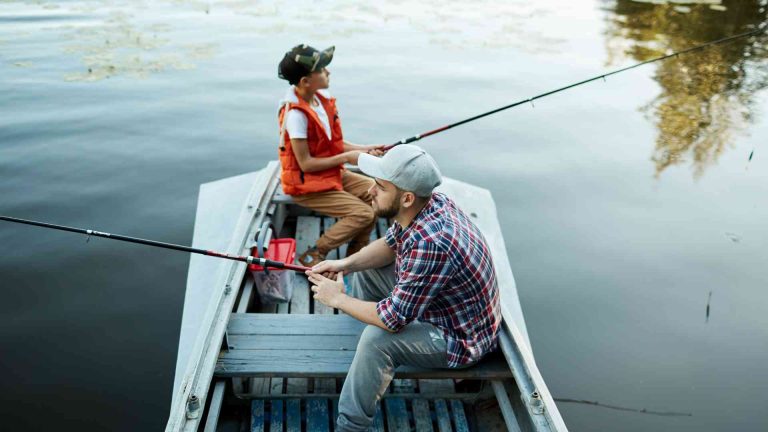
Best Pontoon Boat for Fishing
The gentle lapping of water against the hull, the warm sun overhead, and the anticipation of a big catch – these are just a few reasons why pontoon boats have become the go-to choice for fishing enthusiasts. With their spacious decks and comfortable seating, pontoon boats are transforming the angling experience. But before you cast…
Eight dead after attempting to cross Channel - as 801 people arrived in UK on small boats yesterday
It comes as French authorities rescued some 200 people off the coast of Calais over a 24-hour period between Friday and Saturday night.

News reporter @samuelosborne93
Sunday 15 September 2024 19:12, UK

At least eight migrants have died off the coast of France while attempting to cross the English Channel - as new data reveals 801 people arrived on the UK's shores yesterday.
The latest government figures show those who arrived made their journey on Saturday in 14 boats.
It is the second-highest number of arrivals this year. The current record for the highest number of arrivals in one day this year so far is 882 in 15 boats on 18 June.
The deaths occurred after a vessel "tore apart on the rocks" off Ambleteuse in the Pas-de-Calais region of northern France overnight, a regional official said.
Some 51 survivors of the disaster were rescued. Six were taken to hospital, including a 10-month-old baby suffering from hypothermia.

"Driven by profit, human traffickers are putting more and more lives at risk, selling crossings in dangerous conditions on ill-suited boats," the official, Jacques Billant, said. "This is literally leading them to their deaths.
"The boats are overloaded, of poor quality, underinflated, without proper flooring, underpowered, and lack life jackets for all passengers."
Only one in six people on the boat had a life jacket, he added.

A boat carrying migrants that was in poor condition was located off the coast of Le Portel, a French coastal town, and 55 people were rescued.

Elsewhere, 61 people were picked up off the coast of La Becque d'Hardelot, 48 people were recovered near a lighthouse and at the end of the day 36 more were rescued, French authorities said.
All of those rescued were brought back to land.
French authorities said they monitored 18 attempts to launch boats across the Channel on Saturday.
Please use Chrome browser for a more accessible video player

Responding to the disaster, Foreign Secretary David Lammy said: "It's awful. It's a further loss of life."
He added that the government has been "discussing how we go after those gangs, in cooperation upstream with other European partners".
Lib Dem deputy leader Daisy Cooper, said it was "desperately, desperately sad" and while her party supports the government's plan to "smash the gangs", they want them to reopen safe and legal routes for asylum seekers.
The Conservatives closed down lots of those routes, which allowed asylum seekers to apply in the UK but from another safe country.
She said: "It would mean they wouldn't have to make that treacherous journey so we hope very much the government succeeds in smashing the gangs.
"But it has to come with both tackling the security element of it and the criminal element of it while making sure we have the right routes for people who have genuine asylum claims."
Steve Valdez-Symonds, Amnesty International UK's refugee and migrant rights director, said: "This is yet another appalling and avoidable tragedy and our hearts go out to the families and friends of those who've died.
"These perilous crossings are seemingly becoming more and more dangerous, suggesting smugglers are taking greater chances with people's lives as they try to evade detection efforts by the UK and French authorities."
He added: "The government's 'smash the gangs' slogan and its security-heavy approach is contributing to the death toll because the refusal to establish safe asylum routes means these flimsy vessels controlled by people smugglers are the only real option for desperate people fleeing persecution."
Mr Valdez-Symonds added: "Until UK ministers and their counterparts in France start sharing responsibility over the need for safe routes, we should expect this weekend's tragedy to keep repeating itself time and time again."
It comes less than two weeks after at least 12 people, including 10 women and girls, died after a boat with dozens of migrants tore apart in the English Channel .
The French coastguard said more than 65 people were rescued after the vessel got into difficulties off the coast of Cap Gris-Nez.

Keep up with all the latest news from the UK and around the world by following Sky News
France's interior minister Gerald Darmanin said only eight of the 70 people on board had lifejackets.
It was the deadliest incident so far this year, which had already seen 25 people die attempting to cross the Channel.
Be the first to get Breaking News
Install the Sky News app for free

At least 45 people have died in Channel crossings so far this year.
More than 21,000 people crossed the English Channel in small boats between January and September this year, government figures show.

Sakhalin – Visiting Russia’s largest island

- Gepostet am 20. July 2021
- last updated 27. July 2023
- , in: Russia
Table of content
Many of you will probably never have heard of Russia’s largest island Sakhalin. Yet it is an exciting place not only in terms of its nature, but also in terms of its history, which is also very important for Russia’s gas and oil supply. Japan and Russia are still arguing about who owns the island. As you can see, there are plenty of reasons to take a closer look at Sakhalin Island.
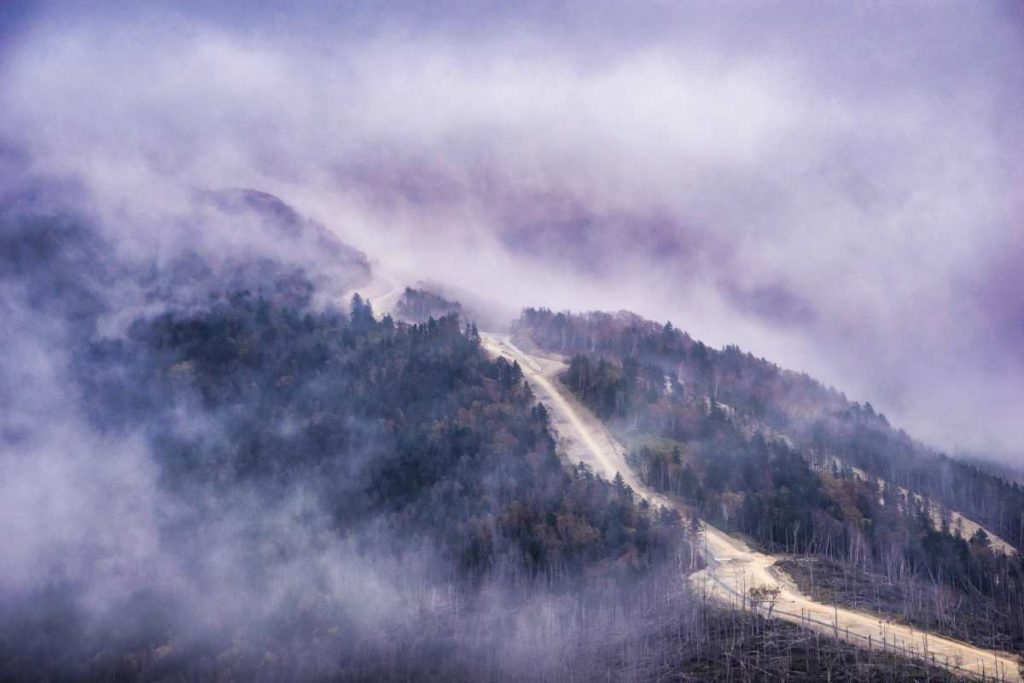
This is Sakhalin island
Sakhalin is an island in the southern Sea of Okhotsk, a marginal sea of the Pacific Ocean. It lies north of Japan and east of the Russian mainland, and at one point only 10 km from the Siberian east coast. The distance to Japan’s Hokkaido in the south is only about 45 km. With an area of 72,000 km², Sakhalin is the largest Russian island and about the size of Bavaria or Ireland. With its gas and oil deposits, the island is of outstanding strategic importance for Russia. The deposits are transported to the mainland via a pipeline. Although Sakhalin is still quite untouched in many places, the exploitation of the resources has left clear traces here. Until now, the island has been a shadowy tourist destination, but this could soon change thanks to new infrastructure projects.
The history of Sakhalin
Sakhalin has been inhabited since the Stone Age. Originally the Oroks, Ainu and Nivchen lived here, all of whom also settled and still live on the island of Hokkaido. In the Middle Ages Sakhalin was subjugated by the Mongols, later the island was controlled by the Chinese Empire. In the course of Russia’s eastward expansion in pre-modern times, Russian explorers soon reached the island, but Japan also began to take an interest in the island. Russian soldiers or Cossack expeditions came across the island almost automatically, as it is located exactly opposite the mouth of the Amur River into the sea.
Not of particular interest for a long time
Despite its size, Sakhalin remained of minor interest for a long time, with only a few Japanese fishermen settling on the southern coast during the summer months and then wintering on Hokkaido. Formally, however, China retained sovereignty over the island. In the 19th century, as Russia and Japan increasingly emerged from the shadow of a weakening China, a conflict between the two great powers began to emerge. Japan occupied the island in 1806, but gave it up only 15 years later. Sakhalin seemed to sink back into insignificance before large gold deposits were discovered on the Amur River and Russia built several settlements on the island in the 1850s.

Joint administration and transfer
Meanwhile, China was so weakened by the appearance of the Europeans and the Japanese expedition that Russia was able to strike and bring the island and parts of Manchuria completely under its control. An agreement with Japan then ensured that Sakhalin was administered by both powers. In 1875, an agreement was reached that gave Russia control of the island in exchange for the Kuril archipelago east of Sakhalin. However, Japanese already living on Sakhalin were allowed to continue living here and were even given their own consulate. Russia subsequently maintained a penal colony here before the island was captured by Japan during the Russo-Japanese War (1904–1905).
Japanese control
Russia lost the war, which led, among other things, to the 1905 revolution. In a peace treaty, Japan was granted the south of Sakhalin. In the chaos of the Russian Civil War, which followed the October Revolution at the end of World War I, Japanese troops captured the entire island and were to control the area until the end of World War II. A few days before the end of the war, the Soviet Union declared war on Japan and, with heavy losses, captured the entire island, which has been under Soviet and Russian control, respectively, ever since. The Japanese population was forcibly resettled in the course of the Soviet Union’s capture.
Sakhalin – an object of dispute between Japan and Russia
It was not until 1951 that a treaty was negotiated between the Soviet Union and Japan, which dealt with Sakhalin and the Kuril Islands. However, this treaty was not clearly formulated and was not signed by the Soviet Union. The Soviet Union – just like Japan – considered the island as its territory and even shot down a Korean airplane in the airspace of Sakhalin in 1983, killing almost 300 people. Until 1991 Sakhalin was treated like a fortress, civilians were strictly forbidden to enter the island.
Since the fall of the Soviet Union, the situation has eased somewhat, people are trading and trying not to let a possible conflict over the island boil up, but Japan has never given up its claims at least to the southern part of the island with reference to the unsigned agreement. Partly because of the conflict over Sakhalin and the southern Kuril Islands, there is still no peace treaty between Russia and Japan today. China, the EU, and the U.S. currently tend to support Japanese claims to the island.

Sights on Sakhalin island
Sakhalin is not only an object of dispute between Japan and Russia, but also a beautiful island with many sights. We would like to introduce the most important ones to you here.

Yuzhno-Sakhalinsk
With 180,000 inhabitants, Yuzhno-Sakhalinsk is by far the largest settlement on the island. A Russian village founded in 1882 and named Vladimirovka was developed by the Japanese under the name Toyohara into the administrative seat of Karafuto Prefecture. Today, the only thing that remains from the Japanese period is the regional museum, which used to be the seat of the Japanese administration. If you visit Sakhalin, you will most likely stay here in the south of the island. In addition to the regional museum, there are several other attractions in the city, including a large zoo, the Yuri Gagarin Park and a railroad museum, where you can also see several Japanese trains.
From Yuzhno-Sakhalinsk you can take the cable car to the ski resort Gorniy Vozduch (“Mountain Air”). The modern resort offers you all amenities, in addition, nationwide competitions are held here again and again.
Neftegorsk Memorial
In 1995, an earthquake of magnitude 7.1 occurred on the island. The town of Neftegorsk, inhabited by about 3,500 oil workers and their families, was leveled to the ground, and nearly two-thirds of the residents died. It was decided not to rebuild the small town and resettled the survivors. Today you can walk through the destroyed ghost town and see the cemetery with the graves of the victims. There is also a small memorial here. In Yuzhno-Sakhalinsk, an impressive monument commemorates the tragic event.
Lake Tunajcha
45 kilometers southeast lies this popular lake, the largest on the island. It is a popular breeding ground for rare birds, which is why it is protected. The lake is especially popular with birdwatchers, but it is not easy to get here.
Vayda Mountains
Approximately in the middle of the island, i.e. where the Japanese-Russian border used to be, stretches the Vayda Massif. This once heavily forested part of the island has unfortunately lost many trees due to the logging industry, but still has its charm. This is mainly due to the many caves that you can explore here, if you dare. But you should look for an experienced guide in Yuzhno-Sakhalinsk, because the whole thing is not without danger. If you just want to hike through the mountain landscape with its lakes, you can also take the train from Yuzhno-Sakhalinsk to Smirnich. There, it is best to ask a local to drive you to Izvestkoviy, from where you can start your hike.
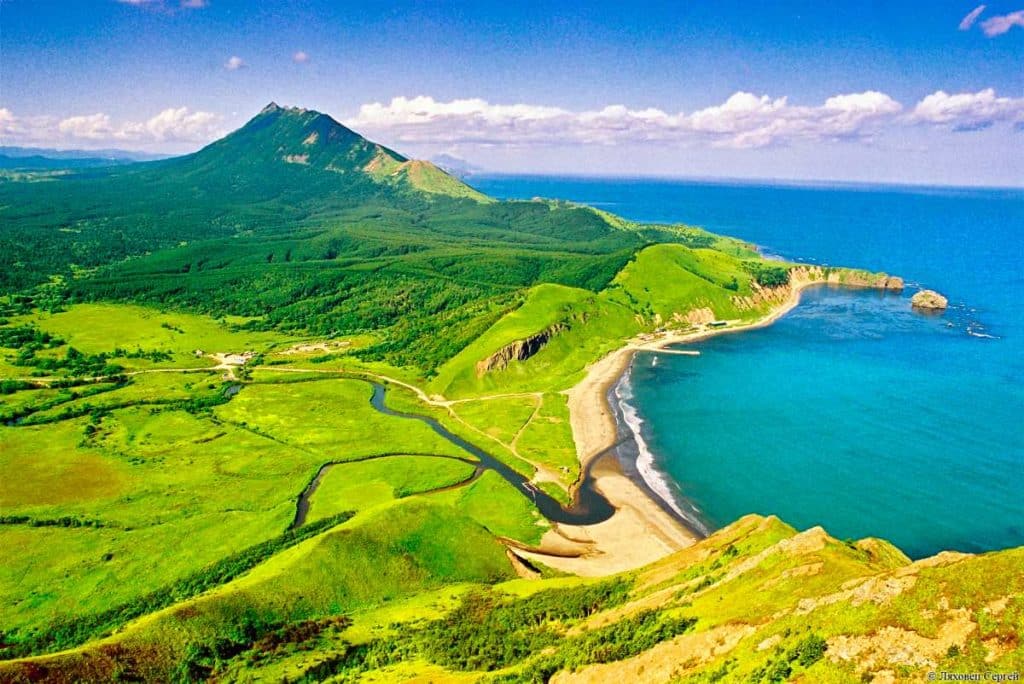
Zhdanko Mountains
Perhaps the most popular tourist destination on the island is the Zhdanko massif north of the village of Tikhaya. The 13 km long ridge is made of volcanic rock and offers spectacular views of the island and its sandy coastline. The contrast of volcanic rock and the lush green of the trees provides wonderful photo opportunities. The best thing to do here is to look for a guide in Yuzhno-Sakhalinsk. You can then hire one and explore the massif in a three-day tour including camping.
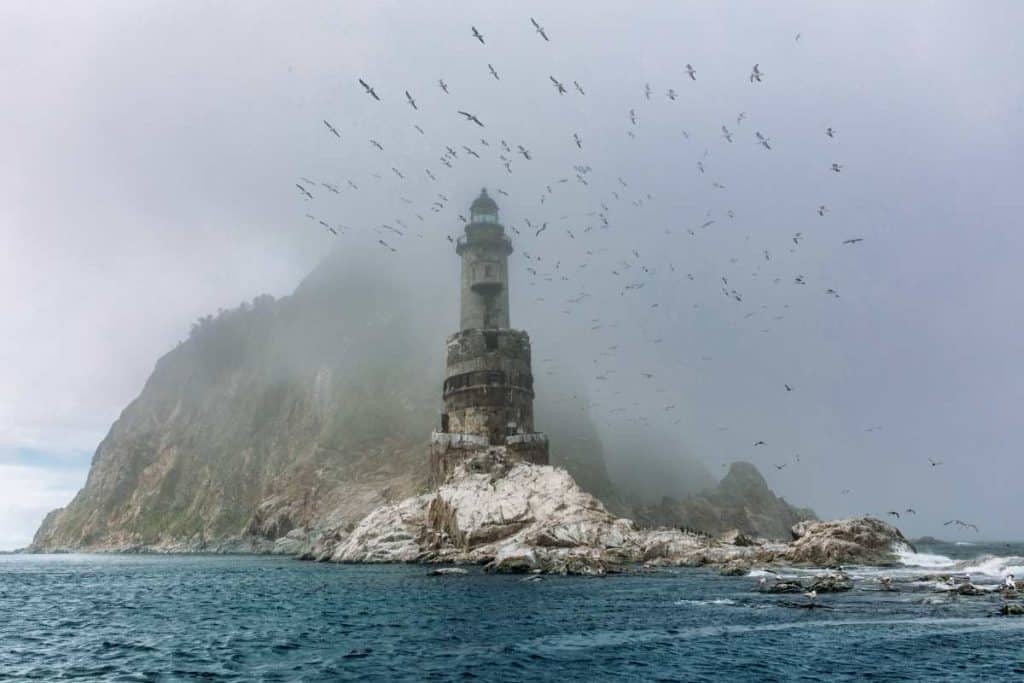
Aniva lighthouse
In the south of the island is the long Aniva Bay with the small town of the same name. Aniva lives mainly from fishing, but is known for its lighthouse all over the island. The Aniva lighthouse on a small rock off Sakhalin was built by the Japanese in 1939 and was one of the most modern in the empire at the time. In the 1990s, it was equipped with a mini-reactor, which has gone out of power. And so the lighthouse has been empty for several years and has become one of the most popular tourist destinations and one of the landmarks of the island, although it is considered one of the most difficult to access lighthouses in the world.
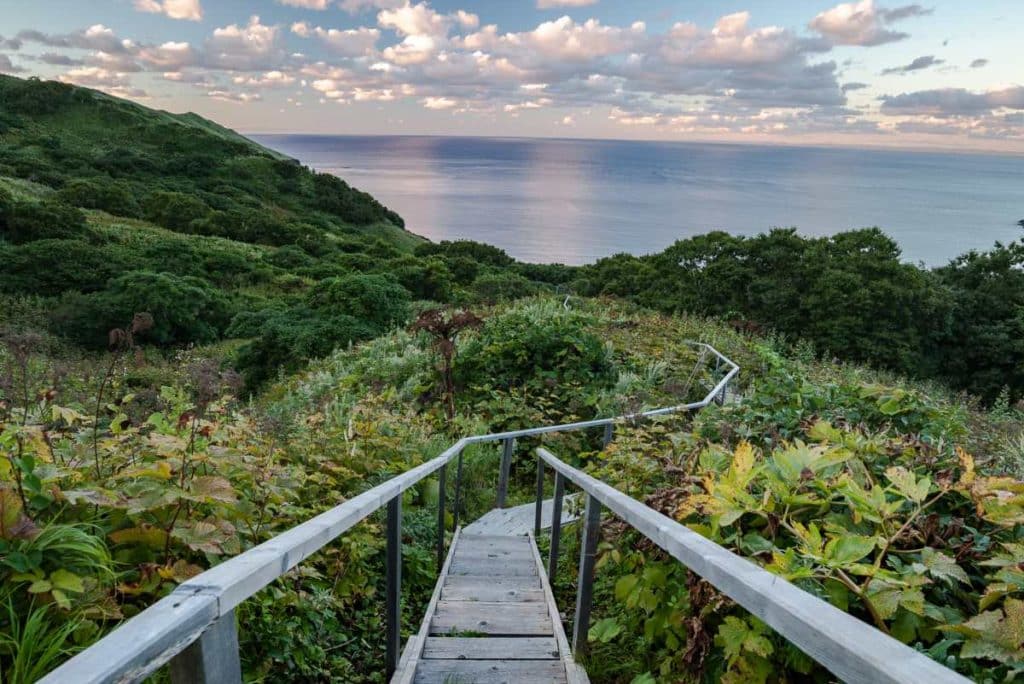
Moneron is a 30km² island west of Sakhalin. With its cliffs and over 150 species of seabirds, Moneron is a natural paradise, protected by the government in 2007. Unfortunately, you need a special permit to enter Moneron. This is not because of the nature conservation requirements, but because it is a strategically sensitive area for Russia.

Moneron is home to numerous sea lions. This is even more true for Tyuleni, which is often simply called Seal Island in English. Tyuleni is located south of a small headland on the eastern side of Sakhalin. For a long time Tyuleni was popular with fur hunters, at one time even a hotel was maintained here. In the meantime, interest in seal fur has fortunately waned. A special permit is also required for Tyuleni, although Russian cruise ships sometimes stop here.

How to get to Sakhalin?
In the future, a tunnel will connect Sakhalin with Hokkaido. Until then, a ferry runs twice a week between Hokkaido and Sakhalin. Japanese can visit the island without a visa, all others need such a certificate. In our Russia travel tips we show you what you need to consider. If you are traveling from Russia, you can easily take a plane. The airport Yuzhno-Sakhalinsk (UUS) is well connected to the Russian flight network, direct flights to Moscow, Novosibirsk or Vladivostok are offered almost daily. The whole of Sakhalin is designated as a special border zone, so you should expect increased controls on arrival.
Book recommendations
- Anton Cechov (Author)
The famous Russian writer Anton Chekhov made a trip to Sakhalin at the end of the 19th century and gained a comprehensive insight into the penal camp system there. In a travelogue, the writer processed his impressions and created a depressing picture of the Russian camp system.
- Dalos, György (Author)
This book focusses on the conflict between Russian and Japan.
- Bodo Thöns (Author)
This international bestseller is a true masterpiece and gets very close to what people reffer to as the “Russian soul” by focusing on the cultural history of the country.
- Brammerloh, Susanne (Author)
Wanna see more of the country? The Lonely Planet guide describes the country in all its varieties.
* – this link is an affiliate link. If you buy or order something here, we will receive a small commission. It won’t cost you a cent extra and we can continue to write new articles for you. Thank you for your support!
Markus Bingel
Other interesting articles.
Has anything changed in the information? Do you have any tips or questions? We look forward to your comment!
Share this post
Für Echte Fans
Unser wöchentlicher newsletter für echte osteuropafans, for real fans, our weekly newsletter for real eastern europe fans.
- THE PRINCESS PASSPORT
- Email Newsletter
- Yacht Walkthroughs
- Destinations
- Electronics
- Boating Safety
- Ultimate Boating Giveaway

How To Repair Minor Fiberglass Damage on Your Boat
- By Lenny Rudow
- September 16, 2024
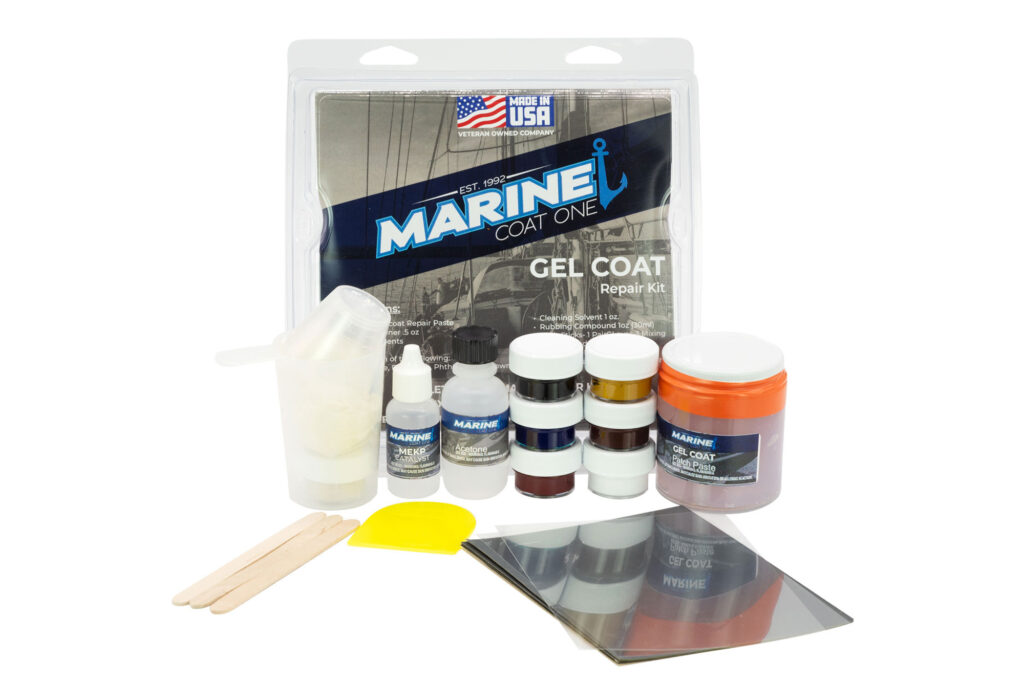
All boaters will bump pilings, kiss rubrails or make an errant screw hole here or there, and those are just a few of the ways minor fiberglass damage can occur onboard. Anytime there’s significant damage to a vessel’s fiberglass, you’ll want to call in a pro, but fixing the minor stuff is actually easy and straightforward. If the damage is limited to the gelcoat, and you know there are no structural issues to worry about, cosmetic repairs can be made in a matter of minutes.
Fixing Chips, Dings and Holes in Fiberglass Gel Coat
Stage one in fixing this type of fiberglass damage is to clean out the divot. This includes removing any loose chips or fragments, sanding the surface with a fine-grit sandpaper, then wiping the surface down with Interlux 202 or acetone to remove all contaminants. If you’re filling in an old screw hole, be sure to sand the edges and roll up a small piece of the sandpaper so you can insert into the hole and sand the inside edges too. Do the same with a rag and the 202 or acetone to clean it out. Now, you’re ready to fill in that blemish.
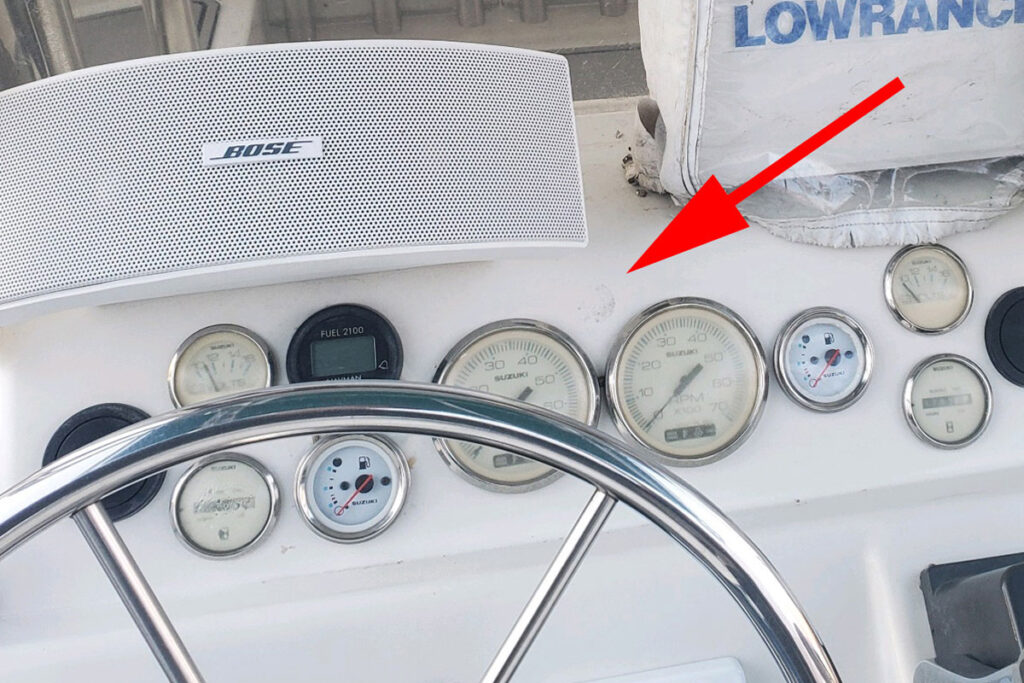
Gelcoat paste will do the trick, and you can use a regular putty knife to create a smooth surface that fills all the gaps. But there’s a complicating factor: you’ll need to color-match the paste with your boat’s original gelcoat. There are literally hundreds of shades and tones of gelcoat, and you’ll have to custom mix your own batch. Start with a neutral white gelcoat paste, then add small amounts of pigment and mix it in. Most gelcoat repair kits will come with several coloring agents allowing you to mix up just about any combination, so if your boat is anything but plain white, it’s usually best to get a kit rather than buying a single pigment and trying to match the correct shade.
Here’s the kicker: when the gelcoat dries, the color often changes slightly. So, what looks like a perfect match upon mixing may turn out to be slightly off when it hardens up. To combat the issue, carefully mix several batches with slightly different paste/pigment ratios that create slightly different shades, allow them to dry, then compare them with your boat’s existing gelcoat. When you find a match you can live with (getting a perfect match is virtually impossible), remix it. Now, you’re ready to spackle it into the damaged area. Make sure to overfill it just a bit and don’t leave any air pockets. When you’re satisfied, cover the gelcoat paste with plastic wrap or a similar film (often included in kits) because gelcoat cures best when it’s not exposed to the air.
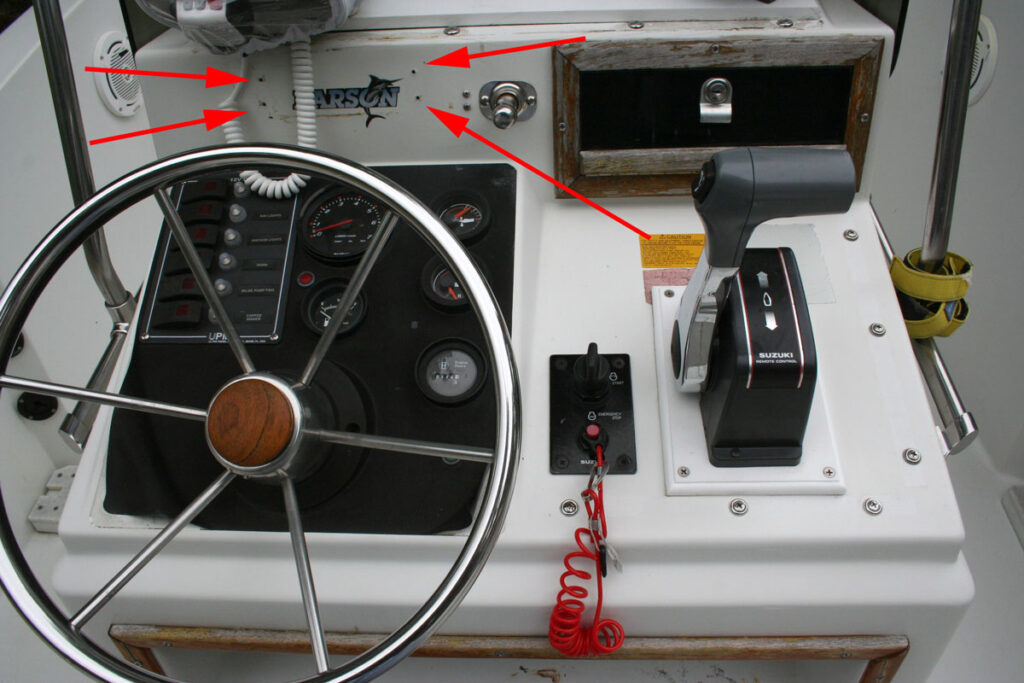
After it dries completely, lightly sand the area with extra-fine sandpaper until the overfilled area matches up with the pre-existing surface. Then wet-sand with a super-fine grit sandpaper until the surface is completely smooth. Finally, give the area a couple of coats of paste wax.
Fixing Cracks in Fiberglass
Fixing cracks is a bit tougher, because they don’t have enough surface area for the gelcoat paste to adhere; you can’t just smoosh it in there and hope for the best. First, you need to open up the cracks with a Dremel tool. Use a silicon carbide or tungsten carbide bit shaped like a cone, and be sure to grind deep enough to expose the uncracked fiberglass beneath. Keep in mind that adding lots of pressure to a Dremel won’t produce the best results. Instead, run it along the cracks multiple times with light pressure.
When the cracks have all been ground away, sand the exposed areas with fine-grit sandpaper to remove any burrs or jagged edges. Then wipe down all the areas with Interlux 202 or acetone to eliminate contaminants.

From here on out the repair process is the same as for chips and dings. However, if the cracks surround a high-stress area like the attachment point for a rail or a T-top support, there’s a good chance the cracks will reappear over time. It may be necessary to add backing plates or some other form of structural support to prevent a recurrence.
What about making repairs when the raw fiberglass cloth beneath the gel coat has been damaged? At that point, it should really be considered major as opposed to minor. So, if shards of matt or woven roving are showing call in the pros.
- More: Boat Repair , Fiberglass , Gear , Maintenance , Yacht Maintenance , Yacht Repair
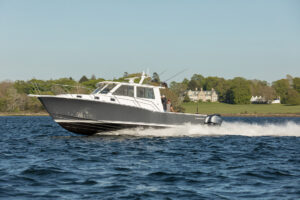
Newport Boat Show Announces New-Product Winners
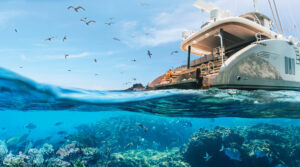
Sunreef Yachts and North Sails Champion Eco-Friendly Build Materials
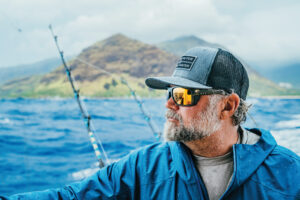
Marine-Friendly Sunglasses
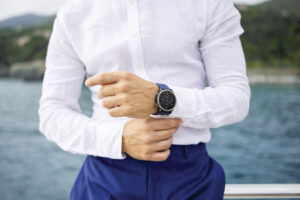
Garmin Quatix Upgrade
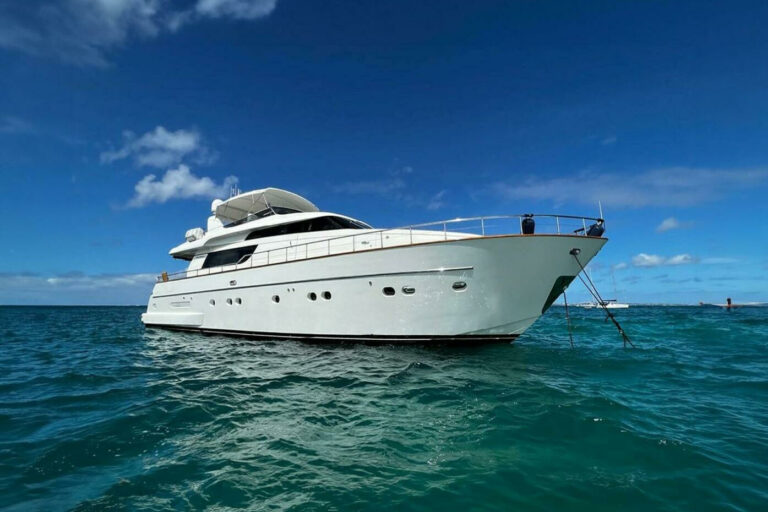
Caribbean Cruiser: Sanlorenzo SL72 For Sale
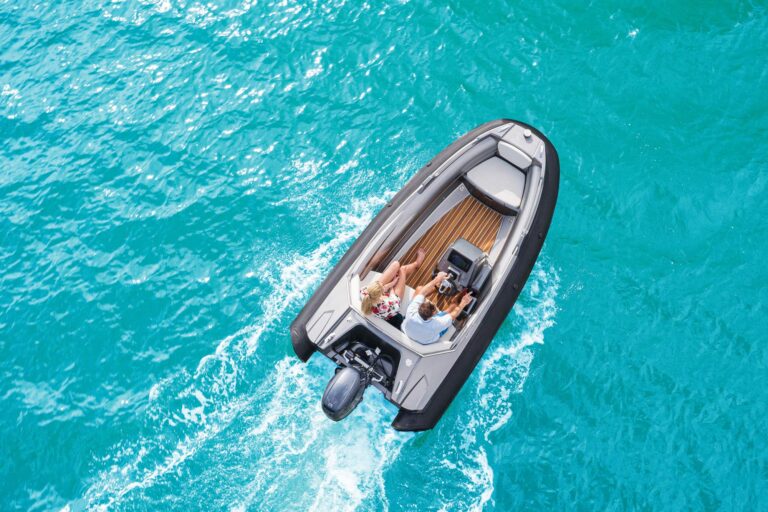
Customize Your Ride: The Argos Nautic GT14 RIB Tender
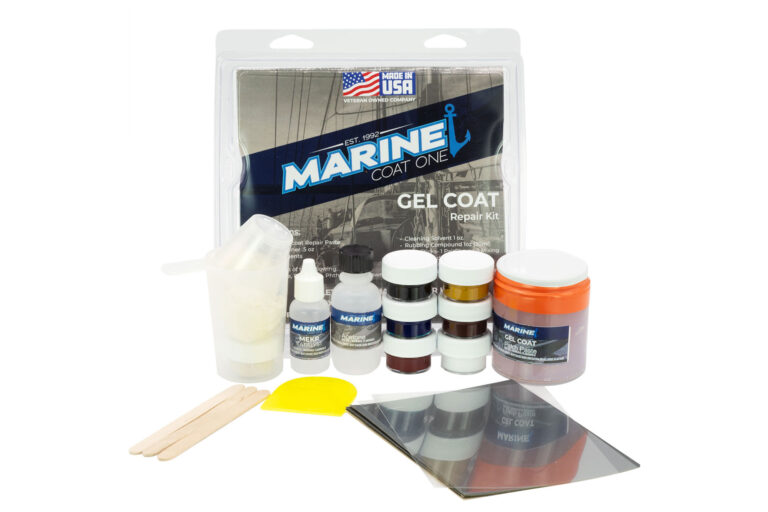
For Sale: 2004 Cheoy Lee 81 Sport Yacht

- Digital Edition
- Customer Service
- Privacy Policy
- Terms of Use
- Email Newsletters
- Cruising World
- Sailing World
- Salt Water Sportsman
- Sport Fishing
- Wakeboarding
- Weather Guides For Every Country In The World
- Algeria: Two Week Journey
- Cairo Travel Guide
- Best Time to Visit Lesotho
- Burkina Faso
- Central African Republic
- Côte d’Ivoire (Ivory Coast)
- Democratic Republic of the Congo
- Equatorial Guinea
- Guinea-Bissau
- Best Time to Visit
- Entry Rules and Visa requirements
- Salt Cathedral of Zipaquirá
- Dominican Republic
- Antigua and Barbuda
- El Salvador
- Afghanistan
- Bahrain Travel Guide
- The Cook Islands
- Aktau, Kazakhstan: Travel Guide and Tips
- Roadtrip in Western Kyrgyzstan
- Journey around Issyk-Kul
- Pakistan travel guide
- Albania Road Trip Guide
- Albania’s Entry Rules
- Yerevan Travel Guide
- Faroe Islands
- Suburbs of Paris
- Batumi Travel Guide
- Tbilisi Raves
- From Mestia to Ushguli (Svaneti) Trekking Route
- Transadjarian Highway
- Peloponesse Road Trip Guide
- Milan Travel Guide
- The Ultimate Venice Guide
- Modern Milanese architecture
- Budva Travel Guide: Montenegro’s main resort
- Montenegro Road Trip Guide
- Transylvania
- Yakutsk Travel Guide
- Journeying Through History: The BAM Railway Experience
- Veliky Ustyug Travel Guide: Meet the Ded Moroz
- Belgrade’s Cultural Guide
- Belgrade Off the Beaten Path
- Road Trip Guide
- Istanbul 🇹🇷: Hand-Painted Signs from a Century Ago
- From Grodno to Brest: a roadtrip
- Bosnia and Herzegovina
- Holy See (Vatican)
- Liechtenstein
Sakhalin: Your Essential Guide to Russia’s Enigmatic Eastern Island
- January 14, 2024
A Journey Through Giant Burdocks, Wild Bears, and the Echoes of Ancient Japanese Temples
From the most dreaded place of exile in the Russian Empire to a Japanese industrial base and one of the most attractive and inaccessible places for domestic tourism in Russia.
Table of Contents
An island that was Russian, then Japanese, and then Russian again
From the 17th to the mid-19th century, it was believed that Sakhalin was a peninsula. This misconception firmly established itself on the maps of the time, as navigators failed to circumnavigate the island. The proximity of Sakhalin’s southern tip to the mainland created a false impression of being impassable for ships. An additional complexity arose from the fact that the route taken by ships from the Russian Empire involved passing through a narrow strait, which Nevelskoy managed to navigate only in 1849.
For a long time, people did not believe Nevelskoy, but he insisted that he had discovered a route through the strait, for which he became something of a hero in Primorye. Monuments and plaques dedicated to him can be found in Yuzhno-Sakhalinsk, Vladivostok, and Khabarovsk. The H4H creative association created a graphic novel based on this story, which won a cultural initiatives contest and became part of the interior of the Khabarovsk Airport. By the way, the Sakhalin region is the only Russian entity entirely located on islands.

The remote and isolated location of the island during the Russian Empire was used as a natural barrier, and it became the site of penal colonies for hard labor prisoners. Its geographical position led to Sakhalin’s hard labor being regarded as particularly cruel.
During the period of the island’s development, Russian ships followed the Amur River and reached the island from the north, where the oldest port, Alexandrovsk, was founded. The Japanese attempted to develop the island from the south, entering through the Kuril Islands (part of the Sakhalin region) and Aniva Bay. For a long time, the Kurils were inhabited by the Ainu, representatives of a small indigenous people. The very word “Kurils” comes from the Ainu: “kuru” means “man.”
In the 17th century, Japan conducted its first expeditions towards the islands and began their development. Russia reached them later. The first mentions of the islands in Russian language date back to the late 17th century. For a long time, Russian, Dutch, Japanese, and Anglo-French navigators studied the islands, landed on them, and disputed their territorial ownership. However, only Russia and Japan managed to establish a foothold. To end the territorial disputes, the governments of the two countries signed an agreement under which the Kuril Islands went to Japan, and Sakhalin to Russia, which continued to develop the island mainly from the north. After the Russo-Japanese War of 1904-1905, which ended in Russia’s defeat, the southern part of Sakhalin became part of Japan as the Karafuto Prefecture.

Until the second half of the 20th century, the island was owned by Japan and was quite successful in developing its resources. A huge number of mines were opened, several cities and lighthouses were built. In particular, the current regional center, Yuzhno-Sakhalinsk, was the former Japanese city of Toyohara. The famous Aniva lighthouse, now considered a symbol of Sakhalin, was built by Japanese engineers. After Japan’s defeat in World War II, the island passed to the Soviet Union. Contrary to history, the main life of the island moved from the north to the south. Alexandrovsk, which was convenient to reach by water, lost to Yuzhno-Sakhalinsk with its infrastructure built by the Japanese, connections to neighboring cities, and airport. Interestingly, before leaving, the Japanese buried and hid the mining sites, and locals say that not all the old mines have been found yet, and they are sometimes stumbled upon during walks.
Because the island belonged to three different countries in just over a hundred years, it did not have time to develop any significant urban infrastructure. The cities lack outstanding architectural monuments and unique museums. However, some unusual Japanese architecture has remained. Meanwhile, Sakhalin compactly houses incredible natural attractions. Here, one can climb through forests and bamboo thickets to breathtakingly beautiful mountains as if outlined in graphite, and through a mountain pass reach the sea, into which clear mountain rivers flow with fish splashing in them.

The Ainu and Nivkh: Inhabitants of Sakhalin
For a long time, the island was mainly inhabited by the Ainu and Nivkh peoples. These ethnic groups are very different, making their coexistence as unusual as the neighboring of birch and bamboo on the slopes of Sakhalin’s mountains. Both are isolate peoples . However, the Ainu belong to the Australoid race, while the Nivkh are Mongoloids (the main population of Asian territories). It’s fascinating how representatives of different races have coexisted for ages on a small piece of land at the edge of the world.
There is no single version regarding the origin of the Ainu, leading to a multitude of theories — both scientific and conspiratorial. One theory suggests that the Ainu are the ancestors of the indigenous population of Australia, remaining in the north after continental migration. Some researchers write that the Ainu are the forebears of the Japanese. This theory is supported by the fact that before Japanese expansion, the Ainu mainly inhabited the Japanese island of Hokkaido. However, the Ainu suffered greatly from Japanese imperialism, and their culture and language were almost completely destroyed in the 19th and early 20th centuries. Now, there are just over two thousand Ainu living on Sakhalin.

The Nivkh are among the indigenous small-numbered peoples of the north. They suffered less from Japanese rule. However, during the Soviet era, they experienced a difficult phase of literacy development, destruction of tribal communities, and relocation to cities. About 2,200 Nivkh live in the Sakhalin region and another approximately two thousand in Khabarovsk.

During the Karafuto period, Japan brought captured Koreans to Sakhalin for hard labor. By the mid-20th century, the Korean population of the island was about 45,000 people. For comparison, the current population of Yuzhno-Sakhalinsk is 180,000. This large number of people, deprived of their homeland, was forced to adapt to life first under Japanese and then Soviet rule. In the USSR, Koreans were issued passports, and there were national kindergartens and schools. However, Sakhalin Koreans did not feel part of the larger community of Soviet Koreans (Koryo-saram) and struggled to integrate. Moreover, they were considered members of an ‘unreliable nation’ because they had lived in the Japanese Empire.

In the late 1990s, three countries – Russia, South Korea, and Japan – began a repatriation campaign for the first generation of Sakhalin Koreans (born before August 15, 1945) to their historical homeland. Now, about 3,500 repatriates from Russia live in South Korea. Under the program, the Korean government provides medical insurance and a monthly allowance to the repatriates. The Japanese government, in turn, buys housing (apartments up to 40 m²) and covers transportation costs. Additionally, every two years, Sakhalin Koreans who have moved to their homeland have the right to visit Sakhalin for free, funded by the Japanese government. Most Sakhalin Koreans settled in the city of Ansan , where 500 apartments were specially built for them.
Korean influence is weakly traced on Sakhalin: many Sakhalin Koreans no longer know the language and do not associate themselves with Korea. However, there are several authentic restaurants (for example, “Koba” ) on the island where you can try traditional dishes.
Yuzhno-Sakhalinsk — the capital and base for exploring the island
The city is predominantly characterized by typical Soviet architecture, with almost no remaining Japanese buildings. This is because during the Soviet period, the city was radically rebuilt after being liberated from ‘imperialist Japanese rule.’ Many buildings were demolished, and from the few that remained, some were turned into museums. Perhaps the main thing that has been preserved from the Japanese period is the layout. The city was founded from scratch near the Russian village of Vladimirovka, and Chicago was chosen as the model for its layout. Toyohara was divided into four parts by two main streets, O-dori (now Lenin) and Maoka-dori (Sakhalinskaya).

Japan established itself thoroughly on the island. In Toyohara, trade routes converged, new bays were developed, and roads were built. The city’s population grew steadily. Initially due to the military garrison, and later due to a paper mill, a sugar and distillery plant. Now, the buildings of the former Japanese factories are abandoned. Many of them can only be accessed with rare tours, while others are completely closed. However, their presence is still recalled by street names, such as Paper Street.

Another building in the Neo-Japanese style is the Karafuto Governorate Museum built in the 1930s (29 Communist Avenue). It now houses the Sakhalin Regional Museum . And in the former bank of colonial development, there is the Art Museum (137 Lenin Street).

Several other iconic buildings constructed by the Japanese have been preserved: the central hospital of Toyohara (41 Chekhov Street), the conference hall of the Karafuto Governorate (30 Dzerzhinsky Street), and the Toyohara City Hall (41 Communist Avenue). The Sakhalin Railway Museum in Yuzhno-Sakhalinsk is distinct from many similar museums in Russia due to its exhibits. This is because the island long maintained the Japanese standard of railway gauge, which differs from the Russian standard. Accordingly, the rolling stock was entirely different.
If in Vladivostok everything is named after the Far Eastern explorer and writer Vladimir Arsenyev, then in Yuzhno-Sakhalinsk, mentions of Chekhov are everywhere. At the end of the 19th century, Sakhalin was both the most dreaded place for exile to hard labor and one of the most tempting corners of Russia, which was not so easy to access. Chekhov received an editorial assignment and embarked on a ship along with prisoners, military personnel, and sailors to the most remote point of the empire. In his notes, which Chekhov compiled under the title ‘The Island of Sakhalin,’ the writer talked about many things: the geography and climate of the island, the life of the convicts, and ordinary residents. This book caused a great resonance at the time, and even now it was very interesting to read it while traveling to Sakhalin: some things have changed drastically, while others have remained the same. Now in Yuzhno-Sakhalinsk, there is even a museum dedicated to this one book, which turned out to be so significant for the island.
GoSakhalin is the website of the Sakhalin Tourist and Information Center. And in their official Telegram channel , you can find announcements of affordable excursions shortly before they start.
In any case, for travelers, Yuzhno-Sakhalinsk remains primarily a hub and a place of rest. Here they return for the night and dinner, and it seems that real adventures begin outside the doorstep.
Surrounding Area
10–20 kilometers from Yuzhno-Sakhalinsk
The main reason people visit Sakhalin is for its unique nature. Mountains, forests, rivers, lakes, and the sea, all on a small piece of land. In one day, you can travel from the Sea of Okhotsk to the Sea of Japan, cross several climate zones, see bamboo groves, birches, and spruces in one place, spot a running fox and a swimming orca. The island’s landscapes can boldly compete in Instagram appeal with Iceland or Norway.
Within Yuzhno-Sakhalinsk alone, there are about 30 kilometers of marked ecotrails, with brief descriptions and routes available on the official tourism portal. I also found an ecotrail in Nevelsk, which is not mentioned on the official website.
The ecotrails in Yuzhno-Sakhalinsk start from the ‘Mountain Air’ ski center on the sopka (a term for mountains in the Far East) Bolshevik. There are five in total: ‘Children’s’ (2.7 kilometers), ‘Eight’ (8 kilometers), ‘Northern Ring’ (9 kilometers), ‘Russian’ (3.2 kilometers), and ‘Yelanka’ (5 kilometers). You can take a cable car to the start of the trails and then slowly descend through the forest and park to the city. However, the lift does not operate in rainy and windy weather.

Hiking the ‘Eight’ trail took me no more than three hours, including stops to catch my breath and take photos. Every kilometer and a half along the route, there are benches. From the top of the mountain, there is a view of Yuzhno-Sakhalinsk, and it seems you can see a piece of the Sea of Okhotsk.

Chekhov Peak
The route to Chekhov Peak is a high-mountain trekking path that requires a certain level of physical fitness. Chekhov Peak has an elevation of 1045 meters, with an absolute altitude gain of 752 meters. The trail is narrow and slippery in places, hardly suitable for children or people with limited mobility.

Chekhov Peak is part of the Susunai Range, which supports Yuzhno-Sakhalinsk from the southeast. You can exit from Gagarin city park to the foothills in about half an hour. The ascent to the peak itself cannot be missed: a marked trail and informational signs lead to it. On particularly steep ascents, ropes are hung for safety, but it is possible to walk up the slope without them.
In late spring, the forest trail has many streams, as well as May primroses and butterflies. The foothills are scattered with rare, incredibly large, and wonderfully fragrant marsh callas. Halfway to the peak, bamboo thickets are encountered, through which birches break through. This is also a kind of magic because, as a biologist friend explained to me, birch and bamboo are not supposed to coexist in the natural environment, but somehow they manage to do so. Occasionally, spruces are encountered — not tall, but very fluffy. Closer to the top, the vegetation becomes sparser, and the impressive views of the sea, mountains, and lakes open up from the height.

- The entire hike takes five to six hours.
- Even in summer, there is snow on the summit. In the afternoon, it starts to melt, making it more difficult to walk.
- Don’t forget to bring food and water.
- Wear boots with covered ankles, a jacket, and a head covering.
- Inform your family and friends, and someone living in Sakhalin, before setting out on the route. If you’re traveling alone, you could notify, for example, the hotel receptionist or roommates in a hostel.
- Snakes and bears are found around the trail. Watch your feet and try to make as much noise as possible. For example, play music on your phone and sing along occasionally.
- The ascent to Chekhov Peak can be the start of a journey to the village of Lesnoye on the shore of the Sea of Okhotsk. The distance to the village is 27 kilometers. With good preparation and an early start from Yuzhno-Sakhalinsk, this distance can be covered in one day.

Mud Volcano in Klyuchi
A mud volcano is an eruption on the earth’s surface of clay masses, mineralized waters, and gases. The mechanism of formation of these volcanoes is not fully understood. According to the existing theory, such volcanoes are formed near oil fields.
The mud volcano in Klyuchi consists of a mud field about 200 meters in diameter. There, you can see about 20 points of activity, resembling miniature volcano craters. This mud volcano became active in 1959, 1979, 2001, and 2011 (the last time due to a strong earthquake in Japan). During these eruptions, mud columns reached several tens of meters in height. Bus 189 goes to Klyuchi from Yuzhno-Sakhalinsk. The distance from the village to the top of the volcano is nine kilometers and takes about two and a half hours to walk.

Ecopark in the Vestochka area: Frog Rock, Aikhor Waterfall, ‘Sunny Glade’ Recreation Park
Not far from Yuzhno-Sakhalinsk, there is a fairly large ecopark, known primarily for the Frog Rock outcrop. An outcrop is a remnant of harder rock around which softer rock has eroded over time. Outcrops are often known for their unusual shapes and are natural monuments. Frog Rock is part of a series of rocks standing one behind the other. This was once the seabed of an ancient sea, and fossilized shells can be found in its vicinity. From the top of the rock, amazing views of the Aniva Bay, Tunaycha and Changeable Lakes open up. This place was sacred to the Ainu, the indigenous inhabitants of the island.

The trail to the ‘Sunny Glade’ ecopark begins behind the ‘Electron’ culture house. Despite its name, it is not a city park, but a full-fledged forest with laid-out paths. There are houses, glades with tables for rest where you can cook barbecues, and wooden walkways leading to various attractions. These are all paid services.

The path to Frog Rock outcrop goes along the Komissarovka River. In areas of spring flooding, callas bloom and bamboo grows. The outcrop is located on a hill, with a total elevation gain of about 300 meters. The road is quite challenging, usually taking from an hour to an hour and a half. The higher you climb, the more you can see: the sea, the mountain gorge, the road to Vestochka. In the same park is the Aikhor Waterfall, which is also a short climb away, but along a less well-maintained trail. You can plan a whole day to visit Vestochka and even spend the night, without returning to Yuzhno-Sakhalinsk.

Vestochka is three high-rise buildings on one side of the road and a cottage settlement on the other. It is part of Yuzhno-Sakhalinsk, though located 15 kilometers from the main part of the city. A taxi there costs about 1000 rubles and takes 40 minutes. About a kilometer after turning off the main road, the asphalt ends and a terribly dusty dirt road begins. If you’re lucky, you can catch a bus that runs three times a day.
What else to see on the island
40 kilometers from Yuzhno-Sakhalinsk
The oldest city in the south of Sakhalin, founded by Nevelskoy’s expedition. Here you can find a huge number of monuments dedicated to sailors, naval battles, and ships. The most significant monument in the city in recent decades has become the stele dedicated to ‘Koreans interned by the Japanese in Sakhalin, who never returned to their homeland,’ located on Mount Sorrow, created through the efforts of three countries’ governments (Russia, Japan, and Korea).

In Korsakov, some Japanese heritage has been preserved: the former building of the Hokkaido Takushoku Bank, a colonial development bank (Sovetskaya Street, 3), trade warehouses in the port, a document storage facility ‘Bunsyoko’ (Krasnoflotskaya Street, 1), a couple of rusty fire hydrants, and remnants of Shinto temples in the form of pillars with hieroglyphs. One of the local nighttime entertainments is watching the lights of the gas processing plant.
How to get there. Three electric trains a day, the journey takes just over an hour, and the ticket costs 75 rubles (0.73 euros).

Bird and Giant Capes
90 kilometers from Yuzhno-Sakhalinsk
Two capes, recognized as natural monuments in 1990, along whose coasts are many wind and wave-carved grottoes, caves, arches, and columns of various sizes and whimsical shapes, among which colonies of sea birds reside.
The place is not very close, but it’s very picturesque at any time of the year. In the area of one of the rocks, there is a pool where, during the salmon spawning period, you can observe a fascinating spectacle — a huge gathering of pink salmon.
Many tourists stay on the coast overnight to witness the sunset and sunrise. Near Cape Giant, there is a toilet, parking, and a rest area with benches.
How to get there. The journey from Yuzhno-Sakhalinsk goes through the village of Okhotskoe, where you can buy fresh crabs, and takes about three hours one way. The road is fully passable only by high vehicles like Mitsubishi Pajero, Suzuki Jimny, as the last ten kilometers of the route have deep puddles, potholes, small cliffs, and rivers.

Nevelsk and Steller Sea Lions
Nevelsk is nestled between mountains and sea. The rocky mountains and the coast, which consists of small stone needles and shells, in every way explain why Chekhov so often mentioned in ‘The Island of Sakhalin’ how harsh the land of Sakhalin is.

Steller sea lions are the largest of the eared seals. One of their habitats is the breakwater in Nevelsk. As soon as you arrive in the town, the smell from the Steller sea lions’ haul-out site hits you. ‘They eat there, live, give birth to their young – that’s why it smells,’ the locals explain. Another feature is the noise. Steller sea lions are very loud!
You can view the sea lions from the central square, where binoculars are installed. However, tourists usually hire a boat and approach the haul-out site to get a closer look at the seals. You can see how the Steller sea lions bark, lie in the sun, jump into the sea and, most interestingly, try to jump back. The views from the square through binoculars are not as detailed and impressive. A place on the boat will cost 1000–1500 rubles (9.79 – (14.68 euros). You can also buy a tour from Yuzhno-Sakhalinsk for 3500 rubles (34.25 euros). The most animals are present in spring and early summer. In autumn, there may be a couple of dozen individuals left.

From the embankment, you can observe the huge kelp laminaria floating in the sea. Some travelers catch them themselves and eat them. Although dishes made from seaweed are found in cafes and also sold in stores. Signs are installed on the shore indicating where to run in case of a tsunami. The last major earthquake with waves was recorded in 2007. Many houses were destroyed and two people died. The most famous Sakhalin tsunami was the 1952 tragedy , when the aftermath of the earthquake almost completely destroyed Severo-Kurilsk.
How to get there. From the bus station (Karl Marx Street, 51b) in Yuzhno-Sakhalinsk, buses go to Nevelsk, the ticket costs 300 rubles (2.94 euros), and the journey takes about an hour. Tickets can be purchased at the bus station ticket office or from the driver (cash or transfer). It’s not possible to board the bus somewhere in the city, as the bus does not make stops. It’s better to buy a return ticket immediately upon arrival in Nevelsk at the Nevelsk bus station ticket office (Lenina Street, 1). The bus is popular with locals, and there may simply be no seats left.
Remnants of structures from the Karafuto period include the Maoka-Jinja temple with a Japanese-style garden and an abandoned railway built by the Japanese. It used to connect Kholmsk with Yuzhno-Sakhalinsk. Tourists usually come to see two photogenic bridges – Devil’s and Witch’s – and a tunnel in the mountain that makes a full circle inside it. The trail passes along the old rails, and there are many vipers, so one needs to watch their step.
How to get there. The bus to Kholmsk takes two hours, the ticket costs 450 rubles (4.40 euros), with 14 trips a day.

Slepikovsky Cape and Lighthouse
120 kilometers from Yuzhno-Sakhalinsk
At Slepikovsky Cape, there is the only relic grove of Korean cedar on Sakhalin. Also located here is the functioning Slepikovsky Lighthouse, which is a 27-meter tall round tower, connected by corridors to utility and residential buildings.

The cape and lighthouse are named after the commander of the Russian partisan detachment Bronislav Grotto-Slepikovsky, who operated in Southern Sakhalin during the 1904–1905 war. The route to the lighthouse goes through the villages of Yablochnoe and Sadovniki, where some of the best beaches on Sakhalin are located — with the cleanest water and white sand.
How to get there. The cape is located 29 kilometers north of Kholmsk. From Kholmsk to the turn towards the lighthouse, there is asphalt with dirt sections. From the turn to the lighthouse, there is first a dirt road, then beach sand, which is recommended to be driven on with deflated tires. Visiting time is from spring to autumn, as the road to the cape is not cleared in winter.
110 kilometers from Yuzhno-Sakhalinsk
In 1891, when the island had a penal colony, this was the Russian village of Siraroko, named after a nearby Ainu settlement. In 1905, the south of Sakhalin was given to the Japanese, and the village was renamed Higashi Shiraura. Here there were a railway station, a brick factory, and a coal mine. 40 years later, the settlement was renamed Vzmorye.
During the Japanese times, there was the Shinto shrine Higashi Shiraura Inari-Jinja. Only the torii gates remain — P-shaped gates without doors that are placed on the path to a Shinto shrine. These are the only torii on Sakhalin. On the torii, there is an inscription ‘In honor of the 2600th anniversary of the foundation of Great Japan’ — this mythological date was widely celebrated in 1940.

On the way to the torii, you can see the famous giant burdocks and bear’s garlic. Vzmorye is also known as a place where poached crabs are sold along the highway.
How to get there. Two electric trains and one train that start from Yuzhno-Sakhalinsk stop in Vzmorye. Unfortunately, all three are in the evening. You can also get there on passing buses that go to the north of the island.
Tikhaya Bay
140 kilometers from Yuzhno-Sakhalinsk
On one side, the bay is framed by Mount Smely, and on the other side, the majestic Zhdanko Ridge begins. To the left in the bay itself is an island-kekur, which can be reached during low tide, as well as the epic cliffs of Tikhaya Cape. By the way, behind this cape, there are waterfalls that become icefalls in winter. At the base of the bay is the mouth of the Tikhaya River, where during the season you can see the spawning of pink salmon and chum salmon. Bears are aware of this, so they are often encountered here.
How to get there. Buses going to Poronaysk stop in the village of Tikhoye, near which the bay is located. There are four trips a day.

Aniva Lighthouse

The lighthouse has a complex history: there were attempts to maintain it under Soviet rule, but Aniva was so remote from inhabited areas that it was not profitable. Eventually, the lighthouse was switched to autonomous mode, bringing in a radioactive isotope to sustain its operation, and then it was completely closed. To this day, you can find signs on the walls reading ‘Caution, radioactive’. But now this warning is outdated, as the radioactive isotope was removed when the lighthouse was decommissioned. The lighthouse is very beautiful, offering views of the island and sea, and inside you can explore the remnants of rooms and working areas.

On the return trip, tourists are also taken to Mramornaya Bay, where you can also climb a mountain and view the jagged coast of Sakhalin from above. Orcas and whales are often encountered in these areas, most frequently in summer. I would also recommend taking a combined tour in summer to Aniva Lighthouse, the Blue Lakes, and Busse Lagoon, where you can see the amazingly blue waters and try sea urchins.

A kilometer from Novikov is Cape Tri Kamnya (46.320342 143.373006), which can even be reached by car. Four kilometers from the cape is the small Strelka waterfall , which requires a walk. If you stay in the village overnight, you can take a hike to the Blue (turquoise) Lakes (46.359603, 143.471909). On the way, there’s an abandoned Japanese power station. You can extend your route by another 15 kilometers and reach the opposite shore of the peninsula – to Cape Evstafiya. The road from Novikov to Cape Evstafyeva through the Blue Lakes can be driven in a jeep, if there hasn’t been prolonged rain before. But it’s better to ask in advance those who have recently been there, and get the phone number of a local tractor driver in Novikov, so that if something happens, he can pull you out.

How to get there. Getting there independently is almost impossible. The lighthouse is located on a rocky outcrop in the sea, and the nearest land is a high cliff. However, some people do reach Novikovo (the nearest village) by bus or car, and then walk 44 kilometers on foot to Aniva (the name of both the lighthouse and the bay). It takes about one and a half hours to drive from Yuzhno-Sakhalinsk to Novikovo. And then another two hours of rough dirt road to the boat dock. A tour from the company ‘Friends-Hikers’ costs 6000 rubles (58.72 euros) in May (in summer – 7000 rubles (68.51 euros)).
Klokovsky Waterfall
190 kilometers from Yuzhno-Sakhalinsk
Klokovsky Waterfall is one of the highest waterfalls on Sakhalin Island. Its height is variously reported to be 48–49 meters, with a width of up to nine meters. The waterfall is accessible year-round, but is most full in late spring and early summer.

Alexandrovsk-Sakhalinsky

The ‘Tri Brata’ (Three Brothers) rocks are definitely a symbol of Alexandrovsk-Sakhalinsky, and perhaps of the entire island. They are located in the Alexandrovsk Gulf almost opposite Cape Zhonkiyor. From the cape, there is a stunning view of the vast Tatar Strait and the Three Brothers. At low tide, it’s possible to calmly explore all the attractions of the gulf, collect seaweed and shells, see hermit crabs scuttling along the seabed with their shells on their backs, or watch the leaves of laminaria sway. At the strongest low tide, you can even walk to the Three Brothers through the water.

In the 19th century, convicts carved a 90-meter tunnel through Cape Zhonkiyor to service the lighthouse. To reach the tunnel by land, you need to come at low tide. Otherwise, you’ll have to climb the rocks. The tunnel is lined with logs, but there is almost always water at the bottom and a strong wind howls through it. If you pass through the tunnel, you will see the ‘Tri Sestry’ (Three Sisters) rocks and an old lighthouse from the end of the 19th century. All these places are described by Chekhov in ‘The Island of Sakhalin’: ‘Most often we went to the lighthouse, which stands high above the valley, on Cape Zhonkiyor. During the day, the lighthouse, if looked at from below, is a modest white house with a mast and lantern, but at night it shines brightly in the darkness, and then it seems that the penal colony looks at the world with its red eye. The road to the house climbs steeply, winding around the mountain, past old larches and firs. The higher you climb, the freer you breathe; the sea spreads before your eyes, thoughts gradually come, having nothing to do with the prison, the penal colony, or the exile settlement, and only then do you realize how dull and difficult life is down below.’
How to get there. From Yuzhno-Sakhalinsk, there is one bus trip per day – at 12:10. The ticket costs 2200 rubles (21.53 euros), and the journey takes nine hours.

600 kilometers from Yuzhno-Sakhalinsk
The main transit point on the way to the oil refineries. The village might be of interest to those curious to see a harsh northern town living off production: low-rise buildings made of siding and unexpectedly bright murals on the walls of five-story buildings. There is a local history museum in the village (Sovetskaya Street, 3) – it is praised for its excellent exhibition of the Nivkh culture and a monument to Nevelskoy. Also, one of the longest rivers of Sakhalin, the Tym (which translates from Nivkh as ‘spawning river’), flows through the town.
How to get there. A night train goes to Nogliki every day, taking almost 12 hours. The cheapest ticket in a seated carriage costs 1100 rubles (10.77 euros), a compartment – 4100 (40.13 euros). There is even a luxury (SV) carriage for 12600 rubles (123.31 euros).
Where to Stay
Hostels in the Far East are divided into work and tourist types. The former will also accommodate tourists, but the atmosphere there is like a dormitory where their own rules are already established, and you may feel like an uninvited guest. To avoid such a hostel, it’s important to carefully read the reviews, not book the cheapest hostels, not stay on the outskirts or near airports and train stations.
In the Islander hostel , mainly travelers stay, it’s very cozy, with convenient kitchen and showers with toilets. A double room costs 3000 rubles per day, and dorms – from 900 rubles (8.81 euros) per night. If you book directly through the website and for a long term, you can get a good discount.
The ‘Moneron’ hotel is located near the railway and bus stations. It’s a classic budget hotel with small clean rooms. The ‘comfort’ class rooms have a bath, and the hotel provides a complete set with slippers, towels, and a hairdryer. Prices start from 2800 rubles (27.40 euros) per night for a single economy room, while ‘comfort’ costs 4900 rubles (47.95 euros). Breakfast is included in the price.
The ‘Belka’ hotel building is made using Finnish technology in a wooden style from milled timber. The cost of large rooms with wooden walls and huge beds starts from 5800 rubles (56.76 euros). Breakfast is also included in the price. The hotel complex includes a sauna, spa, tavern, and gym.
Near Bussé Bay is the island’s only dome-shaped glamping site. A night for two costs 8000-10,000 rubles (78.29 – 97.87 euros). An extra bed is 2000 (19.57 euros). Each dome has a shower, toilet, and electricity. On cooler days, you can light the stove and sit by the fire with a cup of hot cocoa.

In other towns, apart from Yuzhno-Sakhalinsk, the choice of hotels is quite modest and usually limited to one or two hotels, which cannot always be booked online. They have to be found on the map and booked by phone.
Transport on the Island
Car. If you’re only traveling between cities, there won’t be any problems – the roads between them are mostly paved, and the dirt roads are of more or less good quality. It gets more complicated with natural attractions. Almost all of them are accessed by dirt roads, which not every car can navigate.
In Yuzhno-Sakhalinsk, ‘Yandex.Taxi’ and ‘Maxim’ operate (also in Korsakov and Kholmsk). A trip within the city limits will cost a maximum of 300 rubles (2.94 euros).

Railway. From Yuzhno-Sakhalinsk, about 30 electric trains depart daily. Most of them go to nearby areas like Dalnyaya, Khristoforovka, and Novoaleksandrovka stations – 8–23 minutes travel time.
To other cities, there’s only one electric train per day. It takes an hour to Korsakov and the ticket costs 80 rubles (0.78 euro). To Tomari, it’s four hours and 300 rubles (2.94 euros). To Poronaysk, it’s five hours of travel and 500 rubles (4.89 euros) for a ticket. Long-distance electric trains depart in the evening, as these routes are used by residents of the province who return from work in Yuzhno-Sakhalinsk to their homes.
There is also one train on the island – Yuzhno-Sakhalinsk to Nogliki, 12 hours of travel and 1100 rubles (10.77 euros) for a ticket in a sitting carriage.

Buses. It seems you can reach even the most remote settlements by bus. Often there’s only one trip per day, but at least it exists. To Kholmsk, Nevelsk, and Korsakov, the journey takes about an hour and a half, with tickets costing around 300 rubles (2.94 euros); to Poronaysk and Uglegorsk, it’s four to five hours and 1200 rubles (11.74 euros) for a ticket. You can check the current schedule on avtovokzaly.ru . But it’s always better to double-check by phone: +7 (4242) 72-25-53. The address of the bus station is Karl Marx Street, 51b.
Airplane. Sakhalin has a quite extensive network of airports, and you can fly from Yuzhno-Sakhalinsk to Okha, Zonalnoye, Shakhtyorsk, Poronaysk, Smirnykh, Yuzhno-Kurilsk, and Iturup. Flights are operated by the Far Eastern airlines ‘Aurora’ and ‘Taiga’ . These routes are served by small propeller planes Bombardier and Mi-8 helicopters. Such a flight is an interesting experience in itself. Moreover, some flights are quite inexpensive. For example, to Zonalnoye, Shakhtyorsk, and Poronaysk, tickets cost 2000–3000 rubles (19.57 – 29.36 euros) one way. To Okha and the Kurils – from 6000 rubles (58.72 euros).
Ferry. From Korsakov, ferries run to different settlements in the Kurils every three to four days. The ferry to Kurilsk takes about 22 hours, to Yuzhno-Kurilsk – 22–30 hours, and to Malokurilskoye – about 40 hours. Interestingly, a ticket to any of these settlements costs from 2800 rubles (27.40 euros), available on the website of the ferry company.
How to get there
By plain. To travel to Yuzhno-Sakhalinsk from Europe, passengers typically fly through major transit hubs. Common routes involve flying from a European city to one of the major Russian airports offering direct flights to Yuzhno-Sakhalinsk, such as Moscow’s Sheremetyevo or Domodedovo airports. In 2023 it is only possible to fly to Moscow from major transit hubs such as Istanbul or Erevan. From there, travelers can catch one of the direct flights to the island. Some routes might also include stops or transfers in other large cities in Russia or Asia, depending on the airline and the flight itinerary, for instance, Novosibirsk, Krasnoyarsk, Irkutsk, Ulan-Ude, Chita, Blagoveshchensk, Vladivostok, Khabarovsk, Komsomolsk-on-Amur, Sovetskaya Gavan, and Petropavlovsk-Kamchatsky. There is even one international flight from Harbin, China.
In good weather, on approach to Yuzhno-Sakhalinsk, you can see the Tatar Strait, the Western Ridge, and the city itself. The airport is located within the city limits, and from there, you can easily reach any point by public transport (buses 63 and 3) or taxi.

Ferry. Vanino (Khabarovsk Krai) to Kholmsk (Sakhalin) . Passenger tickets for the ferry are sold at the Vanino railway station or at the ticket office in Kholmsk (Lenin Square, 5). They can also be reserved by phone: +7 (42137) 74088 (Vanino), +7 (42433) 50880 (Kholmsk). The ferries run daily, with a journey time of 18–20 hours. A seat costs 650 rubles (6.36 euros), while the cheapest cabin spot is 1400 rubles (13.70 euros). There is a dining room on board.
I was on the island in early May, and this has its pros and cons. On one hand, it’s already not very cold in Sakhalin at this time, and you can walk around in a light jacket or sweatshirt, and sometimes even just in a T-shirt. At the end of spring, you can catch the largest number of Steller sea lions in Nevelsk (closer to summer they migrate towards Avacha Bay). Also at this time, you can see the forest awakening: streams penetrate it from all sides, in their floodplains swamp callas bloom, meadows fill with primroses, and the hills are covered with bright green bamboo shoots. On the other hand, there is still snow in the mountains, in which you can get stuck while climbing, and the sea, which is not very warm in these areas, is completely unsuitable for swimming.
In summer, Sakhalin is not very hot, the coast blooms with wild roses, the sea warms up a bit, and there is less chance of bad weather when visiting remote attractions. Also, it’s precisely at this time you can see orcas (June – July) and whales (July – August), as well as the salmon spawning.
In winter, snowboarders and skiers come to Sakhalin. The mountains on the island are not high, so they are suitable even for beginners.

Related posts:
- The Vertical Grain Elevator (Silo) in Samara — A Benchmark of Brutalist Architecture
- Kamchatka: “Island” of Volcanoes, Bears, and Red Caviar
- Yekaterinburg: A Comprehensive Guide to the Ever-Young and Protest-Ridden City
- Altai Republic (Russia) Travel Guide: A Journey through Twisting Mountain Roads
Leave a Reply Cancel reply
Your email address will not be published. Required fields are marked *
Save my name, email, and website in this browser for the next time I comment.
Scan performance of small boat RCS enhancers
Ieee account.
- Change Username/Password
- Update Address
Purchase Details
- Payment Options
- Order History
- View Purchased Documents
Profile Information
- Communications Preferences
- Profession and Education
- Technical Interests
- US & Canada: +1 800 678 4333
- Worldwide: +1 732 981 0060
- Contact & Support
- About IEEE Xplore
- Accessibility
- Terms of Use
- Nondiscrimination Policy
- Privacy & Opting Out of Cookies
A not-for-profit organization, IEEE is the world's largest technical professional organization dedicated to advancing technology for the benefit of humanity. © Copyright 2024 IEEE - All rights reserved. Use of this web site signifies your agreement to the terms and conditions.
Stuffed Zucchini Boats

If you have an excess of zucchini and want to prepare them in a delicious way, try these stuffed zucchini boats! Zucchini are scooped out and filled with a delicious Italian pork and fennel sausage and cheese. These are a delicious way to serve up this versatile vegetable for dinner and you can use this method to stuff all sizes of zucchini from small to huge!
Confession: I LOVE stuffed and roasted vegetables. They're such an easy way to serve up veggies in an appetising way and zucchini are particularly good for it as they are a milder tasting vegetable that can take on other flavours well. This was inspired by Yemista or Greek stuffed vegetables.

Tips for Making Stuffed Zucchini Boats

1 - I have a really handy little zucchini corer that makes fast work of coring the zucchini. You can find these at Middle Eastern stores.
2 - If you don't have pork and fennel sausage, you can sub with your other favourite sausage or you can also use mince like chicken, turkey or beef mince. You may just add a bit more seasoning as sausages have seasoning added to them.
3 - I actually recommend doubling the quantity and doing this in two trays. The leftovers are really delicious the next day and they reheat very well.
4 - Some recipes call for you to scoop out the seeds in the centre and discard them. We use them in the stuffing, especially with smaller zucchinis where the seeds are tiny and cook down well in the filling mixture.
5 - I cover these with foil for the first part of the cooking so that they don't dry out.
6 - Only add the cheese in in the last 10 minutes once you have uncovered the zucchini otherwise the cheese will brown and dry out.

Other Delicious Zucchini Recipes that you might like to try!
- Incredible Zucchini Slice
- Creamy Zucchini Hummus
- Stanley Tucci's Zucchini Pasta
- Gilli's Amazing Zucchini Pickles
Although zucchini aren't really my favourite vegetable and I wouldn't ever really buy them I get them in my vegetable box and every fortnight it's a mad scramble to use everything up. There are some vegetables that I love like salad leaves, tomatoes, broccolini and snow peas and there are some that I just want to use up. I don't think I've ever really thrown anything out because it has gone off because the vege box isn't cheap and I don't like to waste money or food.
I came across this phrase recently that I have started using. It's when someone is cheap they have "short arms". Like their hands can't reach to their pockets to pay for anything. Most of my friends don't have short arms. My friends and I are always giving each other things and we would honestly give the shirts off our own backs.
My friend Agatha (not her real name, she wants to stay anonymous on this in case her friend read this!) has a friend called April. Agatha is always doing things for April and April is not shy to ask for things.

"Could you pick me up?" April will ask even though she lives in the opposite direction and has a car. Agatha always drives them and when it comes to parking Agatha always ends up paying (and parking in Sydney isn't cheap). April stands there with her hands in her pockets or dawdling when getting out of the car. And when it comes to paying for dinner April often forgets to pay Agatha for her portion of the bill and she has to hassle her to get the money. She is fond of April and she does of course have a good, fun side but her attitude towards money is annoying for Agatha.
Every time I see Agatha she tells me about another instance where April has cheaped out. "She has short arms!" I told Agatha. She laughed and pointed out that April's arm length was standard but I explained the saying of short arms to her. And from now on, we both use that phrase to describe someone that juuuust can't reach their pockets to pay for their share!
So tell me Dear Reader, do you know anyone with "short arms"? And do you try and use everything from your fridge if possible?

An Original Recipe by Lorraine Elliott
Preparation time: 15 minutes
Cooking time: 50 minutes
Serves: 2-4 people with a side dish
- 4x 170g/6oz zucchinis or courgettes
- 2 teaspoons oil
- 1 white or brown onion, peeled and diced
- 200g/7ozs pork and fennel sausage, cases removed, chopped
- 2 cloves garlic, peeled and diced
- 2 cups/500ml/1pint marinara or red pasta sauce, divided
- 2 teaspoons Italian herb mix
- 3 tablespoons water
- 50g/1.7ozs parmesan cheese, finely grated
- 150g/5ozs mozzarella, grated

Step 1 - Cut the zucchinis in half lengthways and trim the tops off. Scoop out the centre with a teaspoon or a zucchini corer - you want to dig out enough to fit in a lot of the flavoursome filling but don't go all the way to the edge, leave a border (as shown). Fit them snugly into a baking dish. Finely chop up the zucchini centres.

Step 2 - Add oil to a saucepan and sauté the onion on medium heat for 3-4 minutes or until soft and fragrant. Add the sausage meat and brown until almost completely cooked making sure to break it up with a wooden spoon. Add the garlic and saute for 1 minute. Then add 1.5 cups pasta sauce, chopped zucchini centres and Italian herb mix and sauté for 10 minutes. Take off the heat. Spoon this mixture into the zucchini and then spoon the extra pasta sauce on top of this. Add 3 tablespoons of water to the dish and cover with foil and bake for 25 minutes. Remove the foil and sprinkle the parmesan cheese and then the mozzarella on top and bake for another 10 minutes or until melted and starting to brown.

Read these next: » Spice Up Your Life With These Juicy Cuban Pork Chops! » The Most Amazing Never Fail Pork Belly Recipe! » EASIEST Chinese Pork Stir Fry and How To Velvet Pork » Thai Street Food Magic: Mouth Watering Moo Ping Pork Skewers at Home! » One Pot Maiale al Latte or Italian Pork Braised In Milk » Sticky, Jammy Cherry & Ginger Pork Ribs » Pork Belly Ginger Tacos » Red Cooked Pork Belly » Sunday Roast: Roast Pork & The Best Apricot Stuffing » Luscious Twice Baked Pork Belly And Apple Pie
Published on 2024-09-18 by Lorraine Elliott .
Reader Comments
Add comment, about lorraine elliott.

- Restaurants

IMAGES
VIDEO
COMMENTS
Learn about the pros and cons of small catamarans for ocean and coastal sailing, and see 13 models to consider. Compare prices, features, and designs of Wharram Tiki, Fountaine Pajot, and more.
Short answer: Small sailing catamarans. Small sailing catamarans are multi-hulled boats that offer stability, speed, and ease of handling. They typically have two parallel hulls connected by a platform and are designed for recreational or racing purposes. Popular among sailors due to their maneuverability and shallow draft, they are suitable ...
The Smart Cat S280 is the smallest catamaran on the market today. The Korean-made catamaran offers a mix of space, shallow sailing, and affordability. At the 2020 Miami Boat Show, the starting price of the Smart Cat S280 was $149,900. It runs on a 19.8 Yamaha HorsePower engine with a 50 Horse Power option.
Catalina 16.5. jlodrummer. Catalina Yachts are synonymous with bigger boats but they have some great and smaller boats too such as Catalina 16.5. This is one of the best small sailboats that are ideal for family outings given that it has a big and roomy cockpit, as well as a large storage locker.
The typical charter catamaran accommodates three or four couples sailing for one to two weeks in the Caribbean or Mediterranean. Usually they will provision once, sail a few daylight hours, eat out more than a typical cruiser, and anchor or moor for the night. Compare that itinerary to the typical liveaboard cruiser.
Hobie's fiberglass beach-launchable catamarans revolutionized sailing. Fly a hull and you'll understand the global obsession. Hobie 16. Mirage Islands. Hobie Mirage Island trimarans are multi-mode performers: sail, fish, pedal, paddle. Yet approachable thanks to the hands-free power of the MirageDrive 180.
This kind of sailing is more advanced. Small Catamarans. Small catamarans provide extra stability for those who may be nervous about capsizing or aren't fond of heeling (tipping while sailing). With two hulls providing a wide and stable base, catamarans area ideal for beginners, which may be why they're often used by resorts as their beach ...
The boat is designed with positive flotation and offers good load-carrying capacity, which you could put to use if you added the available canvas work and camping tent. NorseBoats offers a smaller sibling, the 12.5, as well; both are available in kit form. $19,000, (902) 659-2790, norseboat.com.
Catamarans vary in size and shape, depending on the model and design. However, here we're looking at the small catamarans (a.k.a. beach catamarans) and how to sail them. Parts of a Small Catamaran. Below are the essential parts of a catamaran regardless of its model or design: Hull: It is the main body of the cat. It has a symmetrical shape ...
Red Beard Sailing is a premier distributor for XCAT, MiniCat, ROWonAIR, Happy Cat, Grabner, and Takacat. Independently owned, Red Beard Sailing is your one-stop-shop for mini catamaran, small catamaran boats, inflatable dinghies, sailing accessories, & more. (410) 705-5026 Please feel free to contact us, day or night. If we are up and awake we ...
Balboa 26. Balboa 26 Courtesy Of Matts G. Djos. First splashed in 1969, the Balboa 26 continues to enjoy a strong following among budget-minded cruisers. Built sturdy and heavy, all of the boat's stress points are reinforced. The spacious cockpit comfortably seats 4 and is self bailing, ensuring that sailors stay dry.
Small, lightweight sailboats that are easy to maneuver and great for learning basic sailing skills. 6-15 feet in length. Optimist, Laser, Sunfish, 420, 29er. Daysailer. Slightly larger sailboats that can accommodate small groups and are good for day trips and weekend outings. 16-20 feet in length.
Assent 's performance in the 1979 Fastnet Race makes the Contessa 32 a worth entry in the 25 best small sailing boat designs list. Credit: Nic Compton. Designed by David Sadler as a bigger alternative to the popular Contessa 26, the Contessa 32 was built by Jeremy Rogers in Lymington from 1970. The yacht's credentials were established when ...
Gunboat 62. gunboat_catamarans. An original performance catamaran cruiser from the iconic Gunboat manufacturer, the Gunboat 62 has truly cemented its place as one of the best catamaran sailboats to ever grace the oceans. Honestly speaking, this cat-inspired a whole range of other incredible boats including HH66 Catamaran and the Balance 526.
The best catamarans for sailing around the world include: Lagoon 42. The Fountaine Pajot Ipanema 58. Manta 42. Catana 50. Dolphin 42. Gunboat 62. These cats focus on speed, safety, and comfort for longer journeys. This article will show you the seventeen best catamarans for long journeys, and why they're the best.
Photo: Leopard Catamarans. Displacement: 14.5 tons Beam: 24ft 2in Draft: 4ft 11in Features: Forward-facing cockpit, 3 or 4 cabins, 8 to 12 berths, up to 4 heads, up to 5 showers, 2 45hp engines, 780L water capacity, 700L fuel capacity. The big unique selling point of this best catamaran for sailing around the world is the forward-facing cockpit - a shaded and well-ventilated area to relax ...
Types of Small Boats 1. Jon Boats. Jon boats are lightweight, flat-bottomed boats typically made from aluminum or polyethylene. They are favored by anglers and hunters because of their stability in calm waters like lakes and rivers. Specs: Range in length from 10 to 18 feet. Most models have a shallow draft, allowing you to navigate very ...
Only one in six people on the boat had a life jacket, he added. ... More than 21,000 people crossed the English Channel in small boats between January and September this year, government figures show.
Sakhalin is an island in the southern Sea of Okhotsk, a marginal sea of the Pacific Ocean. It lies north of Japan and east of the Russian mainland, and at one point only 10 km from the Siberian east coast. The distance to Japan's Hokkaido in the south is only about 45 km. With an area of 72,000 km², Sakhalin is the largest Russian island and ...
Learn how to easily repair minor fiberglass damage on your boat with simple steps to fix chips, dings, or cracks using gelcoat paste and the right tools. ... If you're filling in an old screw hole, be sure to sand the edges and roll up a small piece of the sandpaper so you can insert into the hole and sand the inside edges too. Do the same ...
Lighthouses. It is a lighthouse built on the small island at the southern tip of Sakhalin built by Japan in 1939 when Japan occupied Sakhalin. And you can observe many young gulls and eggs right in front of the…. 11. Island of Sakhalin Literary and Art Museum of the a. Chekhov's Book. 111. Speciality Museums.
Private boats take people to Moneron for 100,000 rubles (987.04 euros), and the boat can accommodate ten people. The island is 50 kilometers off the coast. Here, nature is completely untouched, and animals are not afraid of people. You can go diving, take sea boat rides, and trek. A night in a double room costs from 3300 rubles (32.57 euros).
Abstract: Passive RCS enhancers are used to increase the return from small targets like green water fishing boats, increasing detectability and thus decreasing collisions. A small number of independent studies have qualified the performance of RCS enhancers in the horizontal plane. Here a set of RCS enhancers scaled to 12GHz to fit within a 200mm diameter sphere were assessed across the full ...
If you have an excess of zucchini and want to prepare them in a delicious way, try these stuffed zucchini boats! Zucchini are scooped out and filled with a delicious Italian pork and fennel sausage and cheese. These are a delicious way to serve up this versatile vegetable for dinner and you can use this method to stuff all sizes of zucchini from small to huge!
Martin Hewitt will head efforts to combat smuggling gangs and end small boat crossings. ... More than 23,000 people have crossed the Channel in small boats so far this year.
The Velvette 23 model is an improved analogue of the Japanese boat Yamaha FR 23 Active Sedan. The boats are convenient both for fishing and for a comfortable stay in offshore for up to 3 days. They are equipped with the maximum for this model 200 strong new Yamaha motors, as well as the most modern navigation equipment of the American ...